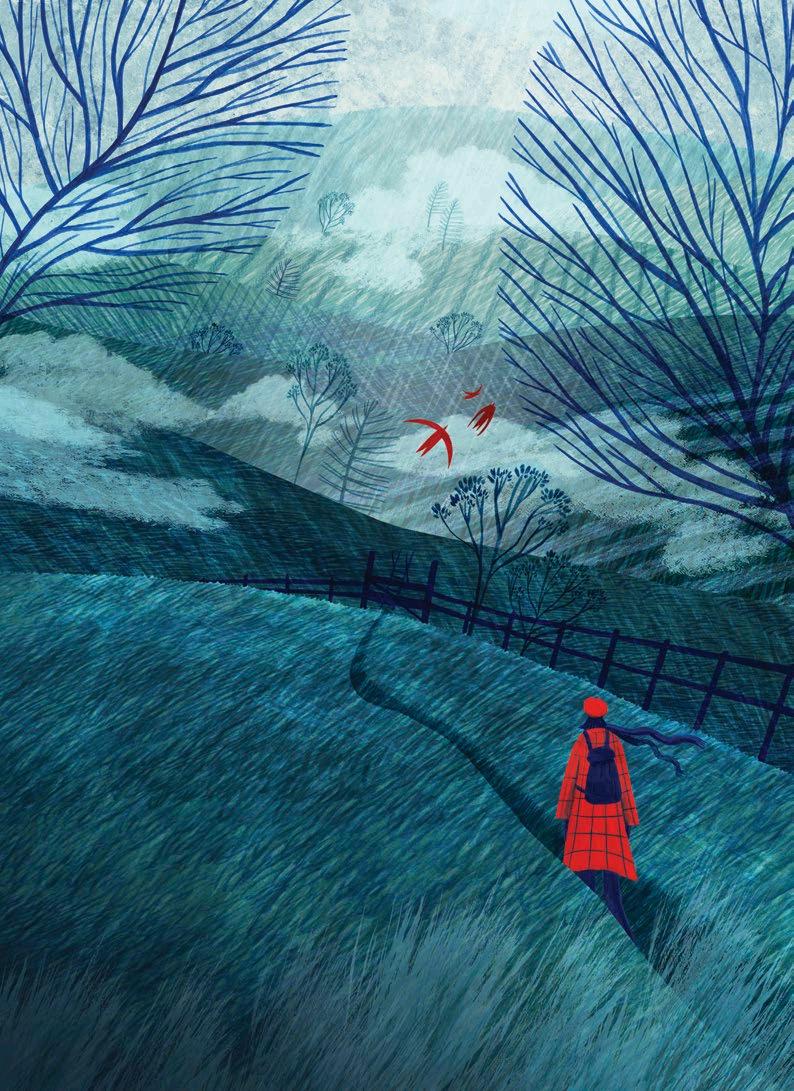
HEALTH • MONEY • TRAVEL • RECIPES • FASHION • TECHNOLOGY READER’S DIGEST | SMALL AND PERFECTLY INFORMED | FEBRUARY 2021 FEBRUARY 2021 FEBRUARY 2021 £3.99 readersdigest.co.uk
6
The Crisis Facing Our Care Homes THE NURSING HOMES SCANDAL WINTER HEALTH WOES And How To Overcome Them
CALL OF THE WILD Bringing Wolves, Bison And Vultures Back To Europe SHAKIN’ STEVENS The Chart Star On His Cardiff Childhood
Features
16 IT’S A MANN’S WORLD
Olly Mann on the joys of “date nights” and taking a break from the kids
ENTERTAINMENT
20 INTERVIEW:
ELLEN BURSTYN
The iconic Exorcist actress opens up about her remarkable life, career and latest project
28 “I REMEMBER”: SHAKIN’ STEVENS
UK’s biggest-selling singles artist of the 1980s looks back on Glastonbury, Top of the Pops and playing Elvis
HEALTH
38 WHAT’S WRONG WITH OUR NURSING HOMES?
The mounting troubles looming over seniors’ care homes all over Europe
INSPIRE
56 MAKE ME DISAPPEAR! Meet the woman who helps people in abusive relationships to vanish


64 MY BRITAIN: DUNDEE
Two residents on what it’s like to live in “the coolest little city in Britain”
74 DEATH, IMMORTALISED
How the seemingly morbid genre of “death photography” helps people grieve
82
REWILDING EUROPE
Joey Tyson meets the people dedicating their lives to returning European land to its natural state
2021 FEBRUARY 2021 • 1
Contents FEBRUARY
p64 p20 cover illustration by Rosanna Tasker






River Cruise Holidays Rediscover in the Severn Vale FREE BROCHURE - Call 01452 410411 E N G L I S H H O L I D A Y C R U I S E S . C O . U K S e r e n e & S e c u r e S a i l i n g 2 - 6 N i g h t C r u i s e s D a i l y T o u r s I n c l u d e d T r a d i t i o n a l E n g l i s h M e n u T w i n e n - s u i t e C a b i n s A l l I n c l u s i v e P a c k a g e D e p o s i t s P r o t e c t e d 5 S t a r R e v i e w s England "You couldn't have felt safer...highly recommended!" - 2020 Passenger

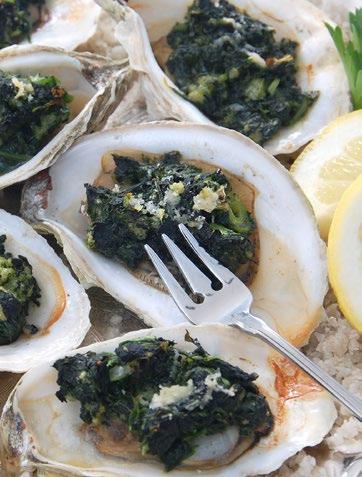
FEBRUARY 2021 • 3 8 Over to You 12 See the World Differently HEALTH 46 Advice: Susannah Hickling 50 Column: Dr Max Pemberton INSPIRE 70 If I Ruled the World: Monica Dolan TRAVEL & ADVENTURE 98 My Great Escape 100 Hidden Gems: Portugal MONEY 102 Column: Andy Webb FOOD & DRINK 106 A Taste of Home 108 World Kitchen: USA DIY 110 Column: Cassie Pryce ENVIRONMENT 112 Column: Jessica Lone Summers FASHION & BEAUTY 114 Column: Lisa Lennkh’s Fashion Tips 116 Beauty ENTERTAINMENT 118 February’s Cultural Highlights BOOKS 122 February Fiction: James Walton’s Recommended Reads 127 Books That Changed My Life: CJ Tudor TECHNOLOGY 128 Column: James O’Malley FUN & GAMES 130 You Couldn’t Make It Up 133 Word Power 136 Brain Teasers 140 Laugh! 143 60-Second Stand-Up 144 Beat the Cartoonist
p108 Contents FEBRUARY 2021 p106
In every issue
We promise we’ll never put down a healthy dog

Please promise to help us with a gif t in your Will
Every year, Dogs Trust cares for over 15,000 dogs in our 20 rehoming centres across the UK. We never put down a healthy dog. By leaving a gift in your Will, your love of dogs can live on and help us make the world a better place for them.
For more information:
email: infopack@dogstrust.org.uk or call: 020 7837 0006
Please quote “334720”, or complete this coupon:
Please send me my free legacy information pack (Please fill out in block capitals)
For more information email: infopack@dogstrust.org.uk or call: 020 7837 0006
Please quote “334717” or complete this coupon:
Mr/Mrs/Miss/Ms/Other Address Postcode 334720 Registered charity numbers: 227523 & SC037843 A dog is for life® dogstrust.org.uk
time to time
like
exciting updates about our work, products, services
how
can
research by post. If you’d rather not receive
mailings, please tick here In order to communicate with you
effectively, better understand your preferences and ability to support
work,
may analyse
data. We do share
information within the Dogs Trust Group; currently Dogs Trust Worldwide, Dogs Trust Ireland and Dogs Trust Promotions. To read our full privacy policy visit dogstrust.org.uk/privacy Please send this coupon to: Freepost RTJE-SXGL-BEEJ, Dogs Trust, Moulton House, 10 Pond Wood Close, Northampton, NN3 6DF (No stamp required) © Dogs Trust 2020
From
we would
to send you
and
you
support us, including fundraising activities and
these
more
our
we
your
your
SENIOR EDITORS Anna Walker, Eva Mackevic
EDITORIAL ASSISTANT Jessica Lone Summers
ART DIRECTOR Richard Cooke
ADVERTISING Jigs Pankhania
MARKETING Sarah Hughes
HEAD OF FINANCE Santwana Singh
FINANCE MANAGER Irving Efren
MANAGING DIRECTOR Julie Leach
CHAIRMAN Gary Hopkins
subscriber enquiries, please
WE PAY...
£50 for the star letter and £30 for regular letters.
Email readersletters@readers digest.co.uk or go to readers digest.co.uk/contact-us
WE ALSO PAY...
£30 for the true stories, anecdotes, jokes in Laugh! and You Couldn’t Make It Up…, and contributions to end-ofarticle fillers and My Great Escape.
Email excerpts@readersdigest.co.uk or go to readersdigest.co.uk/contact-us
SORRY!
We cannot acknowledge or return unpublished items or unsolicited article-length manuscripts. Do not send SAEs. Article-length stories, poetry and cartoons are not requested.

TRUSTED MEDIA BRANDS INC (USA)
President and Chief Executive Officer
Bonnie Kintzer
Editor-in-Chief, International Magazines
Raimo Moysa
number below
CUSTOMER SERVICES
Contact Customer Services for renewals, gifts, address changes, payments, account information and all other enquiries. Call 0330 333 2220* or email customer_service@readersdigest.co.uk
TALKING MAGAZINES
Reader’s Digest is also available in audio and accessible etext editions from RNIB Newsagent, for blind and partially sighted readers. Call the RNIB Helpline on 0303 123 9999 or visit rnib.org.uk/newsagent
SUBSCRIPTIONS
Annual subscriptions are available to be delivered monthly direct to your door. For our latest offers please visit readersdigest.co.uk/subscribe Or telephone us today on 01778 392461
Gift subscriptions also available. UK rates may vary. Overseas rates: Republic of Ireland €50, Rest of the World €60.
*Calls to 03 numbers cost no more than a national rate call to an 01 or 02 number and will be free if you have inclusive minutes from any type of line including mobile, BT or other fixed line PAPER FROM SUSTAINABLE FORESTS. PLEASE RECYCLE © 2017 Vivat Direct Ltd (t/a Reader’s Digest). British Reader’s Digest is published by Vivat Direct Ltd, 57 Margaret Street, London W1W 8SJ. All rights reserved throughout the world. Reproduction in any manner, in whole or part, in English or other languages, is prohibited. Reader’s Digest is a trademark owned and under license from Trusted Media Brands, Inc, and is registered with the United States Patent and Trademark Office. All rights reserved. Printed by Pindar Scarborough Limited. Newstrade distribution by Seymour Distribution Limited. SMALL PRINT: Ensure submissions are not previously published. Include your name, email, address and daytime phone number with all correspondence. We may edit letters and use them in all print and electronic media. Contributions used become world copyright of Vivat Direct Ltd (t/a Reader’s Digest). Reader’s Digest is a member of the Independent Press Standards Organisation (which regulates the UK’s magazine and newspaper industry). We abide by the Editors’ Code
Practice
committed
upholding the highest standards
journalism.
met those standards,
contact 0203
IPSO
Editors’ Code, contact IPSO
0300 123 2220 or visit
of
and are
to
of
If you think that we have not
please
795 8886. If we are unable to resolve your complaint, or if you would like more information about
or the
on
ipso.co.uk For all
use the customer services
WRITE TO US! SEND US YOUR STORIES, JOKES AND LETTERS OR VISIT OUR WEBSITE
5
THIS BEAUTIFUL EARTH CREATED FOR A PURPOSE

There are in the world today, many fears and anxieties for the future of humanity and of life upon earth. There is the ever present threat of war and destructive weapons. There is concern over the loss of natural habitats and natural resources. There is concern for the climate and frequency of natural disasters.
The Holy Bible is the inspired Word of the Living God. Its pages reveal that He is in control and that there is a solution to these problems. He, as the Creator, has a Purpose with the earth, which is altogether logical. The Bible reveals how it is possible to have a part in His Plan. ■


The Second Coming of Jesus Christ
The Kingdom of God
What is the Christian Hope?
The Local Secretary,

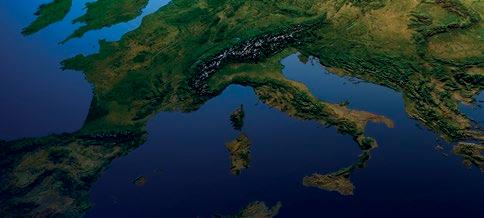


PLEASE SEND FOR FREE COPIES OF:Jesus Christ - His Life and Work
ADVERTISING CONTENT
The Household of Faith, 11, Maplebeck Road, Arnold, Nottingham. NG5 7JT
In This Issue…

February is the month of love. But rather than fill the magazine with soppy stories of dream first dates and love at first sight, we’ve opted to shine a spotlight on the many—often unusual—forms that love can take. On p74, Jessica Lone Summers speaks with families who have tragically lost their newborns, and the touching ways in which they choose to document and honour their love and bond
Meanwhile, on p56, we meet the woman who steps in when love goes wrong. Eileen Horan has made it her mission to help women to escape abusive relationships—going as far as to help them disappear entirely.
And finally, on p50, Dr Max tells the story of love after loss, and how organ donation can provide a sense of comfort in moments of our deepest grief.


Along with unusual love, nature is also at the forefront of this month’s issue. On p82, Joey Tyson meets the people dedicating their lives to returning European land to its natural state, from reintroducing bison in Kent to bringing wild wolves back to Italy.
And then, we venture some 4,000 miles west, to the Land of the Midnight Sun, Alaska. A wintry wonderland of snow, breathtaking wildlife right on your doorstep and some of the world’s finest seafood, Alaska has more coastline than the 48 continental states put together, the tallest peak in North America, active volcanoes and glaciers, and 3 million lakes. Discover the untamed beauty of this US state on p90 and, if you get a bit chilly, warm up with a bowl of delicious curry—Anjum Sethia has a brilliant recipe for you on p106.
Anna Eva
FOLLOW US

FEBRUARY 2021 • 7
EDITORS’ LETTERS
You can also sign up to our newsletter at readersdigest.co.uk Reader’sDigestis published in 27 editions in 11 languages facebook.com/readersdigestuk twitter.com/readersdigestuk @readersdigest_uk












Over To You
LETTERS ON THE December ISSUE
We pay £50 for Letter of the Month and £30 for all others
LETTER OF THE MONTH
The article about news struck a chord. It seems most of the news is doom-laden, and, being so repetitive, can be disconcerting. Could it be part of the reason for the increase in mental issues? One listens to the same items time and time again. Often folk only tune in to one or two sources and therefore may even receive a biased view.

GET LIT(ERATE)
A friend once said, “If you don’t want to be downcast, only watch the news once a day.”
I get a daily newspaper for a fuller read early each morning and only tune into the 10pm evening news programme.
That way I can mentally accommodate the information given and react [or not] as I see necessary. Often the need will be prayer.
The one thing the coronavirus news has proved is that folk need to source their information from more than one news reporter as broadcasters/publishers can use figures to read what they want to tell us, while another will have different views on the same set of figures. We need to question what we are told, not just blindly accept it. If we do that, then I am sure the news will not seem so bad.
MARTIN B DYMOND, Somerset
I was shocked to read in Konnie Huq’s “If I Ruled The World “ that not all schools in this country have a library, yet by law all UK prisons have to provide a library! I have always been an avid reader and in school in the 1970s I spent as much time as possible searching the library shelves to find my favourite Enid Blyton books. In fact, when I grew up I wanted to be a librarian or one of Charlie’s Angels!
I now work part time as a teaching assistant in a local junior school and the most enjoyable part of my job is encouraging the children to read and enjoy books. I’ve almost achieved my schoolgirl ambition too as I sometimes take a class to the library to work or borrow books and act as the librarian “shushing” them whilst scanning their books!
I thoroughly agree with Konnie that all schools should have a library as studies have shown that the more children read, the further they go in life.
MELANIE LODGE, Yorkshire
FEBRUARY 2021 • 9
INFORMATION OVERLOAD In our social media age, we have constant access to news cycles, accessing global information at the touch of a button. But what effect is this constant connection having on our mental health? Shahed Ezaydi investigates
PHOTO LOVE

I enjoyed David Bailey’s, “I Remember”. Of course David is best known for his images of celebrities, models and musicians but it’s clear there is more to him than taking photos of the rich and famous. My daughter is a professional photographer who says it’s not a labour of love, but a love of labour. The photography equipment weighs a lot. She inwardly groans every time someone says to her, “Fantastic shot. You must have a nice camera”.
The good thing is demand is growing for photographers. Social media and the world of branded content has made this a priority for nearly every company on earth. They’re in a rapidly growing field, with plenty of work to go around.
Incidentally, when I was younger I modelled sometimes with my son when he was under three. We had our photo taken by David for an advert. They did not use mine but I still treasure one copy which I keep in a frame and tell everybody it was taken by David Bailey!
GEENA COOPER, London
LOVE OF TRADITION
Julie Olum’s article in the December issue took me back to my birth place, Nairobi Kenya, and some fabulous memories of that country and the Masai tribe. I grew up in Nairobi and at the age of 12, my family and I emigrated to UK in 1967.
I have visited Kenya twice in 1997 and 2014 and on both occasions went on safari in the Rift Valley and was so pleased to witness the Masai still maintaining their traditional way of life. Many of the Masai young generation have acquired a good level of education and relocated to the capital Nairobi and other industrial towns to seek employment and improved lifestyle but it was pleasing to witness the older generation retaining the traditional way of living.
Worldwide, many indigenous tribes are disappearing with loss of their cultures, but the Masai of East Africa appear to be holding on to their traditions and long may they retain it for future generations.
MOHAN PARMAR , Chesterfield
Send letters to readersletters@readersdigest.co.uk Include your full name, address, email and daytime phone number. We may edit letters and use them in all print and electronic media WE WANT TO HEAR FROM YOU!
10 • FEBRUARY 2021
©DAVID BAILEY
Open minded advances in healthcare from wellness innovators Medicaleaf

Over 200 million people in the UK and mainland Europe su er from debilitating chronic pain, seizures and sleeping disorders as well as an equal number of increasingly enlightened people who can appreciate the recuperative benefit of cannabinoids.
There is a clear movement away from the ‘traditional’ medical practitioners and pharmaceutical companies and we aim to provide trusted and licensed products that can be bought legally and administered safely.
Public awareness and open-mindedness towards alternative cures for lifelong conditions are growing; and the World Health Organization (WHO) reports research suggesting that CBD may have therapeutic benefits for many conditions, including:
Research is ongoing: clinical trials to test the e ectiveness of medicinal cannabis in all its forms will prove best use and lead to more government approved cannabis-based medicinal products (CBMPs) containing cannabidiol or (CBD), joining those such as Epidiolex, which is already available on prescription in the UK for the treatment of seizures caused by two severe forms of epilepsy: Lennox- Gastaut syndrome and Dravet syndrome. Medicaleaf™ was founded by a team of business leaders, marketing & technology experts, scientists, caregivers and advocates who are committed to producing safe, reliable products and promoting wellness from nature.
The widening interest in ‘wellness’ as an alternative, preventative lifestyle, particularly in

• Multiple sclerosis;
• Arthritis;
• Spinal cord injury;
• Epileptic seizures;
• Alzheimer’s disease;
• Parkinson’s disease;
• Huntington’s disease;
• Hypoxic-ischemic injury;
• Chronic and acute pain;
• Psychosis;
• Nausea;
• Inflammatory diseases;
• Rheumatoid arthritis;
• Inflammatory bowel disease;
• Cardiovascular disease; and
• Diabetic complications.
these times, fuels our fire. As an organisation, we are committed to creating a business that will assist in the alleviation of pain and su ering and collaboratively create products to assist in better wellbeing and healthier living.
Medicaleaf expects to see its valuation increase five fold before floatation in three years’ time. Medicaleaf is looking to complete their £10 million initial investment by the year end.
Capital raised will be invested in Product Manufacturing, Sales and Marketing campaigns and distribution infrastructure but will also be used for suitable acquisitions and joint ventures that will catapult the growth of the company in suitable strategic moves.

Find Out More about how you can get involved and profit from the £135B European Health and Wellbeing market. www.medicaleaf.org.uk

12
Photo: © Zoonar Gmb h / a lamy Stock Photo

THE WORLD... turn the page
SEE

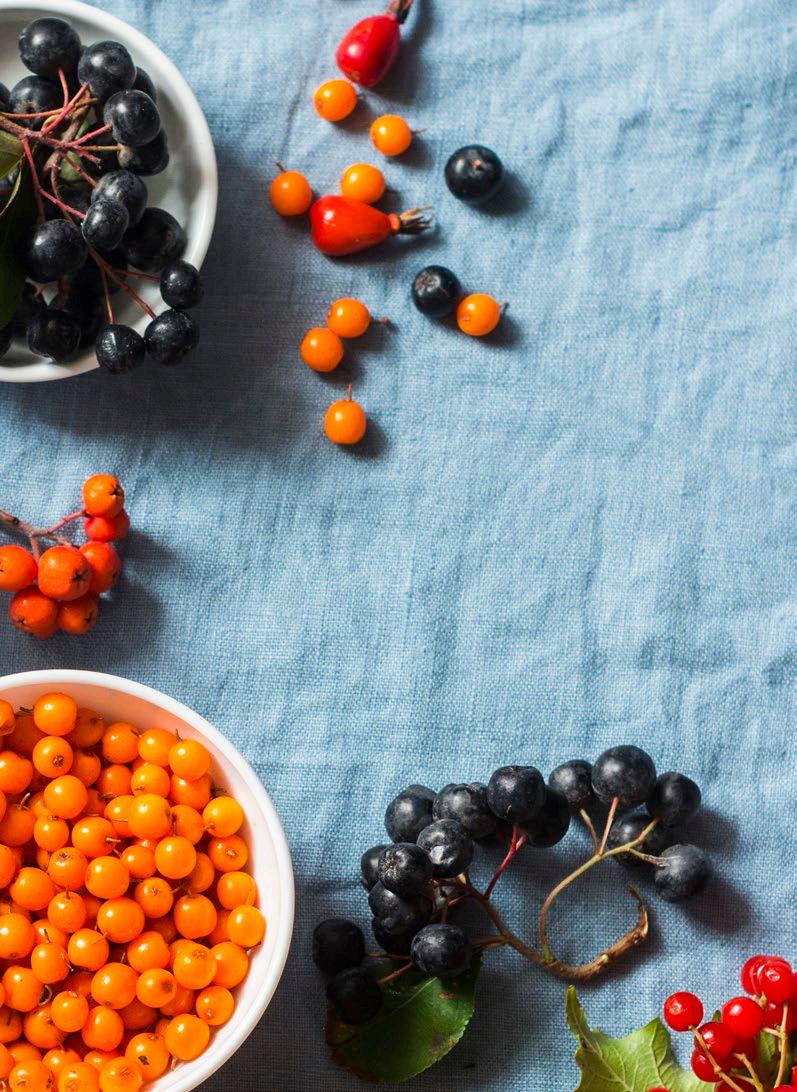
…DIFFERENTLY
Polarised light waves, or light that vibrates only in one direction, brings the inner structures of crystalised substances to a spectacular glow— as the vitamin C in the photo on the previous spread. The tiny crystals magnified under a microscope reveal the iridescent play of colours, more resembling abstract artwork than something you would expect to find in nature. Vitamin C itself is essential for survival, and can be found in sea buckthorn (Hippophae rhamnoides), blackcurrant (Ribes nigrum) and dog rose (rosa canina). The highest concentration in edible plants, however, can be found in the Australian Kakadu plum (Terminalia ferdinandiana).
Photo: © Getty Ima G e S / o k S ana kII an
15
Call The Babysitter
Olly Mann on the joys of "date nights" and the importance of spending some time away from the kids
One night, before we had children, my wife and I went to the theatre.
We invited along two couples who had recently become parents, and all met up in the bar beforehand. As we prudently sipped from our plastic tumblers of pricey white wine, our companions ordered double G&Ts, toasted "FREEDOM!", and slammed their empty glasses down on the bar. It was as if they were doing tequila shots at 2am in a dive bar. At 6pm on the South Bank.
The memory sticks in my mind because, at the time, I found our

Olly Mann presents Four Thought for BBC Radio 4, and the award-winning podcasts The Modern Mann and Answer Me This!
friends’ behaviour embarrassing, and, frankly, a little sad. Why did the opportunity to leave their children behind for the night merit such celebratory liver-pickling? (they had further double-shots in the interval, and yet more after the curtain call.) Since they seemed so keen to abandon their offspring, I harrumphed, perhaps they shouldn’t have birthed them in the first place! Fast-forward six years and, with two young children at my feet, I can RELATE. A day out with the kids certainly brings its own kind of joy, but traipsing around an "activity farm" with a toddler on your shoulders, a helium balloon in one hand and a buggy in the other, milkshake down your trousers and a hole in your wallet, whilst your five year-old has a sugar tantrum because he isn’t allowed another
illustration by Daniel
Mitchell
16 • FEBRUARY 2021 IT’S A MANN’S WORLD

Fruit Shoot… well, it’s not exactly me-time.
Dining out is even worse. My sons behave impeccably at McDonald’s, or down the greasy spoon—but somehow, the very moment we step into a gastropub, tempers fray and fights begin. Once we’ve finally got them to sit down and shut up, our main course arrives, and, invariably, one of them will need a poo.
When you’re the parent of young children, opportunities to do grown-up things with other grownups—specifically your other half—do not often present themselves. You have to make them happen. Which is why, that night at the theatre, our mates had embraced our invitation so wholeheartedly. We’d given them permission to spend a night out with friends, so they’d put the date in their diaries, hired babysitters and gone hell for leather on hedonism— even though the show was, bizarrely, an immersive musical about Imelda Marcos—because they realised the next such occasion could be many months away.
Pre-fatherhood, I was also sniffy about "date nights". By diarising a simple night out, I reasoned, couples were surely putting too much pressure on one evening,
removing valuable spontaneity, and even inadvertently projecting the vulnerability of their relationship for the world to see. But now I understand that, if it’s going to cost you £40 in babysitting fees to go and see a movie, it had better be a film you both really want to see, and the cinema had better have damn comfortable seats. Booking a table in a nice restaurant afterwards is simple common sense.
Indeed, for the past year or so, my wife and I have been venturing out on monthly date nights (or, at least, trying to—coronavirus restrictions have scuppered a few bookings). It’s remarkable, the extent to which a few hours away in an adult environment—where we don’t have to do the cooking, or change any nappies—has helped remind us that our marriage should be anchored in OUR relationship, rather than our relationship with our children. Even getting dressed up for the evening is a surprisingly pleasurable ritual these days, due to its rarity. And, because our dining out occurs less frequently than in our pre-parenting era, our budget extends that much further: I’ll willingly splash out on posher

18 • FEBRUARY 2021 IT’S A MANN’S WORLD
places, and cocktails, and car parks. I’ve even learned to suppress my resentment of having to tip the cloakroom attendant.
Mind you, at first it was a challenge to find appropriate childcare. All we required was someone who could sit in our house and watch telly as our two children slept, yet someone who was also experienced enough to deal with the consequences should our youngest son wake up and scream the house down.
We posted a request on our local Facebook parenting group (the oracle!), and were referred to a lady who was frankly overqualified: a teaching assistant from the primary school, who charged accordingly. Next, we tried our 14 year-old neighbour, and had the
opposite problem: she was only £5 an hour, but understandably overwhelmed when my son woke up and threw up over her. We had to come dashing back from our "dining pods" midway through our Salmon en Croute! Nightmare.
Then, Mum volunteered to do it. I don’t know why it hadn’t occurred to me to ask her, since she only lives ten minutes away. Presumably the request seemed cruel: “Hey, widow who lives alone, would you like to come and sit in our property, under specific orders not to wake your grandchildren, whilst we vacate the village?” But she’s been only too pleased to do it, and, really, it’s been a Godsend.
Next time, who knows, we might even get a taxi and order double G&Ts. FREEDOM! n
Natural Urges
When two lovers stare into each other's eyes, their heart rates will begin to synchronise. Researchers analysed 32 couples sat opposite each other for three minutes and found that their heart rates were nearly identical.
Cuddlingisgoodforyou.Cuddlesreleasethehormoneoxytocinwhichincreases moodandsenseofwellbeing.Thesamehormoneisalsoresponsibleforreducing stress levels.
Love can help you to heal faster. Researchers at Ohio State University gave a set of couples blister wounds, and found that married couples with a close bond healed twice as fast as those who were openly aggressive to each other.
Source: bestlifeonline.com/love-facts
FEBRUARY 2021 • 19 READER’S DIGEST
Ellen Burstyn
On Family, Fighting Loneliness And Old Friends
by James Mottram
Hollywood legend, Ellen Burstyn, takes us on a journey through womanhood, what grief can teach us and how the industry is changing
Ellen Burstyn is sitting at her computer, wearing a cherry-red polo-neck and white earphones.
It’s December and the acclaimed actress is in New York, “where it’s snowing rather prettily”. These past few weeks of lockdown have been tough on her.
“I’ve been in my apartment and taking a walk every day for about an hour,” she says. “And I found that to be very important, getting out.” Now it’s too cold, and she’s wary of contracting bronchitis.
“So now I’m housebound, a little stir crazy. And I would say nuts!”
Burstyn has just turned 88, although—aside from her silvery bobbed hair—you wouldn’t know it.
This is a woman who started acting in the late 1950s and just hasn’t stopped, working on such classics as The Exorcist, Alice Doesn’t Live Here Anymore and Requiem for a Dream. So it’s no surprise she’s missing the immediate community a theatre troop or a movie set gives an actor. As if to demonstrate this, she recalls one recent Saturday afternoon trip to the park.
“At one point a frisbee came over the fence and landed near me and I picked it up and I handed it to the girl over the fence. And she said, ‘Thank you.’ And in that moment, my spirit lifted. I thought, Ah, human contact is all I needed and I felt useful. I returned a frisbee, there was a reason why I was on planet Earth.
MEDIAPUNCH INC / ALAMY STOCK PHOTO 20 • FEBRUARY 2021 ENTERTAINMENT

21
Ellen Burstyn attends the Rocketman New York Premiere in 2019
So that became a great teaching moment to me: that when we feel lonely and isolated and slightly kooky, just find a way to be useful to somebody.”
It’s good advice from Burstyn, who is an elegant raconteur, whether
“WHEN YOU FEEL LONELY, FIND A WAY TO BE USEFUL TO SOMEBODY”
she’s talking about Al Pacino or frisbees. We’re speaking over Zoom about her latest film, the searing Netflix drama, Pieces of a Woman.
Burstyn plays Elizabeth, the wellto-do mother of a newly-married woman (Vanessa Kirby) who loses her baby after a traumatic home birth. It’s a harrowing-but-hopeful study of grief and how individuals must tackle devastating emotional loss in their own way.
Burstyn only knew Kirby from her most famous role—as Princess Margaret in The Crown.

EVERETT COLLECTION INC / ALAMY STOCK PHOTO 22
Ellen Burstyn in The Exorcist (1973) and Alice Doesn’t Live Here Anymore (1974)
“I was so impressed with her,” she says. Already her co-star won Best Actress at the Venice Film Festival for Pieces. Can she win an Oscar too?
“I certainly hope so. She has some stiff competition. But I certainly think she’ll get a nomination. And I certainly think she is deserving to win.” If she does, you’d hope Kirby thanks Burstyn, who offers a fiery turn as the ultra-controlling mother.
“One of the things that I think that film says—which is very important— is that everybody grieves differently. Everybody has to be allowed their
own grief process,” says Burstyn. “I know I’ve gone through deep grief. And I was surprised by the things I learned from it.”
She’s talking about her younger brother Steve, who died of cancer, aged 70. They were extremely close, right from childhood. When he was born, their mother was bedridden for eight months and Burstyn looked after him.
On the first anniversary of his death, Burstyn staged a ceremony suggested by a friend, a Native American tradition—make a feast

READER’S DIGEST AF ARCHIVE / ALAMY STOCK PHOTO
for the departed, eat the food and throw his plate into the fire. Another friend quoted Oscar Wilde to her: “The mystery of love is greater than the mystery of death.” Burstyn was struck. “When she said that, I said, ‘Yes, and I will love my brother every day of my life.’ I realised in that moment that when you lose someone, you only lose their body, that their love doesn’t go away. And that you carry the person in you. They’re alive in you. I can still feel my brother, I can still talk to him. I hear his answers inside me.”
Listening to Burstyn talk so candidly about such a private matter is hugely moving, a strong lesson in how to confront the deep recess of emotion that is grief.
“It’s a learning experience, a learning experience you probably don’t want, but it is the deepening,” she adds. “I always say you don’t really know who you are until you’ve experienced grief because you go into the depths of yourself that you don’t go to in any other way for any other reason, and so in its own sad way, it’s very enlightening.”
 Vanessa Kirby and Ellen Burstyn in Pieces of A Woman
Vanessa Kirby and Ellen Burstyn in Pieces of A Woman
INTERVIEW: ELLEN BURSTYN
24
Born Edna Rae Gillooly in Detroit, Michigan, Burstyn was raised by her mother after her parents divorced.
“My mother was married four times,” she says, calling her family relations “difficult” and her mother “a character”. What about acting— did her mother approve? “I don’t know,” she shrugs. “I remember at one point, around high school, I said something to my mother about wanting to be an actress, and she said, ‘Take a good commercial course. So you have something to fall back on when you fall on your
butt.’ Hardly encouraging.”
She left home as soon as she turned 18 and got a job working as a dancer in a nightclub chorus line, before turning to modelling and then acting.
“But really what I wanted, what
“YOU DON’T REALLY KNOW WHO YOU ARE UNTIL YOU’VE EXPERIENCED GRIEF”
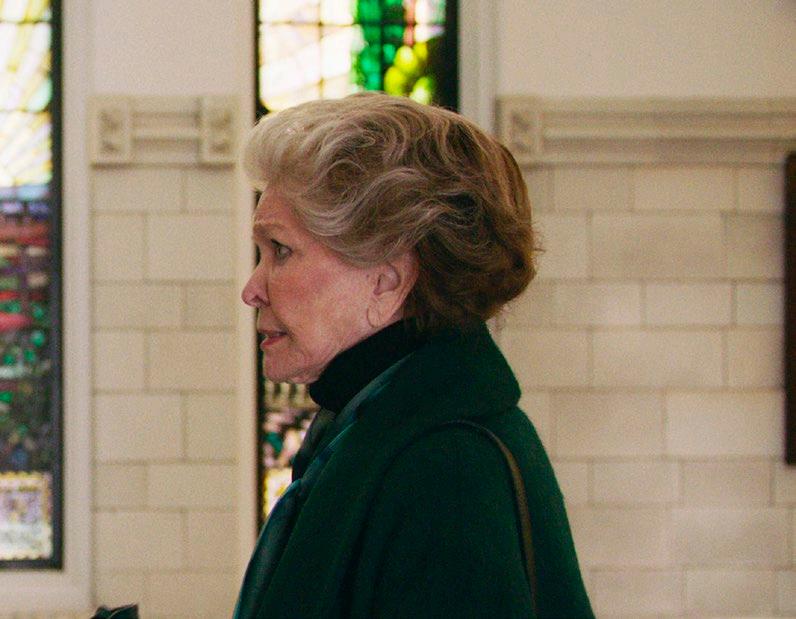
READER’S DIGEST
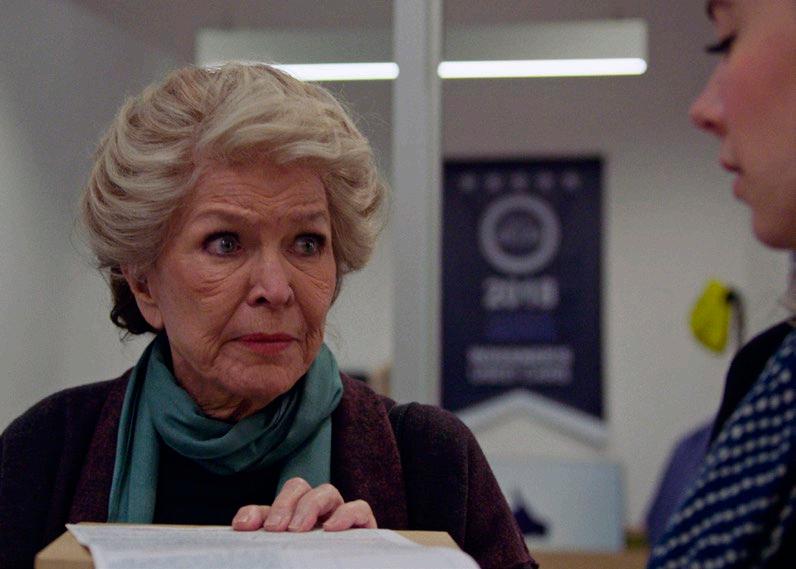
my ambition was, was to see the world. And I’m so glad that I had that ambition, because I have seen an awful lot of the world. And it’s been so enriching for me to see the most exotic places, and how people live that are totally different. It helps you to see that your way of life is just one way of life.”
By the time she was 30, she had been married and divorced twice (adopting a son, Jefferson, with her second husband, Paul Roberts). Her third husband, actor Neil Burstyn, provided her stage name. They divorced in 1972, and—as she revealed in her autobiography Lessons in Becoming Myself—he
stalked her for six years afterwards. He even burst in her apartment one night, assaulting her, but the police dismissed it, as “spousal rape” was yet to be classified as a crime.
At this point, Burstyn was a major star, winning a Tony Award for her performance in 1975’s Same Time, Next Year and an Oscar for Alice Doesn’t Live Here Anymore. The Exorcist had given her cachet, and she used it to bring Martin Scorsese—then only really known for his small-time hoodlum tale Mean Streets—onto Alice.
“I said, ‘I want this film made from a woman’s point of view. And judging by Mean Streets, I can’t tell
26 • FEBRUARY 2021
Ellen Burstyn as Elizabeth in Pieces of A Woman
if you know anything about women. Do you?’ And Marty immediately said, ‘No, but I’d like to learn!’”
Around this time, in her forties, Burstyn began to look after herself, stopping drinking and smoking and started exercising. She also stayed “active intellectually”, she says, by reading voraciously. When we meet, she’s been working her way through Sapiens: A Brief History of Humankind by Yuval Noah Harari. “Great book,” she trills, before telling me about the intimate connections between humans and chimpanzees. With such curiosity, it’s not hard to see why she’s still seeking out new roles.
never saw a black person on the set unless it was an actor. You never saw a woman on set except as an actress.” She sighs. “It’s slow. But we have so much more work to do. But in the 60 years I’ve been in the business, I see the progress in the country reflected on the set.”
A loyal Democrat, is she relieved that Joe Biden won the presidential race after four years of Trump?
“Oh, my God. Yes. I just want to get him inaugurated, please. I’ll be able to breathe more easily, once Biden is inaugurated. And I really think things will improve then.”
“THROUGH 60 YEARS IN THE BUSINESS I SEE PROGRESS ON SET”
I wonder if Burstyn has seen progressive changes in Hollywood over the years. “There are more films now, written by women, directed by women, produced by women and about women. And that’s a good thing. And now the same kind of energy is in the movement to have films made by black directors, people of colour.” She notes that her hairand-makeup team on Three Months, a coming-of-age gay story she shot in Atlanta during lockdown, were all African-American.
“When I started in the business you
In the meantime, Burstyn is keeping busy. She’s still connected to drama institution The Actor’s Studio, as copresident along with Alec Baldwin and the “divine” Al Pacino, whom she interviewed in 2019 for a special episode of Inside the Actors Studio.
“He’s unique. There’s nobody like Al.” They’ve never worked together, “which saddens me deeply,” she says. Maybe she, Pacino and Scorsese should make a movie, I say.
“Oh, that’s a very good idea,” she laughs. “I’ll suggest it!” You heard it here first. n
Pieces of a Woman is available on Netflix now
FEBRUARY 2021 • 27
READER’S DIGEST

28 ENTERTAINMENT


I REMEMBER… Shakin' Stevens
Shaky was the UK's biggest-selling singles artist of the 1980s. Still charting each year with his Christmas classic, Merry Christmas Everyone, the Welsh singer shares his memories of an incredible career…
…THE HOME I GREW UP IN WAS VERY SMALL. It had three tiny bedrooms and was in the Cardiff suburb of Ely. I was the youngest of 13 children, and eight of us shared one box room and small bedroom. They were so small there was no space for a wardrobe. You hung your clothes on the back of the door.
…WE ALL SANG IN THE HOUSE. We all had good voices in my family
and I was singing from an early age. Although I was born in 1948, there are 25 years between me and my eldest brother, and so the house was full of records from the 1930s to the 1960s.
I grew up listening to a wider range of music than my contemporaries. People like the great early country singer Jimmie Rodgers, Joe Turner, the Big Bopper and Little Richard.
FEBRUARY 2021 • 29


…ONE OF MY FIRST BANDS WAS CALLED THE DENIMS. I wasn’t wearing the denim that became my later look then, so what a coincidence that was! We played school halls and weddings. We never made any records, but we did at play the famous 2i's Coffee Bar in Soho where Tommy Steele and Cliff Richard had performed a decade
Starring in the musical Elvis; Shaky in an early teenage band
earlier. This was in about 1964. We were on for an hour and a half and got paid £4.
…DOING LOTS OF JOBS BEFORE
I TURNED PROFESSIONAL MUSICIAN. I left school at 15 and worked on building sites and in warehouses, did window cleaning and was an apprentice upholsterer, which I liked because I was learning a trade. I’d be doing that during the day and the gigs at night. Hard work, but you get back what you put in. Finally, in 1969, I was able to pack it all in and concentrate on music full-time.
I REMEMBER… 30 • FEBRUARY 2021


READER’S DIGEST FEBRUARY 2021 • 31

Shaky in the 1980s
…HOW I GOT THE NAME SHAKIN’ STEVENS. I was born Michael Barratt. I’ve always respected the name my mother gave me, but it isn’t very rock ‘n’ roll. As a kid messing about in the street, I had this friend Steven Vanderwalker. He’d stand there holding a cricket bat, pretending it was a guitar and, just before I’d sing, he’d shout, “Ladies and gentlemen… Shakin’Stevens!" Well, I remembered that and decided to adopt it as my stage name. I’m glad I did because it stood out, a bit like those old blues artists such as Muddy Waters and Lazy Lester. It's

Shaky in conversation and Shakin’ Stevens on the records.
…JOHNNY ROTTEN SAID SHAKIN’ STEVENS AND THE SUNSETS
WERE A GREAT BAND. That was my band from 1969 to 1976. We were on the major label Parlophone for one album and often performed on the same bill as the punk bands. We were very wild. I’d climb up the lighting stacks and curtains, and jump on the piano. The sax player tossed his instrument up in the air—it would twist and drop, and he’d catch it above his nose. It’s all
I REMEMBER… 32 • FEBRUARY 2021
right doing talent shows but there is nothing like going out on the road and paying your dues as a live performer.
…JACK GOOD CHOSE ME TO PLAY ELVIS ON THE WEST END STAGE.
By 1976, I’d gone as far as I could with The Sunsets. But when Jack Good, who’d produced the pioneering TV rock programme Oh Boy! in the late 1950s, saw one of our shows, he asked me to play Elvis Presley in his middle years in the London musical Elvis! I did it for 19 months and it won so many awards. Even Elvis’s old Sun Records label mate Carl Perkins, Mr Blue Suede Shoes himself, came backstage to compliment me.
…BEING VERY NERVOUS GOING ON TOP OF THE POPS
. The West End musical helped me get a record contract as a solo artist on CBS/Epic. My first chart hit was "Hot Dog" in 1980. I didn’t have a dresser or stylist then—or even now—and didn’t have a lot of money or anything to wear for that first appearance. So I rushed out and got a pair of jeans for £2 and a jacket for £5. The classic “worn” denim look came later.
…"THIS ‘OLE HOUSE" SPENT SIX MONTHS IN THE TOP 40 IN 1981. That song was my first international hit, launching my career in many countries world-wide. That and

"Green Door" were my biggest sellers, but another big seller that gave me special satisfaction was "Oh Julie", which I wrote myself. I remember saying to Geraint Watkins, who played piano on a lot of my albums, “Bring your squeezebox into the studio, I want to do something with a Cajun feel." We got pretty near it on that song.
…BECOMING FRUSTRATED WITH THE DIRECTION OF MY CAREER.
The 1980s was so heady for me. I’m told I was the best-selling singles
FEBRUARY 2021 • 33 READER’S DIGEST
artist of that decade, and I also sold a lot of albums here and overseas, but I was very naïve. My manager was more interested in the money than the music. I’d arrive at a venue and it would be laid out for kids with balloons everywhere. Totally the wrong image. I began to feel I was being denied the chance to move on with my career. My last single for CBS, "Radio" in 1992, with Roger Taylor of Queen on drums and Rod Argent, ex-Zombies, on keyboards, was a step towards the heavier sound I wanted, but after that I left the label and spent years concentrating on the live shows.
…KEEPING THE PRESS AT ARM'S LENGTH. I’ve always been a private
person. My private life is my private life. Obviously when I’m performing, I’m out there for the public. I’ll see people backstage. I don’t hide away from fans. But it can get intrusive and people don’t always appreciate how vulnerable you are.
…PLAYING GLASTONBURY IN
2008. We were due on the Pyramid Stage at midday. About half an hour before, I’d looked out and there was no-one there. I thought, Oh my God, what have I got myself into? But the time came round and when we walked out, it was packed. They were cheering, somebody in the audience had a big green door, and when I came off, Michael Eavis, the festival boss, said, “You’ve just pulled in the

I REMEMBER…
34 • FEBRUARY 2021

biggest audience for an opening act in our history!”
…MY PARTNER SUE DAVIES
SAVED MY LIFE AFTER I HAD A CARDIAC ARREST AT HOME IN BUCKS. It was in 2010. I’d not been feeling well for some time and had slightly overdone it with some heavy lifting in the garden when I collapsed.
Sue was on the phone to the doctor straight away while pumping away at my chest. She told him, “I think I’ve broken his ribs.” Eventually they got me to the local hospital in High Wycombe, but if I hadn’t had a strong woman like Sue on my side I wouldn’t be here talking about it today.
…RESEARCHING MY FAMILY’S PAST INSPIRED MY COMEBACK. Nobody in the family had told me that my ancestors had worked in horrific conditions in the Cornish tin mines or that my father had been married before. I’d been keen to make a bluesy album and the stories we uncovered led to the songs that made the 2016 album Echoes of Our Times. It put me back in the UK album Top 30 for the first time since 2005. The style was so different, a lot of people didn’t believe it was me. It was a big thrill to win acceptance in the Roots and Americana fields.
…LISTENING
TO
OVER 250 OF MY
SONGS THIS SPRING DURING THE COVID-19 LOCKDOWN. There are 266 tracks on my new anthology. We couldn’t get into the studio to listen to the remastering because of the dreaded virus, so they sent it all to me at home. It brought back many memories and I’ve done a commentary on how the songs came about. But I’m still recording new songs and one on there, "I Need You Now," is a gospel-type track. Given what the country’s been have going through, I hope people will find the lyrics comforting. n As told to Jack Watkins
Shakin’ Stevens’ 19-CD Fire in the Blood anthology, and the 3-CD Singled Out Collection are out now
READER’S DIGEST FEBRUARY 2021 • 35
The greatest autobiography
ever written isn’t Churchill’s
It’s yours
Your early life
Why? Because it’s yours
Your career
And now it can be your children’s and your grandchildren’s
Your finest hours
It’s time to tell your story
The gift of a lifetime
LifeBook is the world’s leading autobiography and memoir service, and more than 8000 people already own the life story of someone they love.
Now through 12 face-to-face or video interviews, you can tell yours and create a unique piece of family treasure. Your very own handcrafted, hardback book, to share with generations to come.

The perfect winter project
This winter it’s time to tell your story. Find out more by calling us on 0800 999 2280 or visiting lifebookuk.com
What’s Wrong With Our Nursing Homes?
A lot actually, says a Reader’s Digest report from around Europe
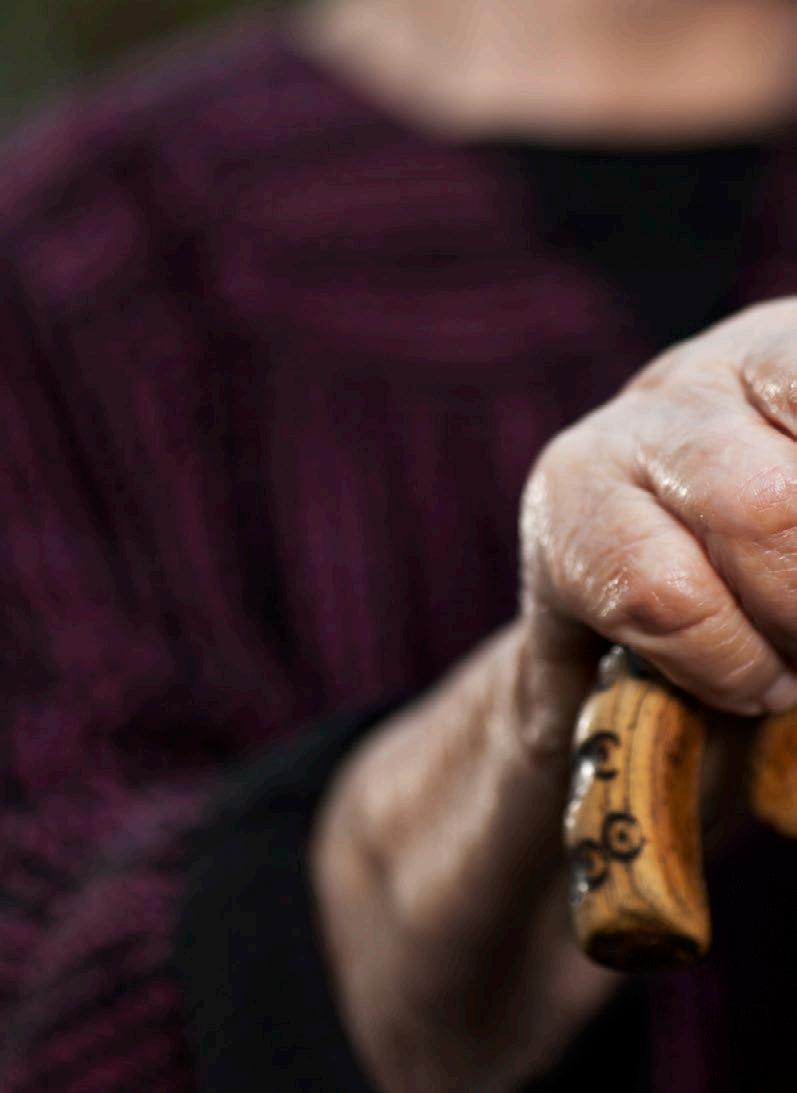 by Lisa Fitterman
by Lisa Fitterman
HEALTH

39
Petite, soft-spoken, white hair freshly coiffed, Suzanne Sastourne-Arrey does not look like a rabble rouser...
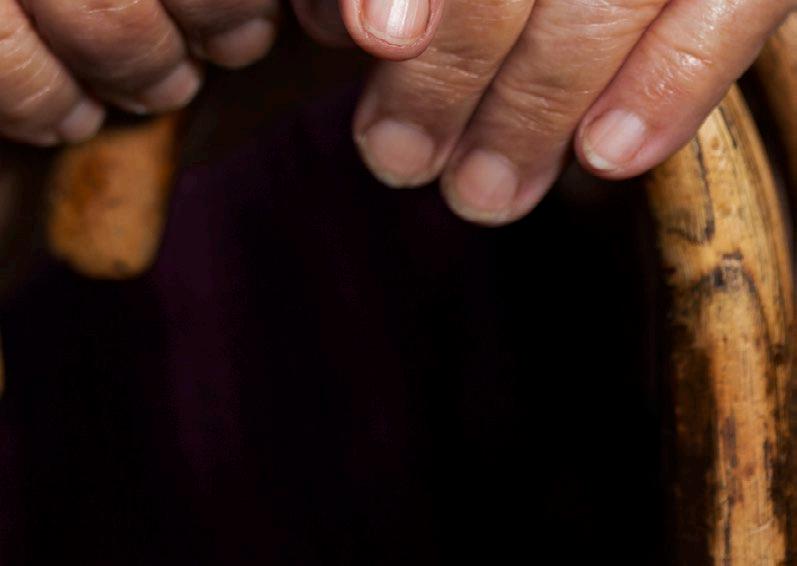
The 99-year-old spends most of her time in her little room at Les Oyats, a seniors’ residence in the picturesque French seaside town of Notre-Damede-Monts. During the day she sits on her single, black office chair, reading, doing crossword puzzles and receiving the rare visitor.
But a rabble rouser she is.
A military widow who has lived at the publicly-run Les Oyats for eight years, on July 12, 2019 she put pen to paper, writing a letter to town mayor Raoul Grondin, who chairs the regional organisation responsible for the residence’s funding.
In no uncertain terms it detailed the deteriorating conditions in
the home due to funding cuts, questionable management decisions and staff members so stressed that 15 out of 55 full-time were on medical leave. The rest were trying to respond to the needs of the 80odd residents, many of whom ended up spending days in bed. Showers were rare, and there were accidents, among them, a resident who broke her collarbone when a lone nursing aide tried to move her in her bed, a job which previously took two to do.
“This is not acceptable,” Suzanne wrote. “Sick seniors are the ones suffering the consequences.”
For her, the issue is about more than just money. Rather, it is about
40 • FEBRUARY 2 021
photo, previous spread: © a lvaro Calvo/Getty i ma G es
fundamental respect and the fact that seniors living in nursing homes throughout the continent have been discounted for years due to their age and infirmities.
“Despite my age, my mind is sharp,” she says steadily. “The staff were crying on my shoulder. I had to do what I could to make it stop.”
The letter, co-signed by a dozen other residents, was a second salvo in a campaign begun two months earlier by local doctor Marcellin Meunier, who had been in charge of medical care at the residence ever since it opened 23 years earlier. On May 5, 2019 he posted a public SOS on Facebook, stating that the home was teetering on the brink of a “human catastrophe,” with at one point just one qualified nurse caring for all of the residents, aides made to ration rubber gloves used for cleaning, bottles of disinfectant cleanser left empty to save money.
In an interview at his home, Dr Meunier explains: “Most of the residents are ailing in some way and need a lot of help. I had to speak out, no matter the consequences.”
The World Health Organisation defines elder abuse as a “single or repeated act, or lack of appropriate action, occurring within any relationship where there is an expectation of trust, which causes harm or distress to an older person.” It estimates that 15.7 per cent of

people globally aged 60 and older are subjected to abuse—with the actual number most likely higher because so many cases go unreported. The abuse may be intentional or not, and it may include stealing, assault or neglect.
According to the European Union, 19.7 per cent, or nearly one-fifth, of the continent’s population was aged 65 or older in 2018, a figure expected to increase to 31.3 per cent this year. Almost 4 million of them live in nursing homes, which can be public, private, for profit, or not for profit. The problems endemic to long-term care—a lack of funding, for example, or not enough staff and inadequate
FEBRUARY 2 021 • 41 READER’S DIGEST
Suzanne spoke out about the appalling conditions in her seniors’ residence.
photo by lisa fitterman
training—have existed across the board, festering, long before the COVID-19 pandemic placed them in stark, shameful relief. Fifty eight per cent of all the deaths due to the disease in Europe have been of people aged 80 years and more.
Seniors with heart problems, with dementia, with compromised immune systems, Type 2 diabetes and cancer have been sacrificed to serious

“An old man told me the staff negelected residents, and were sometimes cruel”
systemic failures in the care system throughout the EU for years, whether in Finland, where the ratio of homes is about 60 per cent public to 40 per cent private, Germany, where 60 per cent are not for profit (both public and private), or France, where just over half of all homes are public.
The stories will make you angry and break your heart all at once.
In April 2015, 89-year-old Paulette Godfriaux was living at the Seniorie de Carlsbourg (now called Le Bois Joli) in Paliseul, Belgium. Robbed by a stroke of her ability to
speak or even make a sound, and paralysed, she silently burned to death in a too-hot bath when the aide who placed her in the tub as it was filling up rushed off to deal with another patient before testing the temperature of the water. The aide was dismissed, but there were continued rumblings at the home of staff pushed beyond their limits.
In Finland, not one but two private elderly care homes—Esperi Care and Attendo—with 381 residences in all, have come under fire in recent years. In one Attendo facility, Finnish state authorities found 17 seniors with a body mass index so low they were at risk of dying. In another case, leftover opioid drugs which ought to have been destroyed as medical waste were instead handed out to patients, without a doctor’s order. In 16 of the nursing homes run by Esperi, reporters uncovered evidence that the authorities had demanded the company clean up its act.
In Germany, Claus Fussek, a social worker who has championed the rights of seniors in homes for three decades, is still haunted by his visit to one old man at the request of a worried friend. Upon his arrival, staff members didn’t even look up because they were too busy playing cards, while two half-naked female residents were wandering the corridor.
“The old man told me the staff neglected residents, not taking time WHAT'S
42 • FEBRUARY 2 021
WRONG WITH OUR NURSING HOMES?
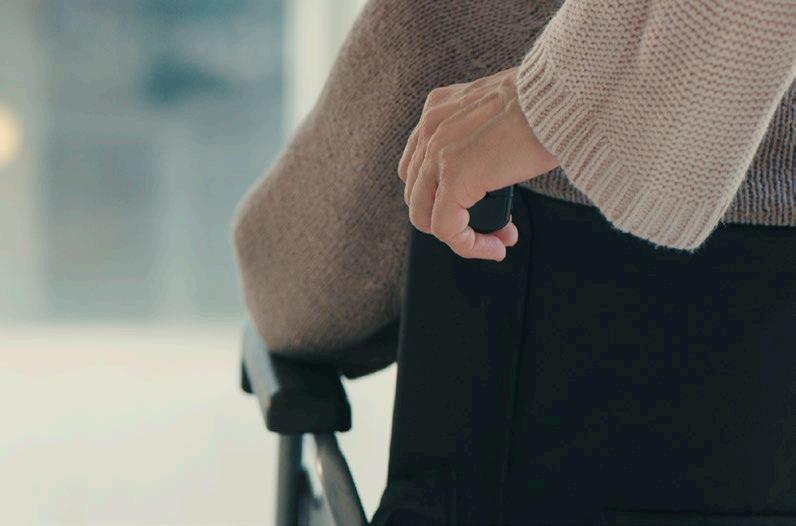
to talk and sometimes even being cruel. He said he wished he had dementia so he wouldn’t realise what was happening to him,” the social worker recalls. “I asked if he had lived in a long-term care facility before. He showed me his left arm, with a number tattooed on it. Yes, he’d been a prisoner in a concentration camp.”
In Spain, Rafael Serrano, a psychologist and entrepreneur specialising in senior care in Córdoba, cannot forgive himself for an accident at a seniors’ residence he once managed. Workers building an access ramp for wheelchairbound residents to the garden forgot to close the door leading to the construction site when they left for
the day. That night, a female resident entered the site and fell.
“We realised what had happened only the next morning. Encarnación, who was such a delight in life, died,” says Serrano. He has since created a company, Beprevent, that works to keep seniors independent in their own homes with routine monitoring.
In 2017, the European Network of National Human Rights Institutions (ENNHRI) published a study about the human rights of older people in long-term care throughout the continent. The study identified a lack of knowledge when it came to the basic rights of seniors, such as living in a safe environment, having an input into their medical care and
FEBRUARY 2 021 • 43
access to justice. These are rights we are all entitled to, but with seniors in long-term care, who may have problems expressing themselves, or fear repercussions, the issue is more complicated. In many cases, says Debbie Kohner, ENNHRI’s secretarygeneral, these rights are not known or overlooked and so are less likely to be put into practice.
“Older persons’ human rights

“Nurses and doctors need to speak out about what they see, and assume their ethical responsibilty”
are included in many international conventions but they’re not enshrined in any dedicated convention as the rights of children are,” she says.
The study looked at six EU countries: Belgium, Croatia, Germany, Hungary, Lithuania and Romania. Overall, it found that most caregivers did their best to respect patients’ dignity and independence. But the lapses were there, such as homes with unsuitably steep stairs, residents bathed at the same time
and/or transported half-naked through the corridors. A dying person left in the same room as other residents, filthy ventilation systems, heat turned off to save money.
How to respond? The report notes that it is crucial for seniors to participate whenever possible in the decisions made about their own lives, including whether or not to move into long-term care in the first place. It recommends that European states and the EU support a new human rights convention specifically for seniors.
In a 2020 speech, Agnès Buzyn, at the time the French Minister of Solidarity and Health noted that it is difficult to recruit qualified staff in the eldercare sector. “Young people should go into these professions,” she said. “They’re the professions of the future.” To that end, she continued, three areas need to be improved fast: better pay for caregivers; training and retraining in order to keep them up to date in their practice; and developing a long-term budget to care for seniors in their own homes.
Fussek, the social worker from Germany, first spoke publicly about the lack of care in nursing homes on April 27, 1997, when he held a news conference in Munich to alert the public to the phenomenon whereby many residents were admitted to hospital on Mondays, dehydrated and in a “miserable condition.”
“At weekends, there were even
44 • FEBRUARY 2 021 WHAT'S WRONG WITH OUR NURSING HOMES?
fewer staff in nursing homes.
Residents were left in their beds, unclean and in wet pads,” he recalls.
Little has changed, he charges. Too many seniors in long-term care are still dehydrated, malnourished and suffering from bedsores.
And that, Fussek says, is why there needs to be a seniors’ version of the #MeToo movement, both a reckoning and a recognition of seniors’ rights and nursing homes’ responsibilities.
“Nurses and doctors need to speak on the record about what they see every day. They must assume their ethical responsibility.
“The COVID-19 pandemic and the ban on visiting have dramatically aggravated the conditions in the homes,” Fussek explains.
Back in Notre-Dame-de-Mont’s, on June 19, 2019 Dr Meunier handed in his resignation, frustrated by the lack of response from higher-ups. Far from hiring qualified people to replace those who were on leave, instead the residence accepted another patient, thus increasing the workload of existing staff.
Two days later politicians voted to make an additional, exceptional allocation of €1.6 million for all the nursing homes for seniors in the region. Dr Meunier says that this amount is not nearly enough.
Mayor Raoul Grondin does recognise the problems that Dr Meunier and Suzanne

Sastourne-Arrey described at Les Oyats. “We’ve hired a new director who is aware of changes that need to be made,” he said in February 2020.
But he noted that the residence is not unique, not before COVID-19 and certainly not after. With rapidly ageing populations the world over, nursing homes everywhere have similar challenges and must find better ways to meet them—ways that ensure adequate funding and sufficient qualified staff, with regular training to incorporate much improved practices.
“You know, I told a little lie in my letter to the mayor,” Suzanne admits today. “I described myself as 99 years old, not 97 as I actually was then. To seem very old and still very much capable of writing something openly critical was important. Because then they wouldn’t be able to ignore the situation.” n
FEBRUARY 2 021 • 45 READER’S DIGEST
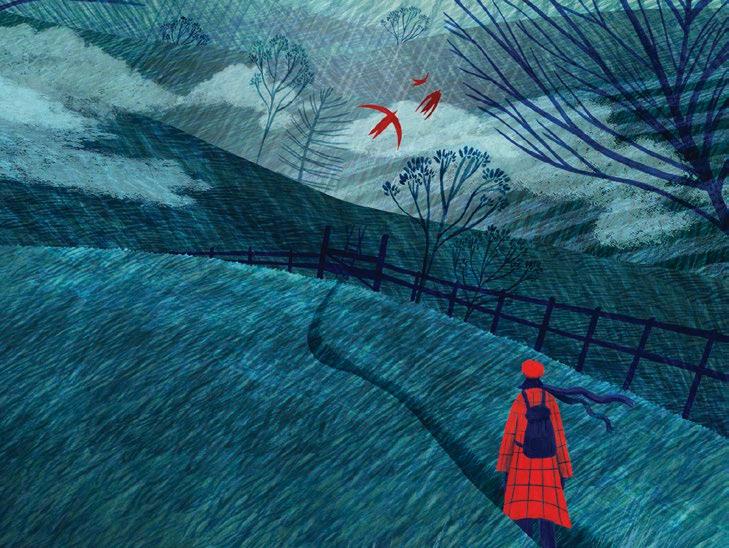
WINTER WOES
It’s what we've always suspected—cold weather makes some conditions worse

Susannah Hickling is twice winner of the Guild of Health Writers Best Consumer Magazine Health Feature
Depression It’s not surprising we feel more miserable during the dreary winter months. There’s even a recognised form of winter depression—Seasonal Affective Disorder (SAD). Scientists think that the short days and lack of sunlight play a part.
So if you feel down or moody in winter, try to get outdoors as much as possible to make the most of the available daylight and take regular exercise. If that doesn’t do the trick, light therapy with the help of a light box which simulates sunlight, or cognitive behavioural therapy (CBT) are other treatments. A GP may think antidepressants are appropriate.
46 • FEBRUARY 2021
illustration by Rosanna Tasker
HEALTH
Dementia and memory Many of us who know people with dementia or even mild cognitive problems would confirm that they seem to function less well during the winter. A 2018 study of 3,353 older adults in PLOS Medicine confirmed this and suggested that winter might be the most likely season to get an Alzheimer’s diagnosis. Not only that, but other research shows that younger adults have a worse memory and attention span in the colder months. Getting enough sleep will improve memory, concentration and learning.
Asthma This common lung condition causes difficulty breathing when the airways narrow during an attack. Cold air is a trigger for some, and sniffles and flu, which are more frequent in winter, can also play havoc. Knowing what brings on an attack is the first key step in avoiding one—allergies, stress and exercise can prompt one as well. Make sure you’ve had a flu jab and see your GP if you feel your asthma is causing you issues.
Psoriasis
This skin condition which affects about 2 per cent of people in the UK can often be worse in chilly weather. Moisturise, moisturise, moisturise is the mantra if you’re one of those affected in this way. Showering in warm rather than hot water to avoid the skin drying out,
wearing soft natural materials next to your skin and drinking plenty of water to keep the skin hydrated may also help. But, as ever, see your GP if you’re having persistent problems managing your psoriasis.
Arthritis What person with joint aches and pains doesn’t complain about feeling more creaky during winter? Some doctors think it’s linked to changes in barometric pressure. And, of course, when the weather’s bad, we’re less likely to exercise, when in fact staying active will help keep your joints supple and strengthen muscles. Just a few minutes every day will help. And it’s important to maintain a healthy weight, as extra kilos put extra strain on joints.
High blood pressure Studies have revealed that people have higher blood pressure readings in colder temperatures and lower readings when it’s warm. This is because cold weather causes your blood vessels to narrow. Once again, doing less physical activity because the weather’s bad might have an impact on your blood pressure too. Keep moving is the advice, and make sure that if you’re due for a blood pressure check, you get it done. n
For more weekly health tips and stories, sign up to our newsletter at readersdigest.co.uk
FEBRUARY 2021 • 47
5 Truths About Toothache
1
The—ahem—root cause of most toothache is tooth decay. The pain can be agonising but people often put off doing anything about it. Instead, they prefer to dose themselves up with painkillers. But toothache doesn’t get better on its own, so don’t delay seeing a dentist.
2
There are other causes that make it important to seek help. Grinding your teeth, gum disease and sinus pressure can all be to blame for toothache symptoms too. These, along with cavities, are unpleasant but not life threatening. Heart attacks, on the other hand, are. Heart attacks and angina do occasionally manifest themselves as dental pain—in which case you need to get your ticker rather than your teeth checked as soon as possible.
3
Don’t assume you need a filling. If you’ve got tooth decay, you probably will, though sometimes you will need a crown if your tooth is too badly damaged. Alternatively, your dentist might want to perform root canal treatment for a tooth whose pulp and blood vessels have become damaged or even extract the offending fang. If your toothache is caused by teeth grinding, dentists often prescribe a mouth guard to wear at night.
4 You can have your teeth aligned at any age. If your misaligned teeth are causing your toothache, then orthodontic treatment may help. There are different kinds of braces—some are even invisible—and they’re no longer just for children. That said, it might take longer to have your gnashers straightened as an adult.
5 You can often keep toothache at bay. Good dental hygiene is key. The risk of gum disease, cavities and abscesses, which occur when tooth decay and gum disease conspire to cause an infection near a tooth root, can be minimised by brushing teeth for two minutes twice a day with a fluoride toothpaste and flossing once a day. Seeing your dentist and your hygienist regularly will also help. There’s really no need to let your teeth become a pain! n
HEALTH 48 • FEBRUARY 2021
Ask The Expert: Niksen
Dutch mindfulness expert Annette Lavrijsen is the author of Niksen, the Dutch Art of Doing Nothing
What is niksen?
In Dutch, "niksen" literally means “to do nothing”. Niksen used to have negative connotations of laziness, but it’s been reinterpreted as a positive practice because the world today is more connected, more frenzied, faster. Niksen is allowing ourselves to take time out and consciously switch off, without feeling guilty.
How did you become an expert in it?
I’ve always been interested in health and was editor of Women’s Health in The Netherlands for a while. I write about mindfulness and psychology. Niksen is the down-to-earth answer to mindfulness.
How can niksen help people?
It enables you prioritise yourself and what you need. Often we think we’re busy, but who can’t take a half-hour break? Niksen brings the same benefits as mindfulness in terms of mental health, sleep, creativity and enhanced focus. It helps the body and brain recover.
Describe some easy ways people can embrace doing nothing? It might feel awkward at first. Do a relaxation exercise and let your mind
wander. There’s a Dutch verb, uitwaaien, "to go out in the wind". It refreshes the mind. Go out and watch clouds—lie on your back and make up stories. People-watch. Indoors, choose a nice space and make it your own—make it comfy, add some flowers, sit by the window and watch the day go by. Singlefocus crafts such as knitting or quilting can be a helpful first step.
How can people ensure that niksen becomes a regular and fulfilling part of their life? It should be a mindset. Schedule time and give yourself permission to do nothing. Start small—five minutes, ten, half an hour a day, up to a few hours at the weekend. Repeat to yourself, “It’s a good thing to do nothing,” and practise saying, “No, another time,” when you’re busy and somebody asks for your help. Do one thing a day for the sake of it. n
Niksen, the Dutch Art of Doing Nothing is published by White Lion Publishing

FEBRUARY 2021 • 49
READER’S DIGEST
The Gift Of Giving
This month, Dr Max Pemberton recalls one of the most difficult conversations he’s ever had to have

Max is a hospital doctor, author and columnist. He currently works full time in mental health for the NHS. His new book, The Marvellous Adventure of Being Human, is out now
I’ve only had to do it once, and it’s one of those things I hope I’ll never have to do again. My mouth was dry, my palms sweaty and my voice was tremulous. The only thing that kept me focused was the thought that things were so much worse for the family I was talking to. It was in my first year of work as a doctor, towards the end of my job in surgery. That time was filled with frightening, uncomfortable experiences, but the prospect of this one was the worst.
A woman in her early twenties had been brought in after a road traffic accident. She had suffered multiple injuries, and had been rushed up to theatre. I had spent some time in between assisting in theatre talking to the family as they waited for news. The surgeons had been unable to save her life and she died on the table. Ashen-faced, the consultant told them the news. I sat with them
50 • FEBRUARY 2021
HEALTH
NOTHING COULD TAKE AWAY THE PAIN OF HAVING LOST THEIR DAUGHTER. YET THIS LAST, FINAL ACT HAD COMFORTED THEM
for some time as they sobbed quietly and when I emerged from the room the consultant was standing outside. “I think it would be nice if it came from you” he said.
I stared blankly. “What?” I asked.
“About organ donation,” he replied. I swallowed hard. Surely this would be the last thing they’d want to talk about. It felt acutely awkward and ill-timed to be considering this kind of conversation while they were being engulfed in grief. But the problem with organ donation is that every minute counts. The clock is ticking because the sooner organs can be transplanted, the better the chance they will survive in the recipient’s body. At medical school I had done a course on how to broach difficult subjects with patients but this was altogether different. “I’ll be in there with you,” he said, trying to calm my nerves, “You lead the discussion though.”
I began to feel sick. I opened the door and sat opposite them, convinced that I was only going to make things worse for them.
“It’s what she’d have wanted,” the mother said before I’d even finished. The father nodded. While I had imagined they might be angry with me for bringing up such a delicate subject in their moment of grief, in fact they seemed pleased.
“She was always so generous,” her father added.
As my consultant and I left them, it occurred to me that I’d been wrong in thinking it would be an awkward conversation. Nothing could take away the pain of having lost their daughter. Yet this last, final act had comforted them and helped them feel that the spirit of their daughter lived on in this act of generosity.
Strangely, it was one of the most heart-warming conversations I have ever had. n
FEBRUARY 2021 • 51
The Doctor Is In
Dr Max Pemberton
Q: I have been on antidepressants (citalopram) for about a year now but the exhaustion my doctor said I might experience at first hasn’t gone away. At work, I find myself falling asleep and have to drink energy drinks, and at home it’s normal for me to sleep in till 12. What can I do? Seems no point in stopping my depression if I’m not awake to enjoy it!
- Helen, 47
A: All medications have potential side effects and this includes antidepressants. Your GP is correct that most of these side effects are short lived—they tend to go after a few weeks as the body gets used to the medication. It seems though that this side effect is a real problem. You’re quite right—life is for living so we can’t have you feeling sleepy all the time. There are several different types of antidepressant and citalopram is from the group called SSRI. This group is the most commonly prescribed and do tend to be well tolerated. They are actually prescribed for a number of conditions, not

just depression. The most common side effects are feeling sick, feeling shaky, dizziness, blurred vision, loss of appetite and change in bowel habit. Feeling very sleepy isn’t a common side effect of citalopram, but everyone is different and this might be how this medication is affecting you. One thing to be mindful of, though, is sometimes excessive tiredness is a symptom of depression, so it might be that this is actually a symptom of your depression rather than a side effect of the medication. But, assuming this is a side effect, the good news is that there are a lot of other antidepressant options. I’d suggest you go back to your GP and ask to try an alternative. They are likely to prescribe a different SSRI. If this also gives you side effects, then there are different families of antidepressant that you can try. These are as effective as SSRIs but work in slightly different ways so are less likely to give you the same side effects. n
Got a health question for our doctor? Email it confidentially to askdrmax @readersdigest.co.uk
HEALTH
illustration by Javier Muñoz 52 • FEBRUARY 2021
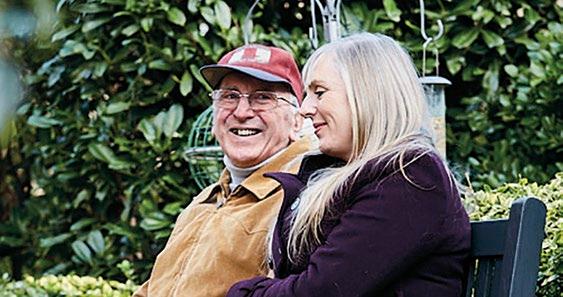

HEALTH

Learn Without Limits
You can trick your memory into staying switched on, says our memory expert, Jonathan Hancock
Do you ever walk out of a room with an idea in your head, only to discover moments later that it’s gone? If so, don’t worry: it’s a very common experience, and one that scientists believe they can explain. In fact, when you know why it happens, you can do some very straightforward things to stop it!
The problem is often caused by “event boundaries”. These are cues your memory uses to stop remembering, in the belief that a particular mental task is over. When you walk out of a room, you create such an event boundary, signalling to your brain that it can dump anything not firmly fixed in place.
Tests have proved that we’re much more forgetful when we move from one location to another. But the same happens when we go from one activity to another, too. It’s because anything that seems like the end of a task—closing a study book, finishing a phone call, taking a cake out of the oven—can have the same effect. Within seconds, the information you revised, the arrangements you made with your friend, or the new recipe you just used, has vanished. But here’s how to fight back.
First, stop telling your brain that its work is done. This can be as simple as leaving a book open instead of putting it back on the shelf, or keeping your phone in your hand as you jot down key details from the call. Second, create clues to carry with you across any unavoidable event boundary. Notice when one of these end-points to learning is coming up, and spend a moment reinforcing your memory.
If possible, say the key points out loud: the job you’re walking off to do in the next room, for example, or the plans you’ve just made on the phone. And picture the details you want to keep, because memory thrives on imagery. Visualise the key steps in the baking process, or see yourself meeting your friend in the park.
It can even help to do something physical, like crossing your fingers, and then keep doing it. Your brain will see this as part of the activity— which can’t have finished yet, because your fingers are still crossed!
Every day you’re faced with event boundaries that have the potential to restrict your recall. But by avoiding them when you can, and disguising them when you can’t, you’ll find that much less of your learning gets lost. n
54 • FEBRUARY 2021









Make a great gut decision





...because health begins on the inside*






















Live Culture capsules





Strains of broad spectrum live biocultures
With Lab4® the UK’s most studied microbiotic cultures‡










Digestive Enzyme capsules
Vegan Friendly Vegan Friendly




Designed to be taken with or after meals
Advanced formula including Lactase, Lipase & Protease enzymes
BRITAIN’S N o .1 VITAMIN COMPANY **
* With calcium which supports normal function of digestive enzymes. Includes lactase enzyme which improves lactose digestion†
From , chemists, health stores & www.vitabiotics.com
‡Lactobacillus acidophilus (2 strains), Bifidobacterium bifidum, Bif idobacterium animalis subsp. lactis
†In individuals who have difficulty digesting lactose. Tolerance to lactose is variable. Seek advice as to the role of this substance in your diet.
**Source: Nielsen GB ScanTrack Total Coverage Value and Unit Retail Sales 52 w/e 31 October 2020.
To verify contact Vitabiotics Ltd, 1 Apsley Way, London NW2 7HF.
2020-12-07_WEBWEZCON_E
Katie* knew she had to escape after her partner put her in a chokehold during an argument over pasta. She’d been with Mark* for four years, and married for 18 months. Both successful professionals (her in IT, and him in banking), living in London, the relationship turned violent shortly after their honeymoon, when arguments, mostly over money, spiralled into physical abuse…
MAKE ME DISAPPEAR!
BY Rob Crossan
Trigger warning: This article contains descriptions of domestic abuse
*Names have been changed
INSPIRE
56 • FEBRUARY 2021


Face slappings, kicking and coercive sex became the norm in their marital home, with Katie having to call in sick from work on two occasions, so that her friends and colleagues wouldn’t see her bruises.
When Mark complained that Katie had undercooked the pasta she’d prepared for an evening meal and attempted to strangle her, she knew drastic measures were necessary.
Fearing the prospect of further violence if she told the police and wasn’t believed, she began searching online for an answer to her increasingly frightening predicament. This is how she found Eileen Horan.
Based in Florida, Eileen has helped between 15 and 20 women from the US, Britain, Germany and more to "disappear" over the last two decades; enabling women who feel the police have failed them or who simply don’t want to involve the authorities, to vanish without a trace, so that their violent partners can never find them.
“To ‘disappear’ can mean many different things,” explains Eileen. “But for me, it’s making sure that somebody whom you don’t want to find you, absolutely never can if you don’t want them to.”
Eileen’s skills in making women disappear stem from the working relationship she had with her
58 • FEBRUARY 2021
ex-partner, whose job was to work with the police to find criminal suspects who had skipped bail and were on the run.
“His work in finding people made me realise that there are actually people who need help to make sure that they can’t be found as well,” says Eileen. “Though I think finding people is a lot easier than making people vanish effectively.”
Claiming to have a 100 per cent success rate, Eileen helped Katie to "disappear" from Mark four years ago using techniques which she insists are roughly the same, no matter what the location or the level of abuse.
Claire* was being stalked by her expartner Chris*. After she left him, Chris began turning up drunk at the supermarket where she did her shopping and her local hairdresser's, waiting for her and demanding that she tell him details about her new relationship.
the option of simply waiting for something more serious to occur before the law could protect her.
“I think not knowing what Chris was going to do next to her was more frightening than what she had already been through,” says Eileen.
“Claire was frightened,” she elaborates. “She broke down and cried during our first phone conversation. Like most women in this situation, she couldn't help feeling ashamed and wished that she had left her ex-partner sooner. I think for Claire, it was just a huge relief to truly be able to talk about it openly for the first time.”
“FINDING PEOPLE IS A LOT EASIER THAN MAKING THEM VANISH”
To help women escape from their stalkers, Eileen employs a technique of spreading a wide range of false leads (a tactic she calls "dis-information") in order to put men off the scent.
After six months of situations like this occurring once or twice a week, Claire was feeling increasingly trapped. Her local police force in Newfoundland, Canada didn’t believe there was enough evidence to convict Chris and so, as Eileen tells me, Claire was left with
“By doing this, I ensure that the women I work with communicate only with those whom they want to stay in touch with. This means doing things like always using pre-paid, disposable mobile phones. I always make sure to look into the relevant local laws, though—particularly in relation to custody. The last thing I want to do is assist a woman in vanishing with her child when the father still has legal access rights.”
FEBRUARY 2021 • 59
READER’S DIGEST
Katie’s case may have been legitimate but, in Eileen’s estimation, around 50 per cent of the requests for help that she receives have ulterior motives, from attempting to use Eileen in order to defy the law (for example, disappearing in order to run away from debts or family obligations) or simply because they want attention.
“I’m very particular about who I choose to help and the unpleasant truth is that so many women who have approached me are not people I can help,” Eileen insists.
“I need complete honesty and openness from anyone who genuinely wants my help and it’s impossible to help women who are hiding information and not giving me absolute, 100 per cent disclosure about their situation and what’s happened to get them to the point where they want to disappear. A lot of women who approach me are simply not able to tell the truth, and I’ve become very adept over the years at figuring out quite quickly who is a genuine case and who is simply trying to get revenge on their partner or is running away from
debts or family obligations.”
Raised in New Jersey, Eileen says she had a "difficult start" in life. Running away from home at the age of 12 and having a baby when she was just 16, she states that she has never been in a violent or abusive relationship herself.
“The work I do isn’t a reaction to anything like that. My motivation is more practical than emotional, I think. It has to be that way in order to be good at it.”
“I’M VERY PARTICULAR ABOUT WHO I CHOOSE TO HELP”
As well as helping women spread "dis-information", the practical assistance Eileen provides centres around using social media to the victim’s advantage and setting an "exit" day well in advance.
“People often think that the internet and social media must make it so much more difficult to effectively disappear these days. The absolute opposite is true,” Eileen explains.
“You can create as many social media accounts as you like. If you create a lot of them and they all carry different information then you’re creating a maze of deadends and false leads which will, quite quickly in my experience, force ex-partners to admit defeat and eventually stop looking for the partner they abused.”
60 • FEBRUARY 2021
MAKE ME DISAPPEAR!

As far as "Exit Day" is concerned, Eileen states that it’s possible to vanish in as little as two weeks if you’re flexible and have some capital—though most women usually need longer.
“I definitely support women who think big. In the US, I always encourage my clients to move as far away as they think they can, though sometimes I’ve had women who have moved only 100 miles or so away and that can be enough.”
The psychological toil of disappearing can be heavy for the victims, no matter how good the practical advice, a fact that Eileen readily admits to. British psychologist Dr Clive Rix agrees:
“We’re brought up to believe that our lives should have a clear trajectory; from school to work to marriage to children to retirement,” says Dr Rix.
“Disappearing is ripping a huge tear into how most of us perceive the direction of our lives. All the totems and memories of who we are have to be rearranged or removed. It can be a very isolating experience, not just for the person who disappears but also for their families. Even the most basic questions can become difficult and, in my opinion, only time, support and patience can help someone get past that—things that can be difficult to achieve if you’re in a traumatised state.”
FEBRUARY 2021 • 61

And yet the imperative to disappear is borne out by the statistics quoted by Laura Dix, National Community Engagement Manager at Women's Aid.
“We recognise that the fear women feel about leaving an abusive partner is real, and it is not an easy process,” says Laura.
“There is a rise in the likelihood of violence after separation. According to the Femicide Census (2018), 55 per cent of the women killed by their ex-partner or ex-spouse in 2017 were murdered within the first month of separation, and 87 per cent in the first year. Domestic abuse support workers appreciate
that deciding to leave an abusive partner is a huge decision that only the survivor can make.”
The other key element which can complicate the act of disappearing is money. And although Eileen doesn’t charge for her services, she always tells her clients that disappearing without financial back up is impossible.
“I tell the women I help that they have to have around £5,000 in their bank account in order to disappear. Leaving everything you know can be expensive and you have to have that amount of money at the very least to get back onto your feet and
62 • FEBRUARY 2021
start a new life. If you’re rich, then that fantasy of disappearing on a yacht to the Pacific Ocean really can come true. If you’re not so well off, then that dream isn’t really a reality that is viable.”
Katie still hasn’t returned to London, according to Eileen. But there is little she can do if some of the women whom she helps vanish, do decide, weeks, months or sometimes even years down the line, to return to the abusive partner.
“I absolutely insist that the women I help don’t go back to their former home town for a year at the absolute minimum,” says Eileen.
“It’s too risky to go back before that as there’s a good chance that the ex-partner will still be angry and will be looking for clues as to their whereabouts. You have to give the violent ex-partner time to move on with their life too.
for them for as long as they need.”
Eileen isn't helping as many women as she used to. Now 53, the break up with her ex-partner means the income from his skip tracing career which enabled her to work pro bono is no longer there. However, Eileen insists that she is still open to helping genuine cases. When asked about why her work is still necessary, when such supposedly significant advances have been made by law enforcement to protect women in danger, her conclusion is grimly prescient.
“SOME MEN ARE ABLE TO WALTZ RIGHT THROUGH RESTRAINT ORDERS”
“To disappear is an absolute last resort for women. But some men are able to waltz right through restraint orders.
"But sometimes women do go back to their violent partners. Disappearing can be painful, and it takes some time for women to process. Sometimes I stay in touch with the women I help for a good few months after they disappear, and listen to them. I try to be there
The point is, who cares if the abuser is eventually punished if, by that point, you’re not alive to see it? Disappearing is what I can make happen if you’re at a point where the police and the judiciary aren’t working and simply moving to your parents' house or to a friend's is not going to stop the person abusing you.” n
Visit eileenhoran.com for more information on Eileen, and womensaid. org.uk to donate to Women's Aid
FEBRUARY 2021 • 63 READER’S DIGEST

“ Dundee is like a phoenix from the ashes… its spirit is unbroken”
64
- Actor, Brian Cox
My Britain: Dundee

Named the "coolest little city in Britain" by GQ magazine in 2015, Dundee's star has been on the rise of late, as it recovers from the tricky years of the late 1900s with an impressive tenacity. Dundee's economy was dominated by the jute industry from the 1800s, at the height of which some 62 mills employing 50,000 workers operated in the city. Alongside jute, the city was known for its production of marmalade and the publishing firm DC Thomson. This led to the saying that Dundee was founded on the
"three Js"—jute, jam and journalism.
Unfortunately, a reduced demand saw the jute industry fall into decline in the early 20th century, and the mass unemployment that followed marked a tricky period for the city. Since the early 2000s, however, major regeneration has seen Dundee thrive once more, with a project connecting the waterfront and city centre refreshing its life force. The main centrepiece of the project was the opening of the V&A—the museum's only branch outside London.
INSPIRE
Ged Grimes, 58, is a musician, producer and composer and the bass player for Simple Minds. He was born and bred in Dundee, and has always returned to his hometown. Learn more about his work at flow.page/gedgrimes
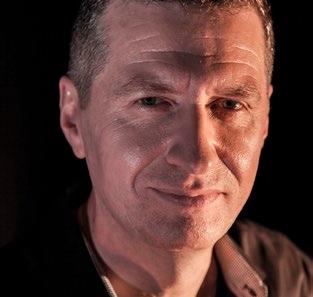
My favourite spot in Dundee is Broughty Ferry to the east of the city. It has a lovely quiet beach, stunning views out over the river Tay and some of the cosiest bars in the city.
In addition to my work with Simple Minds, I compose a lot of music for video game soundtracks. Dundee is the centre of Scotland’s Games Industry and hit games such as Minecraft are Ged Grimes
Dundee today is unrecognisable from the city I grew up in. The city struggled a bit in the 1980s to adapt from its industrial past, but the transformation in the last couple of decades has been incredible to see.
I was born and bred in Dundee, and although I've also lived in London and Spain and touring with Simple Minds takes me all over the world, there is nothing like arriving back in Dundee at the end of a tour. It's such a comforting and familiar feeling to be back home.
Dundee enjoys one of the best settings in the UK. I’m a keen cyclist and we have so many fantastic routes from the city. Within ten minutes of riding from my house, I can be deep in a forest, riding coastal paths or up in the hills surrounded by nature—it's very special. And the climate's not bad either!

BEST OF BRITISH MY BRITAIN: DUNDEE 66 • FEBRUARY 2021

produced here. Dundee’s Universities have attracted thousands of students to the city and Abertay University was one of the first to offer a degree in Computer Gaming. Many of the students, on finishing their games courses, formed their own companies and stayed put, making Dundee their home and helping transform the city’s fortunes.
The Waterfront Development, which includes the world class V&A museum, has been a catalyst for visitors and Dundonians are hugely proud of all the attention we are now enjoying on the global stage. The people of Dundee are what gives the city its unique character—they are resilient, supportive and have a unique sense of humour.
Dundee has always had a strong connection with US music, particularly soul music. When I was starting out as a musician, I used to go and see some of soul bands that were around in the city and that helped me broaden my musical horizons and develop my style. Since we aren't a big city, most of the musicians know each other and are constantly guesting in each other’s bands or hosting live music nights. You can hear everything from jazz to electronic music in Dundee’s numerous music venues.
One of my proudest moments was when Simple Minds played Dundee’s Waterfront in 2018. To walk on stage with 10,000 Dundonians and the river shimmering in the background was an unforgettable experience.
67
FEBRUARY 2021 • 67
Louise Murphy
Louise Murphy, 38, co-owns DD Tours, a tour company covering the darker moments in Dundee's history. Visit ddtours.co.uk to learn more or to book a tour

My family has been from Dundee for generations, and I've lived here since I was three. I’ve never wanted to leave Dundee because of the people—not just my family but because of all the friends you make anywhere you go in the city.
I love that Dundee has a small-town feel, but in a city. We have all the amenities of a city here, with big events, concerts and shopping centres; but walk down any busy street and you will probably bump into ten people you know. I think Dundee is the perfect size for having good facilities, but still feeling like a tight-knit community.
There has been a lot of modernisation in the city compared with the Dundee
I grew up in in the 1980s. The city I grew up in was still very industrial and almost everyone worked in Timex or NCR as well as the remaining jute mills. Now we’re on the world stage for design, bioscience and video games and there’s definitely more diversity in the city, its people, our industries and events—which makes it a more exciting place to be.
Dundee has always had a fighting spirit. As a community we strongly believe in fairness, equality and helping others—and we’re not afraid to tell people that, or to stand up for what we believe in. I also love the sense of humour of Dundonians. It can be dark humour at times (which we have been known to do on the tours!) but we really do like to have fun and aren’t afraid to crack jokes at our own expense too.
Dundee has so much hidden history. Many of the old buildings and streets have been replaced, and so the stories often tend to get lost with them. We love to surprise people on our tours—both locals and visitors—with what they can see (for example, we run tours in the underground vaults, which is the old high street of the 1600s) and the stories about the people of Dundee’s past we bring to life.
If I had to pick a favourite spot in the city it would have to be the top of the Law [a hill in the centre of the city]—the views are just out of this world. n
To plan a future visit to Dundee, head to visitscotland.com or dundee.com
BEST OF BRITISH MY BRITAIN: DUNDEE
68 • FEBRUARY 2021





If I Ruled The World
Monica Dolan
Monica Dolan is a BAFTA and Olivier award-winning actress whose work spans stage, television and film
Everyone would have time and space to pursue their interests from a young age. These interests would not be imposed from the outside, linked to other people’s ideas of achievement, or gaining approval; they’d be for their own sake. Whatever the person enjoys, however embryonic, would be noticed and nurtured from a young age and allowed to become apparent when they grow up. Ultimately, people would develop confidence and happiness from knowing that what’s inside them is good.
I’d make it a criminal offence to knowingly lie during a campaign to achieve public office. In fact, I would like to try out Plato’s idea, where you only get into power by rolling the dice and you can only be voted out of power by the people. In that way, people’s positions of power would not be determined by their popularity nor potentially secured by lies.
Everyone would have access to a safe space, especially in debates. Often in debates one person or group of people might be more emotionally invested or more vulnerable than the other, and so it’s really important for them to have a safe space.
I remember being at school and having a brilliant theatre history teacher called Alan Beck; we were in the class one day and one of the boys said something I felt confused and uncomfortable by.
Immediately Alan said, “OK, I’m just going to stop everything, there’s a space over there in the corner of the room for any of the girls who would like to go and just be there or go and talk about anything.”
I was actually quite confused by this at the time, so I didn’t go over but I know I came away feeling relieved that a space was there.
“Doom-scrolling” would be counteracted with other topics. For example, a popup to the Good
INSPIRE
70 • FEBRUARY 2021
Samaritans’ website would come up so that the person scrolling through their news feed could see they have the choice to think about something else—that there’s another option to occupy their mind or that there’s help available. We only have the choices that we can see.
There would be age regulations on cosmetic procedures. The UK’s one of the most unregulated places when it comes to age restrictions on them. Nowadays, celebrities are being more and more open about the work that they had done, and children are absorbing that.

grow in a way that’s sensitive to their own sexuality which would develop from what’s inside them and from positive experiences of intimacy.
I remember being really cross when my play The Beast was reviewed on Radio 4 and one of the reviewers said that my main character had taken her child for a cosmetic procedure illegally when there was actually nothing illegal about it—that was the whole point. I think people’s mental health should be considered.
There’d be no fusion of sex and violence, or pornography. People’s feelings of sexuality would develop from a combination of what’s inside them and what’s going on around them in the present; without images from the media being imposed on them. People would be allowed to
I’ve got a friend who’s a psychotherapist. He works a lot with boys and young men and he said that we’ve got no idea of the scale of unhappiness and mental illness which is occurring in them as a result of the way they’re learning about sex and the material they’re absorbing from a very young age. n
As told to Eva Mackevic
Monica Dolan will be appearing in the historical drama, The Dig, alongside Ralph Fiennes and Carey Mulligan, out in cinemas from January 15, and available on Netflix from January 29
FEBRUARY 2021 • 71
WHY SHOULD YOU CONSIDER RELEASING EQUITY IN 2021?
There has never been a better time for you to consider releasing equity from your home. The most popular equity release product, a Lifetime Mortgage, has become increasingly flexible. With low interest rates and new features, releasing equity in this way offers one of the most competitive ways for you to receive money as you are in or approaching retirement.
WHAT COULD YOU DO WITH YOUR RELEASED EQUITY?
The tax-free sum that you release from your home can be used however you wish. If you needed a little guidance though, here are some of the most popular reasons for our customers to do so.
• Making home improvements
• Helping out loved ones
• Clearing an existing mortgage
If you wanted to find out more about using equity release to achieve your goals, you can call our Information Team today on 0800 029 1233. They can answer any questions that you might have.
By releasing equity from your home, you could boost your disposable income
If you were considering releasing equity to clear an existing mortgage, you could free your budget from costly monthly repayments. By doing so, there will be more available for you to spend on the things that matter to you.
With the uncertainty that many are facing since last year, this could offer a welcome piece of stability into your finances.
PARTNERSHIPPARTNERSHIPPROMOTION PROMOTION

REPAYING A LIFETIME MORTGAGE
Lifetime Mortgages do not require monthly payments, with the interest rolling up over time instead. The loan plus interest is then typically repaid with the sale of the home once you and your partner have died or entered permanent long-term care.
YOUR EQUITY RELEASE JOURNEY
Reader’s Digest Equity Release can offer you a free, no-obligation appointment with fully qualified advisers. Your adviser
will be able to help you understand the impact of releasing equity, both on the value of your estate and your entitlement to means-tested benefits.
In response to the events of the last year, they can also now offer you a variety of ways to access advice, depending on your preference. Whether you want to speak to an adviser over the telephone, by video call on Zoom or WhatsApp, or faceto-face, we can accommodate you.
If you’re interested in how equity release can help you this year, call us today. n
FOR MORE INFORMATION readersdigest.co.uk/er2 Call 0800 029 1233 Reader’s Digest Equity Release is a trading style of Responsible Life Limited. Only if you choose to proceed and your case completes will Responsible Life Limited charge an advice fee, currently not exceeding £1,490. Please note that due to restrictions face-to-face appointments may not be available in all areas. The Information Team will let you know the options available to you.
Memorial photography may seem like a new coping strategy for grief, but through the ages we've always documented death
DEATH,
Immortalised
By Jessica Lone Summers
DEATH COMES TO us all. This, we know, is certain. And yet, despite being a generation of snap-happy photographers in every aspect of our lives, when it comes to memorialising our loved ones after they pass, we look the other way. And, though the subject might seem like a contemporary take on our approach to death, it’s actually an old—and beautiful—practice.

INSPIRE
74 • FEBRUARY 2 021

75
DEATH, IMMORTALISED
In recent months, model Chrissy Teigen made headlines with the news that her much publicised pregnancy had come to a dreadful end. Her son, Jack, had to be induced early and subsequently died. While one might expect onlookers to offer heartfelt condolences and wellwishes at the news, the situation soon materialised into one of the most controversial social media moments of 2020.
While people in the public eye often opt for privacy in moments of grief, Teigen made the decision to
I SHARE THE PHOTOS SO SHE IS REMEMBERED. SHE WAS HERE, SHE IS LOVED
share a number of intimate black and white photos that led up to her delivery, and included a portrait of her and husband, singer John Legend, with their stillborn son. The photographs, though tastefully captured and presented, caused a stir among people who believed Teigen should have grieved more privately, and those who were shocked to see a bereaved mother and her deceased baby. Despite the equally strong
reaction of support from those who saw the photographs as brave and helpful for the cause of baby loss awareness, the negative retorts from so many highlighted the public’s deep rooted dislike for baring our most painful moments after a loved one passes.
Whether this reluctance to acknowledge death in its most escapable form comes from fear of death itself, or fear of morbid images remains unclear. But one UK charity, Remember My Baby—who provide baby remembrance photos to bereaved parents—work hard to help families through the most difficult time of their lives while also dismantling the stigma that surrounds death photography. Cheryl Johnson, co-founder and chair of Remember My Baby (RMB) thinks the dread of the unknown is what makes bystanders apprehensive.
“People don't want to think about a baby dying—a child's death is horrific. People don't want to think it happens so they block it out. It's often a difficult thing for midwives too, because they go in to have this wonderful, satisfying job helping people deliver babies, but it's not always like that and it's quite hard to take in. I once did an interview on BBC Breakfast News where they interviewed me and one of the mothers who’d had our service. The mother had put together a picture of the album and they filmed her face
76 • FEBRUARY 2 021

while flicking through the album, but they would not show the audience actual pictures in the album because they couldn't show a picture of a dead baby on breakfast TV. The mum was quite upset. But they considered that the grieving parents are the minority. And they're worried about upsetting the majority.”
One mother, Helen Sawyer, who RMB photographed with her daughter Mia at the time of her death, sees both sides of the coin when it comes to being shown memorial photos. “It’s difficult when talking specifically about the photos” she says. “I think I’d find it shocking if someone shared a photo of a deceased relative, yet I feel the
need to share my pictures regularly. I find that generally people are very sympathetic when they hear my story, while others can’t handle it as it’s so terrible. But it happens. More than people realise until it touches your family. I think the reason I share them so much is so she is remembered. I always say to people, she was here. She is loved.”
Despite the importance of such memorabilia after the fact, in the immediate moment of such misfortune, the idea of being photographed is often not so welcomed. Sawyer explains, “I didn’t want any pictures of Mia when she passed away. It scared me and I was in shock. Luckily for me I had a very level-headed husband who
FEBRUARY 2 021 • 77
READER’S DIGEST

gently persuaded me otherwise. I'm very grateful to him for that.
I initially thought that it was weird to have photos of your deceased child, but thanks to the wonderful photographer (who I now class as a friend) I have pictures that I cherish. As a parent of a deceased child you are in shock and don’t fully take in the repercussions of the trauma. The photos I took of Mia are rudimental and quite distressing and these are not how I want to remember her. Thanks to the work of RMB I don’t have to see them anymore.”
The History
Creating keepsakes to remember the ones we love after their death
is by no means a modern notion. The Latin term Memento Mori (“remember you must die") is an ancient Roman practice that iterates the necessity of embracing death and reflecting upon it. Similarly, in the oldest Buddhist texts, the term Maranasati ("remember death") strives to deliver the message that we must ponder our own mortality. Indeed, as long as humans have been living, dying has been a putative part of our existence, but it wasn’t until the 1800s—when photography became an actuality— that documenting death as we see it in life, began.
The daguerreotype was the first publicly available photographic
78 • FEBRUARY 2 021
process, and during the mid-1800s it became more commonplace for wealthy families to have portraits taken. In order to create an image, a daguerreotypist would place a slim piece of shiny silver-plated copper into the camera and expose it for either a long time (in darker settings) or a shorter time (with good lighting). Even when the lighting was good, the process would take minutes to complete and the subjects would have to keep completely still for the sake of a clear photograph—which is why you’ll rarely see any Victorian smiles. It was also the first photographic process to document death. In 1840, the death rate was 23 per 1,000—to put that into context, the country with the highest death rate in 2019 was Lesotho with 15 per 1,000. With such a high death rate and so few people getting photographs taken, the death of a family member often provided the first opportunity to do so.
“[These photos] tell us so much about who we are as human beings,” explains Elizabeth Burns, owner of the Burns Archive—the world’s largest collection of historical medical photographs.
“Next to my medical collection, the largest section is my memorial photography collection—my Sleeping Beauty series. Taking pictures of your dead loved ones was a normal practice in the 19th century after
photography came into being. It’s now being done again in the 21st century, as part of the bereavement process. Today, to not have a photograph is not to have existed.”
“The good death” was a Victorian ideal that meant to die at home was of the utmost honour. The notion of heaven was becoming ever more popular and as such, recently deceased people were thought to have an aura of insight and wisdom whereby a loved one might unload their troubles or ask to be pardoned for any wrongdoings. It was in this state of serenity that subjects were depicted while photographed after death. The photographer would often have the deceased appear to be sleeping, symbolising the calm state of life after death. Occasionally, a family would request that their loved one be posed in such a way that the photo could have been taken during life. In this instance, the deceased would be propped up, either sitting or semi-lying down with their eyes closed—the eyes would then be painted on after the photograph was imprinted. In these instances, the deceased person would often be a lot clearer than their living counterparts since the daguerreotype process favours stillness.
Despite many people today finding old photographs such as these eerie, it was actually incredibly common to be shown an image of someone else’s deceased relative. Undeniably, back
FEBRUARY 2 021 • 79
READER’S DIGEST
then reactions to death were imbued with the familiarity of caring for one’s own passed loved ones at home and living in closer proximity death itself, but perhaps there is something to be admired in the acceptance our Victorian counterparts displayed.
“Our society needs a different approach to death in general in order for [memorial photography] to become more accepted” says Johnson of RMB.
OUR SOCIETY NEEDS A DIFFERENT APPROACH TO DEATH FOR MEMORIAL PHOTOGRAPHY TO BECOME ACCEPTED
“People accept that old people die, but they don't think it happens elsewhere. It’s supposed to be the most joyous thing, having a baby. People can't contemplate that idea. But the fact is it happens.
Some parents get a diagnosis that their baby is very poorly and therefore don't expect it to survive or live for long. So for those families, it can actually be a joy that they get to meet their baby and the few hours they get to spend with them is precious. But when it's a baby that unexpectedly dies during labour you've got a different state of shock
and grief. It's unexpected, it's raw and then there can be accusations and blame. As photographers we can go into a room and it can be smiles and laughter or we could go into a room where it's stony silence and nobody speaks. Our job is to document the baby and create beautiful pictures. Obviously, not every baby looks the same, it depends if a baby's passed for some time but you can always get delicate shots of hands and feet.”
Although memorial photography today has become inherently specific to that of stillborn babies, some modern cultures have been found to start once again embracing different ways to honour the dead— including the deaths of slightly older people. Marin Funeral Home in San Juan, Puerto Rico, has become renowned for its unusual embalming techniques at the request of bereaved families or even the deceased themselves. Dubbed el muerto parado or “the standing dead” the funeral home has created nontraditional wakes since 2008 when 24-year-old Ángel Luis "Pedrito" Pantojas, a murder victim, was positioned standing up in his family’s living room for his family and friends to greet, say their farewells to and take photographs with.
Since then, the funeral home has hosted over ten el muerto parado funerals which have included
DEATH, IMMORTALISED 80 • FEBRUARY 2 021

positioning a man in a boxing ring, a deceased man on his beloved motorbike and an 80-year-old woman sitting serenely, surrounded by her flowers and plants and wearing her old wedding dress. The photographs of these instances are undoubtedly shocking to anyone unfamiliar with the phenomenon and although it's unlikely to catch on in many other instances, it does leave some interesting questions about our approach to remembering loved ones after death.
Behind the lens, capturing such potently sad moments can be crushing, but for a surprising reason. “For a new photographer, the fear is, what do you say?” Johnson explains. “They're not fearful of taking the
photograph, it’s more what do you say? Every photographer says the fear is worse than the actual reality— when we've got our camera it's like a shield and you're in professional mode. As a whole, the hardest part is when you're editing the photograph. It’s just you with the screen on your own and seeing how beautiful that baby was. The pain and the love is almost tangible.”
It seems there’s actually very little separating the boundaries between photography in life and photography in death. What sets the two apart is only our inability to face mortality, but the moment we do, is the moment we become enlightened to the beauty that remains once we’re gone. n
FEBRUARY 2 021 • 81 READER’S DIGEST
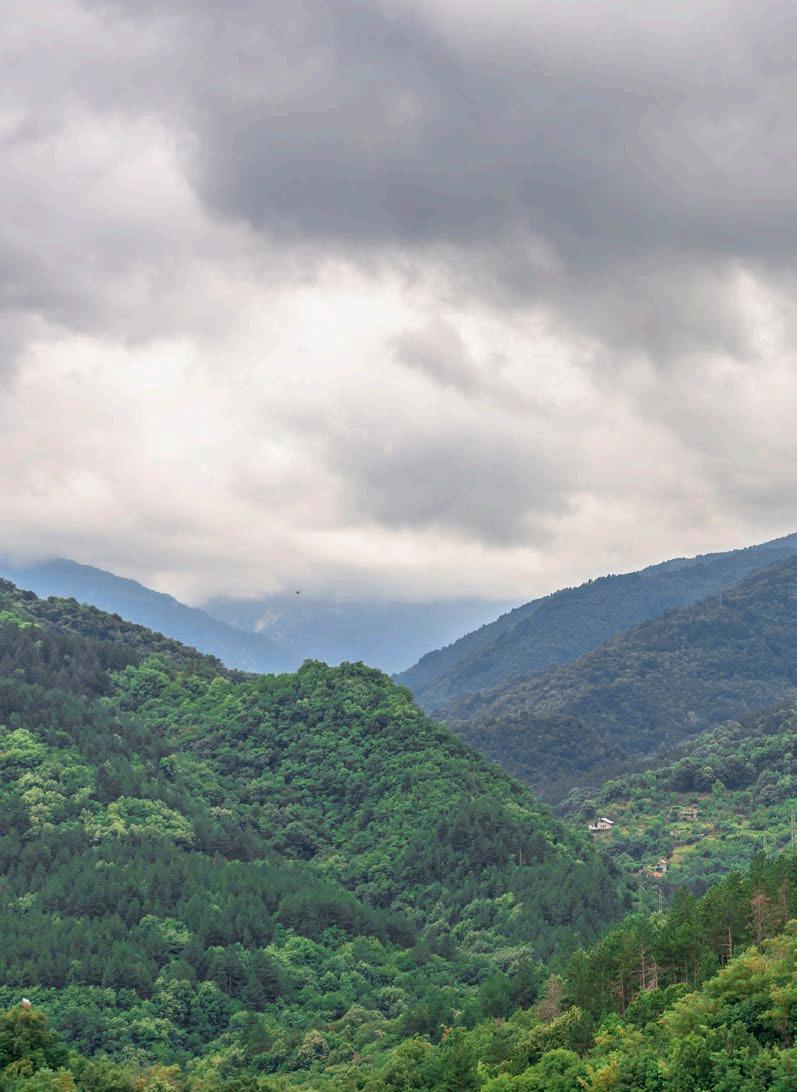
MEETING THE
PEOPLE
REWILDING EUROPE
By Joey Tyson
INSPIRE

Over the last 200 years, humans have become the undisputed dominant species on earth. As a result, the natural world has suffered tremendously. Today, almost half of the planet’s land is used for agriculture and food production, forcing our wild spaces into dramatic retreat. The global rate of extinction is higher than it’s ever been, while the climate crisis, aided by our vanishing wilderness, continues to accelerate.
With the world on the brink of two major ecological disasters, many conservationists are turning to "rewilding", in a bid to save our disappearing biodiversity. One recent study, published last year in Nature, suggests that if just 15 per cent of certain areas were rewilded, 60 per cent of expected extinctions could be stopped, with significant CO2 capture a much-needed side effect.
So, what exactly is rewilding? In theory, the concept is simple: restore swathes of land, and let nature take back control. Currently, there are hundreds of rewilding projects taking place across Europe, stretching from the UK all the way down to the eastern fringes of the Balkans.
In practice, it’s a little more complicated, and setting it in motion requires a massive effort, as well as substantial people power. For these projects to succeed, they need a special sort of person –highly skilled, and fiercely passionate individuals, or groups, willing to dedicate their lives to the restoration of the wild. Because, as much as we are responsible for the dire state of the natural world, only significant human effort will reverse the damage done.
From Italy, Britain and Bulgaria, we met with the people behind some of Europe’s most exciting rewilding projects.
83
ALASTAIR DRIVER, DIRECTOR OF REWILDING BRITAIN, UK
Four years ago, Alastair Driver was appointed director of Rewilding Britain, a charity with a mission to shake up conservation here in the UK. Originally, it was a temporary role, one that had coaxed Alistair out of early retirement. But once he got started, he fell in love with conservation all over again.
Alastair has one goal for rewilding in Britain: to make the concept mainstream. So far, he’s moving in the right direction. “We are in a position now where the British government is including rewilding in future farming policy, which is something that we have been pushing for,” he says.
If anyone knows what’s good for Britain’s wild spaces, it’s Alastair. After studying ecology at university, he went on to become the first ever conservation officer for the Thames Water Authority, where he spent 34 years preserving rivers and wetlands in the south of England. Then, in 2002, Alistair took charge of the Environment Agency, shaping national policy and strategy across the UK until 2016.
Alistair’s father was a country naturalist, and the natural world played a big role in his life from a very early age. “I was brought up

loving and knowing a fair bit about nature from as soon as I could walk,” he explains. “I was on his coattails tagging along on birding trips and catching insects.”
Forty years on from following his dad round the Cotswold countryside, Alastair has done it all in conservation. Now, he believes that rewilding is the next step for nature restoration in the UK. For that to happen, rewilding needs to happen on a much larger scale.
As such, Alastair spends most of his time travelling around the UK, meeting with large landowners, advising them about the merits of
84 • FEBRUARY 2021
REWILDING EUROPE

rewilding their land, and offering practical tips for getting started. In just four years, he’s seen a massive uptake in interest. In the early days, Alastair would literally ring around his contact list to get people involved; now, he can barely cope with sheer volume of emails and calls coming his way.
Part of this uptick is a symptom of the bigger environmental challenges facing humanity. “People are more aware about climate change,” he says. “They're more aware of the biodiversity crisis. And that's really helped to focus minds more.”
Towards the end of 2020, all of
Alastair’s work culminated in the launch of The Rewilding Network (rewildingbritain.org.uk/rewildingnetwork), a platform where farmers, community groups and landowners can connect, share ideas, and seek expert advice about rewilding.
Currently, just over 200,000 acres of land are being rewilded through the network. For Alastair, it’s a huge step in the right direction. “The Rewilding Network is really exploding now in terms of interest,” says Alastair. “Now we have this way of connecting people, informing and advising people, and helping them inspire each other. This will be here forever.”
FEBRUARY 2021 • 85
READER’S DIGEST
DR HRISTO HRISTOV, REWILDING OFFICER, THE RHODOPE MOUNTAINS, BULGARIA
Dr Hristo Hristov has been working with wildlife in Bulgaria’s remote Rhodope Mountains for over 30 years. He first came here as a brighteyed student in the early 1990s, eager to reverse the dwindling numbers of a rare species of vulture.
At the time, there were fewer than 20 birds left. It was a task so difficult, his university professor told him it would be impossible. Fast forward to November 2020, and griffon vultures are thriving again. At last count, a record 245 now roost in the Rhodope Mountains. It’s a huge result, and testament to Hristo’s unwavering dedication to Bulgaria’s wilderness.
As a vet and rewilding officer, Hristo is responsible for the welfare of the animals in his area, which means constant observation, and lengthy periods out in the wild conducting research. “This process, sometimes it is long—you have to live together with the animals,” he explains. “Forget everything; you live in nature, in a caravan or a tent. It doesn’t matter if it's horses, wild cattle or bison.”
This small corner of south-eastern Europe is one of the continent’s most ecologically diverse areas. Large

animals, such as wolves, brown bears, deer, and wild horses, coexist here. It’s also a haven for birdlife, with 300 species recorded, including 30 birds of prey. The ultimate goal is to create a thriving “mosaic habitat”, where multiple different species depend on one another.
Hristo’s current challenge is to continue the re-introduction of European bison to the wild. As a keystone species, its presence will help improve the area’s biodiversity, creating a richer environment for other species of flora and fauna. Bringing them back has not been easy, however. “The process is very
86 • DECEMBER 2020
REWILDING EUROPE
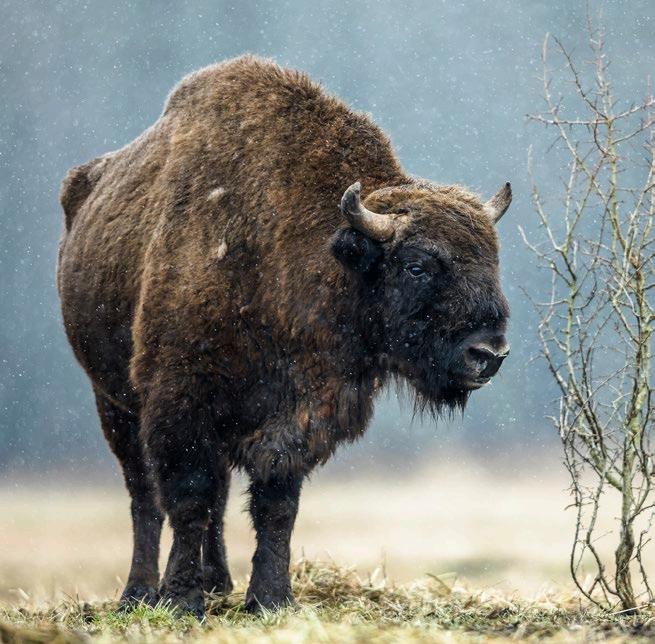
slow. You have to wait ten years for the first visible success,” he says.
Since 2013, Hristo has worked with Rewilding Europe, a non-forprofit organisation which operates across Europe, to bring bison back to the Rhodope. As he says, it’s a painstaking process, but one that is now starting to yield results. In 2019, the bison were released from their large enclosure into the wild, and
three calves have already been born, two of those coming in 2020.
At the end of last year, another two females were donated to the project from zoos in Hungary and Slovakia. When the new animals are eventually released into the wild, the herd will number 13. It’s another huge achievement for Hristo, the type that only comes from a life of total dedication to the wild.
FEBRUARY 2021 • 87
READER’S DIGEST
FRANCESCO ROMITO, VICE PRESIDENT, IO HO NON PAURA DEL LUPO, ITALY
As a young boy growing up in Sicily, Francesco Romito would hear stories about a different Italy—a wild place, where large predators still roamed the forests. It sparked a passion in him, one that would take him from the balmy streets of Palermo to Trento, high in the mountains of northern Italy. Once there, his love for wildlife continued to grow, bringing him face to face with one species in particular: the wolf.

Francesco is the vice president of Io ho non paura del lupo ["I am not afraid of the wolf"], a conservation association based in northern Italy. The group formed in 2016, in response to the media’s increasingly exaggerated coverage about Italian

wolves in the Val Taro region.
In Italy—especially rural areas— the wolf has a mostly negative reputation, and a big part of Francesco’s role is combatting this “dangerous” narrative, through positive, factual communications.
“Currently we are facing a really important moment for the wolves,” he explains. “This is a moment of expansion in Europe for the species, but there is a lot of misinformation about the wolves.”
Social media has become a very powerful tool for the group. Currently, they have a 50,000-strong following, where they share news about their research operations, wolf tracking and updates about upcoming events. Ultimately, the goal is to create an environment where wolves and humans can coexist peacefully.
“It’s not easy to manage people's feelings about this animal,” he says. “It’s easy for people to be scared.”
When Francesco isn’t posting online, he’s usually out in the mountains looking for wolves. As
REWILDING EUROPE 88 • FEBRUARY 2021
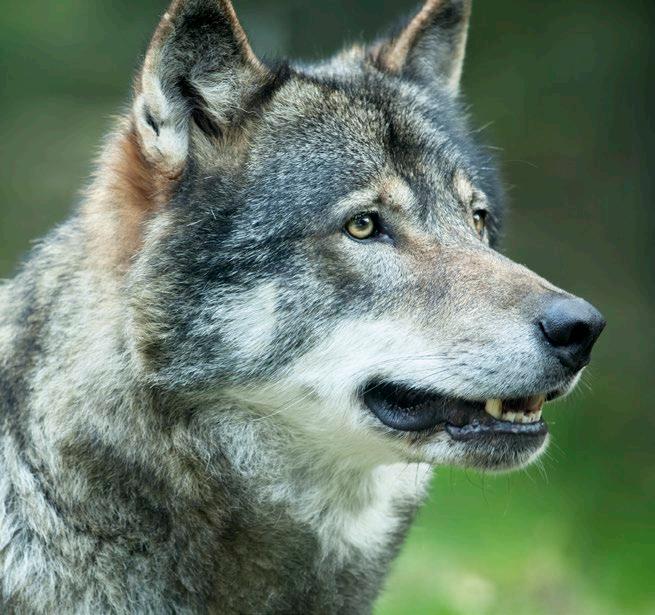
one of the most elusive animals in Europe, tracking them requires almost super-human patience. “It’s not easy to study. It’s not easy to find information. It's mainly a night animal, so it’s just not easy to see!”
In order to promote the rewilding of wolves in Italy, Francesco also meets with local people, rural farmers, and sheep breeders. In these meetings, he explains the benefits of having wild wolves
around. “We cannot have a real, natural environment without having predators at the top of it,” he says. “For me, the first important thing is to preserve the idea of the wild predator."
So far, the group’s approach seems to be working. Italian wolf numbers dropped down to around 100 individuals in the 1970s; today, it’s estimated that there could be as many as 900 in the wild. n
FEBRUARY 2021 • 89 READER’S DIGEST

90 TRAVEL & ADVENTURE
The Fairview Inn pub in Talkeetna, population 876. Right: The aurora borealis glows over scenic Glenn Highway.
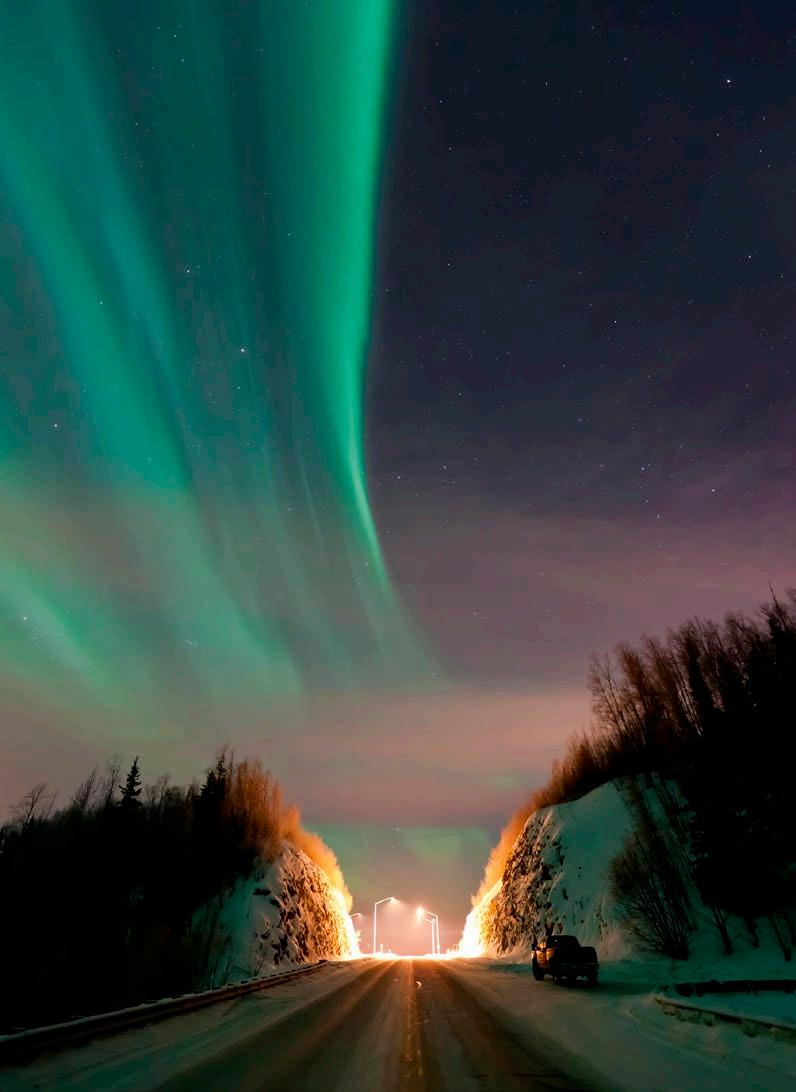
Super Natural Alaska
The land of the midnight sun remains as epic as ever
By Harry Pearson from Conde nast traveler
©Cann O n P HOTO gra PH y LLC/ aL amy (aur O ra) ©De S ign Pi CS i n C / aL amy STOC k PHOTO
PHOTOS: (bar)
It’s between Anchorage and the vast, frozen farmland around Palmer that the sheer immensity of Alaska hits us. The Glenn Highway, pointing northeast from the city, curves around the glacier-fed waterway of the Knik Arm before entering the wide delta of Eklutna Flats. Beyond lie the Chugach Mountains, as white as fine china. The Alaska Railroad runs parallel to us, crossing the Matanuska River on a steel bridge so dwarfed by its surroundings it could be part of an old model train set. I already know the facts: The Last Frontier, as Alaska is sometimes called, has more coastline than the 48 continental states put together, the tallest peak in North America, active volcanoes and glaciers, and 3 million lakes. But statistics can’t prepare you for its almost planetary scale.
My girlfriend, Deryn, and I pull into an overlook and step out into the frigid silence. A yellow-and-blue locomotive towing a long line of freight cars rumbles into view from the north, the harmonica wail of its whistle warning a few wandering moose. It’s as if I’m on a film set; any moment the director will yell, “Cut!” and the vast, snowy scenery will be carted off to reveal a studio lot.
A few years ago, my childhood friend Maggie from industrial northeast England improbably married an Alaskan bush pilot and
moved to the Matanuska-Susitna Valley, less than an hour north of Anchorage and en route to Denali National Park.
“Don’t come in the summer,” she said. “There are swarms of flies and hordes of tourists. Come at the start of March, when there’s tons of snow, the nights are lighter, and the cold won’t kill you. That’s when you’ll see the real Alaska.”
One day in early March, Deryn and I find ourselves in Anchorage, next to a bronze statue of the explorer James Cook. We’re looking across the glimmering inlet he charted in 1778, now named in his honour, toward North America’s tallest peak, Denali— at 20,000-plus feet, it’s visible 125 miles away. Cook came here seeking the Northwest Passage, and the generous bonus the British Admiralty promised to any Royal Navy captain who could find it. He was not the first to seek fortune here, nor the last. Like so many others, he was turned back by freezing seas, his crew close to mutiny. This morning there’s a rumble of pickup trucks bringing in teams of huskies for the ceremonial start of the famous Iditarod dog-sled race, a gruelling 1,000-mile trek following an Inupiaq trail that was later used by coal and gold miners. On the advice of an affable Native Alaskan taxi driver, we breakfast at Gwennie’s, where there’s a wealth of frontier kitsch—gold-and-black eagle-print wallpaper; stuffed moose, muskox,
PH otos : ( an CH ora G e ) ©Kevin G. s mit H / d esi G n Pi C s/ G etty; (JU m P in G) © sC ott d i CK erson/ d esi G n Pi C s/ G etty; ( road H o U se ) C o U rtesy of t H e tal K eetna road H o U se ; ( moose ) ©i s to CK /Getty i ma G es Pl U s; (H omer ) © Jay yU an/ sHU ttersto CK
SUPER NATURAL ALASKA 92 • FEBRUARY 2 021

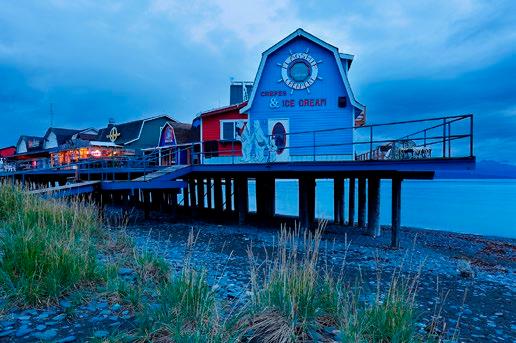
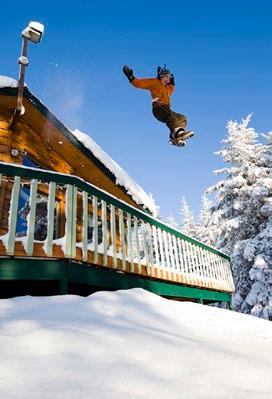
moose in populated areas of Alaska—even on the streets of Anchorage, as seen here

 Clockwise from above: A small shop at Homer Spit, at the tip of the Kenai Peninsula; sunset over Mt Susitna, viewed from Anchorage, Alaska's largest city; outdoor fun isn't hard to find in Homer, where there's plenty of snow; Talkeetna Roadhouse was built of timber in 1917; it's not uncommon to see
Clockwise from above: A small shop at Homer Spit, at the tip of the Kenai Peninsula; sunset over Mt Susitna, viewed from Anchorage, Alaska's largest city; outdoor fun isn't hard to find in Homer, where there's plenty of snow; Talkeetna Roadhouse was built of timber in 1917; it's not uncommon to see
and bear heads; and photos of bygone mushing teams. We feast on pancakes with birch syrup, surrounded by men in plaid, whose flap-eared hats look like they might jump down and run off with our bacon.
It’s also the final weekend of the annual Anchorage Fur Rondy (as in rendezvous), a ten-day festival that once marked the trappers’ return from their lonely winter in the wilderness, and the state’s biggest city is feeling festive. There’s a giant Texas Hold ’Em tournament, a miners-andtrappers ball, and something called the Cornhole Ice Breaker Tourney, not to mention Native Alaskan blankettossing and a herd of reindeer running down the main shopping street.
“Come in! I’m in the kitchen cooking a bear,” Maggie calls when we knock on her front door. She’s always had a whimsical sense of humour, but she’s not joking; her neighbour shot and butchered a black bear. We eat braised bear fillet with purpleskinned potatoes and red cabbage. The meat is lean and flaky, with a flavour like wild boar.
The next day my friend’s husband takes me out in his two-seat singleengine plane, a red-and-yellow 1944 Aeronca Chief. We fly north over the Susitna Valley for 30 miles to the town of Talkeetna, where we loop around the extraordinary Goose Creek Tower. Built by an eccentric Alaskan lawyer, it’s a 185-foot stack of log cabins, each of diminishing size, that rises
above the pine and spruce like a tower of cuckoo clocks. Then we fly over Hatcher Pass before plunging low over the frozen Susitna River as herds of moose tilt their antlers and glance lugubriously up at us from the snowy undergrowth.
Talkeetna (population 876) has a frontier feel and a cheerful familiarity. There’s a sign outside the Fairview Inn listing the house rules: no drugs, weapons, fighting, or arguing about closing time. We sip Bulleit bourbon while trying to predict the date and time the ice on the Tanana River will break up, an annual pastime of Alaskans, who submit their guesses in the Nenana Ice Classic (this year’s winner took home $125,000; the ice broke on April 27. But in 2019, it broke on April 14, the earliest since the Nenana began in 1917).
Soon we fall into conversation with Grog, a bearded giant and former gold prospector whose laughter thunders like an underground explosion. His spirited partner, Elaine, tells us she came to Talkeetna from Michigan a decade ago for the town’s Wilderness Woman Contest, during which she impressed the judges with her ability to keep a perimeter fire of driftwood burning through the night to ward off bears. Later, at the Bachelor Auction, Grog caught her eye and their romance blossomed.
We stay at the Talkeetna
SUPER NATURAL ALASKA 94 • FEBRUARY 2 021


Roadhouse, a 1917 timber building. In the dining room, white plank walls are hung with mountaineering charts and multicoloured flags from various expeditions that have used the hotel as a base for tackling Denali and Mount Foraker. There are two blackboard menus: “Breakfast” and “Not Breakfast.”
“The only bad thing about the Roadhouse,” the bartender at the Fairview had warned us, “is that bakery. When the smell of that fresh sourdough comes wafting up the stairs at four in the morning, it wakes you up and makes it damn hard to get back to sleep.”
She wasn’t wrong. On our first morning we gorge on just-baked cinnamon rolls, sourdough hotcakes, and crispy maple-cured bacon. Everything in Alaska comes with bacon; the Spenard Roadhouse in Anchorage, which serves high-quality American comfort food, even has a
Bacon of the Month. A few guests are here to follow the Iditarod; others are young, rangy cross-country skiers or middle-aged snowmobilers. An elderly Dutchman tells us he’s been coming to the Roadhouse for nearly 40 years. He no longer climbs or skis, but returns “just to catch up with all the friends I made.”
As I nurse a third mug of coffee in the cosy dining room, breathing the scent of fresh bread and pitch pine as the snow falls softly outside, I can see why. The place has a sense of being cut off from the world, and yet firmly entrenched in it.
On our final evening in Talkeetna, we dine at the Denali Brewpub on reindeer meatloaf, followed by a slice of peanut-butter pie. Later, I walk alone to the end of Main Street, away from the squat, red-timber frontages of Nagley’s Store and the West Rib Pub & Grill, and out onto the frozen river for a view of Denali
PH otos : ( seldovia ) ©Jody J. o verstreet; ( oysters ) C o U rtesy of Ja K olof Bay o yster Co
(Left) Stilt houses in the old Russian trading settlement of Seldovia; (right) fresh oysters from Jakolof Bay Oyster Co, next to the Homer Brewing Company taproom
FEBRUARY 2 021 • 95
by moonlight. I take a path alongside birch trees bowed with snow and soon find myself on the ice. The silence wraps me like a fleece. The distant mountains are a wide stripe of glowing white between pale grey panels of plains and sky. Put a frame around it all and you have a Rothko.
The view of Denali appears unchangeable, yet things are more unstable than they appear.
“Bears, moose, earthquakes, lightning, snowstorms, wildfires— Alaska is always going to find some way to kill you,” a gnarled young man wearing a feed-store baseball cap had remarked cheerily to us in the Fairview. The last threat is increasingly significant. Alaska is heating up much faster than the rest of the states, thanks to the loss of polar ice and increased deforestation.
The next day we go to Homer, at the tip of the Kenai Peninsula. It’s a sprawling seaside town with weatherboard galleries and bookstores, and a narrow spit that rolls like a serpent’s tongue into the bay toward the peaks of Kachemak Bay State Park. In a typical summer, cruise ships dock here, the RV parks are bursting, and restaurants and bars race to meet demand. But off-season, it’s quiet. We take walks along snowcovered Bishop’s Beach, and at Two Sisters Bakery we have a breakfast of chocolate bread and coffee.
Homer is a hub of Alaska’s local-food movement, which is
characterised by the state’s brief growing season, indigenous game, and, of course, seafood. The town bills itself as the Halibut Fishing Capital of the World. The red, snow, and king crabs are enormous and tender; the weathervane scallops, razor and geoduck clams, spot prawns, and wild salmon are ubiquitous. Chinook and sockeye are the most prized of the five salmon species that thrive in these waters. A thick fillet of the latter, grilled over alder chips at Anchorage’s thrummingly busy Glacier Brewhouse, is one of the best slabs of fish I’ve ever tasted. Another gastronomic highlight is the Jakolof Bay Oyster truck, which on Friday and Saturday afternoons is next to the Homer Brewing Company taproom. It passes out tinglingly fresh oysters, which are harvested the day before by the woman who serves them and are best washed down with one of the brewery’s bitter, malty porters.
We booked a cabin on a ridge for its views across Kachemak Bay to Grewingk Glacier, yet the snow falls so heavily for two days we can’t see very far. But being shut in is equally stirring. One morning we’re awakened by a small earthquake. Then, as we’re eating breakfast, a moose calf strolls past our window on its long, skinny legs.
Sometimes the only way to get a clear view of things in Alaska is from the air—and often, it is the only way to get where you want to go.
96 • FEBRUARY 2 021 SUPER NATURAL ALASKA
TRAVEL TIPS
Alaska Airlines operates non-stop daily flights to Anchorage from several major US cities, including Seattle, Los Angeles, and Chicago. Check online or contact your travel agent for the most up-to-date travel information. Also check operating times of restaurants and status of accommodations on their websites, or connect with travelalaska.com
When the snow stops, we catch the 11:20 Smokey Bay Air flight to the old Russian trading settlement of Seldovia. We fly over the Homer Spit and south down the coast before dropping down onto the narrow airstrip by the waters of the Seldovia Slough, which winds between stands of pine like a strip of grey-blue silk.
“Turn right—it’s not a far walk into town,” the pilot says after we disembark, as he offloads boxes of fresh produce.
Crossing a steel bridge, we pause at the sight of colourful cabins jutting out on stilts over the water. They were home to fishermen during a shortlived herring boom in the 1920s. Woodsmoke curls from burnished stovepipes. Seldovia is silent, save for the throaty cawing of a lonely raven.
We walk up snowy steps to the white-and-turquoise clapboard St Nicholas Russian Orthodox Church. From the mid-18th century, Russian fur traders, lured by the sea otter,
seal, mink, marmot, beaver, and bear populations, set up outposts defended by Russian garrisons. Today, communities of Old Believers (who split with the church over doctrinal differences in the mid-1600s) can be found in villages such as Nikolaevsk. You’ll spot them shopping in Homer, the women in long skirts and colourful headscarves. The czars clung to Alaska until 1867, when they sold it to the United States for $7.2 million. The deal was thought to be ludicrous, but after the discovery of gold here starting in the 1870s and oil in the 1960s, it became clear it had been staggeringly cheap. Native Alaskans were never consulted, of course. A series of legal actions culminated with the Alaskan Native Claims Settlement Act of 1971, which granted them 44 million acres and nearly a billion dollars—arguably small compensation for having your land sold out from under you. After returning to Seldovia, we take a taxi to Jakolof Bay, where we wait on a jetty surrounded by oyster beds to board a small boat to Homer. We stop at a tiny island to pick up a family from Anchorage that is building a cabin. We help the mother, father, and two kids with their bags.
“Going to be peaceful out there, no doubt,” the skipper says.
“Only thing’ll wake you is the noise of humpback whales slapping their tails on the water.” n
READER’S DIGEST FEBRUARY 2 021 • 97
from Condé nast traveler (JanUary/feBrUary 2020), CoPyriGHt ©2020 By Harry Pearson
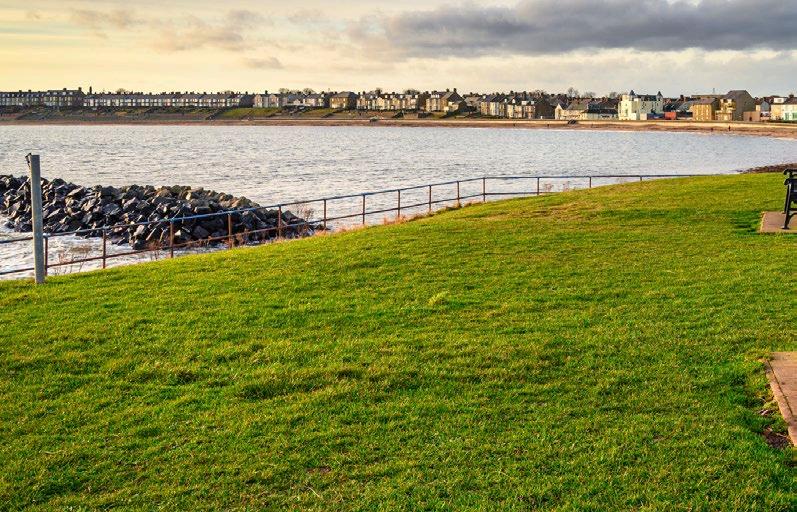
My Great Escape:
Novel Northumberland
Geraldine Syson, a reader from Glasgow, relives her recent staycation
Irecently enjoyed a weekend trip to Northumberland—my first time in the area—to a caravan park near Newbiggin-by-the-sea.
Driving from Scotland to Northumberland with family, a friend and two dogs in tow, the scenery on the coastal drive down was breathtaking. Our first stop was the picturesque and vibrant town of Dunbar for a bite to eat and a stroll along the quaint harbour with the dogs. Travelling on, we reached Alnwick market town with sweetsmelling hanging baskets displayed throughout the area.
After an enjoyable journey, we reached our destination, unpacked, and went for a walk to Newbigginby-the-sea. A short distance from the
caravan park, along a coastal path with views to die for, we arrived at the fantastic promenade and beach.
A fascinating “couple’s” statue sits on a breakwater in the bay and a smaller “land couple” statue positioned on the promenade looking out at them. The best views of the bay are at Church Point, where seats are situated at picture-perfect places to enjoy a picnic.
The next day provided the highlight of our holiday—a visit to Beamish, a live open-air museum. It is a fantastic historical time warp of the north east of England. There is so much to see that it’s impossible to visit the entire museum in one day. It is family and dog friendly, with plenty of intergenerational activities
TRAVEL & ADVENTURE 98 • FEBRUARY 2021
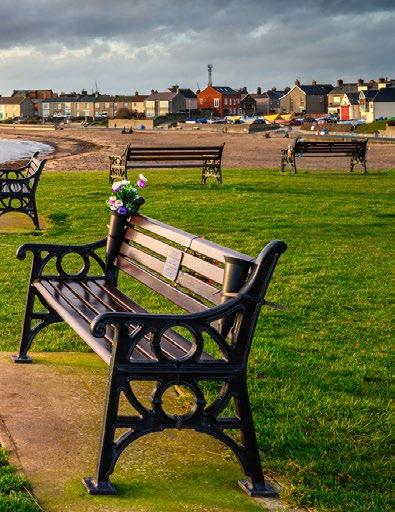

Next time, a ride on the steam train is a definite for me!
and opportunities to reminisce. Walking along a 1920s street, then entering working old-fashioned shops including a sweet shop, a bakery, the Co-op, a dentist, a bank and so many more, and being served by staff dressed in that era made us really feel as though we had stepped back in time!
We sat in the lovely park, enjoyed lunch in the tearoom and then hopped on a tram to explore a pit village complete with a mine, miners’ cottages, chapel and school—where we had fun with the gird and clique!
We also had time to visit a 1940s farm. Purchase an annual ticket, and you can return as often as you like. Open throughout the year, there are many seasonal activities to enjoy.
Our entire party slept extraordinarily well after our adventures, and woke early to the sun blazing throughout the caravan. After breakfast, we drove to Blythe beach, where the dogs were in absolute canine heaven. Blythe is a lovely clean beach, with a variety of long and short scenic walks nearby to choose from. There is a large car park and a cafe with countless icecream flavours! We all had one, of course—including the dogs.
The next day, reluctantly, we had to head home.
Once normality resumes after the COVID-19 pandemic, I will definitely be back. With so much more to see, I can’t wait and I will, of course, return to Beamish for the steam train! n
Tell us about your favourite holiday (send a photo too) and if we print it, we’ll pay £50. Email excerpts@readersdigest.co.uk
FEBRUARY 2021 • 99

GEMS HIDDEN

SINTRA TRAM Lisbon N
orth of central Lisbon stands the wealthy town of Sintra, a Unescoprotected enclave of castles, royal palaces and Romanticist architecture. One of its more obscure attractions, meanwhile, is the so-called Elétrico de Sintra, or Sintra Tram.
Taking 45 minutes between Sintra’s Museum of Modern Art and the beach town of Praia das Maçãs, this electric tramway’s seven-mile, narrow-gauge journey is as bumpy as its history.
After opening in 1904 the line served needy locals until 1953, when it was reduced to a summer service. Having closed during 1975’s Carnation Revolution, the tramway reopened five years later only to repeatedly pause again, due to accidents, treefall and even the theft of overhead copper cables, between 1994 and 2012.
Since then, however, it has soared in popularity. With a bargain fare of €3, a singlecar capacity as small as 24 (plus a few standing) and sometimes only two or three services from Friday to Sunday, queues are normal—especially in Sintra. The trick is either to arrive very early, or to get the 441 bus to Praia das Maçãs and undertake the less-subscribed return journey by tram. Tickets are usually sold on board.
Winding along the Sintra-Cascais Natural Park’s lush, rural north, the six-stop route offers views of distant castles as it descends steeply down mountainside to the riviera. Although some sections shadow tree-lined roads, there are twists and tight curves through backyards while the chugging pace—interrupted by sudden jolts—is charmingly old-fashioned.
Elegant red or yellow trolleys almost a century old, with dark-wood furnishings and open sides, are typically used. n
By Richard Mellor
FEBRUARY 2021 • 101
READER’S DIGEST
Don’t Let Loyalty Cost You Cash
It’s a quality most of us prize in friends, but when it comes to your bills, does loyalty really pay?
You’d hope businesses would value our loyalty. It only seems fair that we should get something in return for our repeat custom.

Yet, sadly, it’s now well established that when it comes to our money, sticking with the same supplier will often mean that you lose out when compared to shopping around.

Andy Webb is a personal finance journalist and runs the award-winning money blog, Be Clever With Your Cash
Brands often reserve their best deals for new customers (but even they lose out when introductory discounts end and prices jump). And future year-on-year increases for all who auto-renew can quickly creep up and up.
As a result, eight in ten people are overpaying for at least one of the following: broadband, mobile, home insurance, savings or mortgages, according to Citizen’s Advice.
Though regulators are cracking down, some of the new measures that have been introduced or mooted
MONEY
102 • FEBRUARY 2021
are voluntary or yet to start. Or they might simply be forcing companies to tell you when prices are increasing and by how much.
That means that to guarantee savings it’s best to do something yourself. So is “ditch and switch” always the smart option? Generally yes, though not always.
Don’t forget that these loyalty penalties are built on customers doing nothing. If you instead choose to challenge the annual price hikes, you might be able to get the best deal out there without moving. Here are the tricks to help you find the best price whether you move your custom or not.
1. IDENTIFY WHERE YOU’LL PAY MORE
The main places you’ll fall victim to this stealth tax are the ones where you enter into a contract, and let it auto-renew. Insurance is one of the worst culprits, but you see it across most bills. So check them all.
earning you practically nothing in interest.
But even if you don’t pay for a service, you could still be missing out by staying put. Banking is a good example where competition has meant there are a number of incentives to get you to switch your current account—from cashback on bills through to £100+ rewards. Stay loyal and you’ll likely miss out.
2. BEATING LOYALTY PREMIUMS
STICKING WITH THE SAME SUPPLIER OFTEN MEANS LOSING OUT COMPARED TO SHOPPING AROUND
The most important step is to make a note of when your contracts end. Though providers will hopefully let you know, it’s best to do this yourself. Comparison sites will generally help you find the lowest prices. You can compare pretty much everything now. You don’t have to wait until your deal expires either. You should start your research weeks before.
You’ll also likely be getting a worse deal at any business where you’ve been a constant customer for years.
Savings accounts are one of the most common places people lose out. Rates have been dropping at an alarming speed over the last year. If your money sits still it could well be
If you’re not online, or are adamant you don’t want to move, you should at least call up most providers to check you’re on the best possible deal.
In fact, it’s always worth getting in touch with your existing supplier to see if they’ll match or beat the deals you might have found with
FEBRUARY 2021 • 103

IF YOU ARE ALREADY GETTING A DECENT DEAL IT’S WORTH TAKING ADVANTAGE OF ANY LOYALTY SCHEMES AND EXTRA DISCOUNTS
their competitors. One way to gently nudge them along is to say you’re thinking of leaving. This often gets you access to the best deals that they can offer.
If you want to take it to the next level, you can actually go ahead and cancel and see if they get back in touch with a better deal a day or two later. Don’t worry, you can always reverse the decision and stick with them if the bluff doesn’t pay off!
You should also watch out for extras added on as freebies. It’s a common trick that I’ve seen with pay TV (more
channels) and mobile phones (extra data). If you don’t need these extras, then you’re not really saving money.
Of course, this is all not to say that you won’t ever benefit from sticking with the same company year on year. If you are already getting a decent deal, then it’s worth taking advantage of any loyalty schemes and extra discounts provided. So do check what is on offer. And remember you often get what you pay for. Sometimes you will want to pay more than the cheapest option to get everything you actually need. n
104 • FEBRUARY 2021
MONEY
On The Money
Andy Webb
Q: I’ve managed to put aside a great deal of savings in the years since I graduated from university, and I wondered if it would be wise to use a chunk of that money to pay off my student loans. Some say it’s better to just consider it a tax until it’s wiped out, but could paying it off put me ahead financially?
- Anon
A: Hi, I know how worrying it can be to have any kind of debts hanging over your head. And for anyone who went to university, the size of the money owed can easily be tens of thousands of pounds. Plus interest!
So I get why you’d want to clear that amount as soon as you can. But you’re right, student loans aren’t like other debts.
For a start, you might never actually need to pay back what you owe in full, though it can depend on where you live and when you graduated. It’s estimated that 83% of graduates on “Plan 2” (students since 2012 in
England and Wales) won’t do it within 30 years, when the loans are wiped out.
Of course you could be one of those high earners who will pay it all back. And if that’s the case you could be better off clearing it sooner to reduce interest payments. For more information on this I’d recommend the guides available to you on the moneysavingexpert.com website.
It’s also worth thinking about what else you could use those savings for. If you have any other debts, then pay them off first.
Next, I’d recommend thinking about how much you have in your emergency fund. During the uncertainty we’ve seen in the last year I’d recommend having access to three to six months of expenses, in case you were to lose your job. Beyond that, those savings could go towards a home, or make future purchases cheaper as you will have access to cash rather than needing to borrow. n

FEBRUARY 2021 • 105 READER’S DIGEST

A TASTE OF HOME: ANJUM SETHIA
Tangy Chickpea Curry
A bean curry never sounds that interesting but when you are Indian, it is full of complexity, deliciousness, comfort and family memories. We would have bean curries for Sunday lunch and we were happiest when it was this particular one.
The spices and flavours really complement the earthy chickpea and the tamarind lifts the whole dish. It is normally served with flatbreads

which, depending on where you eat it, could be fried, and a beguiling mix of crisp and soft bread or a crisp and smoky tandoori-baked flatbread. There are no other distractions; not even a vegetable side. I often have leftovers with some wholemeal toast! It is the things memories are made of and loved by the whole family.
106 • FEBRUARY 2021 FOOD
METHOD
1 Blend together the ginger, garlic and tomatoes with a little water until smooth. Set aside.
2 Heat the oil in a large saucepan. Add the cloves, cardamom pods, cinnamon, bay leaf and half the cumin seeds and cook until they release their aroma and start to crackle. Add the green chillies and onions and cook until the onions are well browned. Add the tomato paste along with the turmeric and coriander powder. Season well and cook over a moderate to high heat until the oil comes out at the sides, around 15 minutes, stirring often.
3 Meanwhile, toast the remaining cumin seeds in a small pan, stirring very often, until they have darkened quite a bit, around 40 seconds. Grind to a powder in a pestle and mortar and add to the pot.
4 Add the chickpeas to 450ml water. Bring to a boil and simmer over a medium flame for 7-8 minutes. Stir in the garam masala and tamarind paste. Mash a little of the chickpeas on the side of the pan to thicken the sauce a little. Taste for seasoning and tartness, sprinkle with the coriander and serve.
Anjum Sethia founded The Spice Tailor, an authentic range of Indian meal kits. Visit TheSpiceTailor.com to learn more, or to purchase the meal kit for this curry

INGREDIENTS:
Serves: 4-5
• 4 tbsp vegetable oil
• 4 cloves
• 4 green cardamom pods
• 2 large shards of cinnamon
• 1 black cardamom pod
• 1 bay leaf
• 2 tsp cumin seeds
• 2 400g cans of chickpeas, drained and rinsed
• 1 medium onion, finely chopped
• 2 medium-large tomatoes, quartered
• 4 fat cloves of garlic, peeled
• 12g ginger, peeled and quartered
• 2 green chillies, whole and pierced with the tip of a knife
• ½ tsp turmeric powder
• 1 tbsp coriander powder
• 1¼ tsp garam masala
• ½-2/3 tsp tamarind paste to taste, or dried pomegranate powder
• Handful of finely chopped fresh coriander to garnish
FEBRUARY 2021 • 107

108
World Kitchen
USA: Oysters Rockefeller
Oysters have long been considered an aphrodisiac, with the notorious Casanova reportedly eating 50 of them for breakfast every day. And what better time to give this sensuous dish a go than the month of Valentine’s Day? Fresh oysters are a delight to sample on their own, but if you’re in the market for something more extravagant, the classic Oysters Rockefeller are the way to go. Featuring a deliciously rich sauce, this decadent dish hails from the oyster-loving city of New Orleans, where it’s been a staple since the late 19th century
For the sauce:
1 Bring a small pot of water to a boil and blanch the garlic for 2 minutes, then finely chop it.
2 In a separate pot, heat the cream on medium high heat and reduce by half.
3 Remove the parsley leaves from their stems and blanch the leaves in boiling water, then shock in ice water for 2 minutes. Wring out any excess water and finely chop.
4 Mix the parsley with the cream and garlic (you can also use a blender for this).
5 Season with a touch of salt and refrigerate.
For the panko:
1 Melt the butter in a pan on medium heat.
2 Add the panko and cook slowly until panko is toasted and golden brown.
To finish:
1 Shuck the oysters and leave them in the half shell.
2 Spoon 1 teaspoon of sauce onto each oyster.
3 Place the oysters in the broiler for 2 minutes.
4 Remove the oysters, sprinkle 1 teaspoon of the panko on each and serve.

Prep time: 15 minutes
Cook time: 30 minutes
Serves: 2
Ingredients:
• 8 oysters in the shell, washed
• 4 cloves of garlic, peeled
• 2 cups of heavy cream
• 1 bunch parsley
• ¼ cup panko bread crumbs
• 2 tbsp butter
FEBRUARY 2021 • 109
FOOD
How To Design A Utility Room
Ensure your utility space is working to maximum capacity with these top tips for planning the layout and incorporating important design features
1
Practicality is key when it comes to a utility room and the flooring you choose should be a top priority. As this part of the house is likely to have lots of waterworks running through it, avoid floors that can be easily damaged and instead opt for a durable vinyl, laminate or tiled finish that is hassle-free to maintain and can withstand daily wear and tear.
2
Plan the layout of your utility room to account for maximum usability. If installing cabinets, avoid wasted gaps at either end of the run of units by including handy nooks like a wine rack or skinny cupboard that will maximise the available storage space. Ensure that all doors, both of cupboards and appliances, can be opened without interfering with their neighbours

Homes and gardens writer and stylist
Cassie Pryce specialises in interior trends and discovering new season shopping
or causing a blockage in the room; sliding cupboard doors can help eliminate this problem in particularly compact spaces.
3
Install clever fixtures and fittings to make your utility room run smoothly. Wallmounted ironing boards will save on cupboard space, or opt for hook rails with extendable airers to dry small laundry loads when needed. Built-in recycling bins will keep floor space clear, and kit out cupboards with clips to hold cleaning tools like brooms and brushes in place.
4 Make the most of available wall space without unnecessarily overcrowding the room with cupboards. Open shelving is a great alternative for storing daily essentials such as cleaning supplies or dog food, or fix peg rails to the walls to hang storage baskets from. These solutions are particularly useful for narrow layouts, and will help make the room feel more spacious. n
110 • FEBRUARY 2021
HOME & GARDEN

Taking Issue With Litterbugs
Compared with the glaringly obvious environmental issues we hear about every day, littering often takes a backseat—but it’s more pressing than we may think
If you were to toss, say, a banana peel out of your car while driving along the motorway, that would be a completely harmless action, due the fact that it’s part of a fruit—right? Actually, no. A banana peel can take up to two years to decompose, and with a third of motorists admitting to littering while driving, that’s a whole lot of discarded banana peels, or much worse. An orange peel and a cigarette butt has a similar biodegrading term to that of a banana, but tin and aluminium cans last up to 100 years; and plastic bottles last forever, as do glass bottles, Styrofoam cups and plastic bags.
Despite the fact that longer-lasting materials will serve to damage the environment and its animals for longer, we can’t solely measure the severity of a certain type of rubbish by its lifetime. For example, despite having a fairly short biodegrading span, more than 120 tons of cigaretterelated litter is discarded in the UK every day. Similarly, our regular
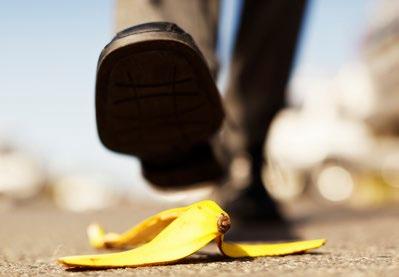
littering here and there has caused the UK’s rat population to increase by 60 million. This suddenly isn’t so mysterious when you consider that since the 1960s our annual littering has increased by an astounding 500 per cent.
It’s not a cheap habit either: UK taxpayers shelve out £500 million in order to keep our streets clean, and when you include our green spaces, that goes up to £1 billion. So, it’s not surprising that if caught fly-tipping you could face a £20,000 fine or even jail time and, if you disposed of something hazardous, the court could give you five years to serve. Regardless of how severe these punishments might seem, however, among the reported cases only 2,000 were convicted out of 825,000, so we still have some way to go in making sure people abide by the rules.
To take back our beautiful countryside and cities we need to do more than simply not leaving rubbish where it ought not to be. We need a pride makeover, we need to truly care more about the world around us. n
by Jessica Lone Summers
ENVIRONMENT 112 • FEBRUARY 2021

Expert Q&A: Allison Ogden-Newton
CEO of Keep Britain Tidy
How did you become an authority in conservation? It would be hard to live through the past decade without knowing we all have to act to save the environment. I had been looking for the means and Keep Britain Tidy gave me the opportunity and platform to help everyone protect the environment.
What are the biggest environmental challenges we currently face from littering? We need to reuse what we can and—when we buy—we need to work at recycling. Consumption is on the rise, little thought is given to how new products can and will be recycled and too few households are committed to maximising their recycling.
What does Keep Britain Tidy do to help our planet? Our annual campaign The Great British Spring Clean reaches millions of people and even in 2020 engaged hundreds of thousands of volunteers. We ecourage retailers to minimise the littering of their products and we work with consumers, retailers and local authorities to increase recycling. We have established more than 20,000 Eco schools where children are taught to make a difference.
What changes need to happen to tackle ecocide? We need leadership to set higher standards for consumerism
and recycling. It should not be possible to produce and package a product without clearly pointing to how it will be recycled in the current system. Recycling needs investment. There are great technologies out there but few local authorities can afford to install them. There should be one system for the UK, DRS—a deposit return scheme where drinks containers can be returned— needs to happen quickly and throughout our retail infrastructure, and we need investment in marketing and education to make sure everyone understands how their behaviour makes a huge difference.
What do you predict for the future if nothing changes? Fear of the environmental impact of litter is on the rise as we are learning more about the omnipresent micro plastics that have now entered the food chain. But consumerism is on the increase too and without leadership, laws, education and investment we are heading for a dystopian future where our food is no longer safe and our legacy to our children is a network of landfill sites that rival the Egyptian pyramids in size and longevity. n
Visit keepbritaintidy. org for more information

FEBRUARY 2021 • 113
Ready For Pink
Despite its sometime subtle hues, pink is often a controversial colour, but perhaps February calls for more of it?
February means Valentine's Day, and Valentine's Day is a great time to talk about my favourite colour, red! Red is strong and powerful… and a flattering colour on almost everyone. Personally, I take my red with a drop of yellow in it (on the warmer side) to suit my spring colouring.
Pink is the other colour associated with Valentine's Day, a colour I've never felt particularly at home in. Pink always felt too girly for me to wear since I don't have a particularly girly style. In recent years though, I've changed my mind, because the right shade (again, with a drop of yellow in it, such as a salmon pink or coral pink) makes me look fresh and well-rested, even if I'm not. Also, my notion of pink being a girly colour is a fairly recent one, historically.

Lisa Lennkh is a banker turned fashion writer, stylist and blogger. Her blog, The Sequinist, focuses on sparkle and statement style for midlife women
Pink, rather than blue, used to be the colour associated with boys; it was perceived as a strong colour—a lighter version of the colour red.
Fashion has embraced wearing pink and red together in recent years. At the Emmy awards last year, no less than three actresses showed up wearing bold pink and red colourblocked evening gowns on the red carpet. Only a few years before, it was considered a bit tasteless to wear these two colours together. It seems odd, since Mother Nature wholeheartedly embraces the combination. Think of all the plants, from roses to dianthus to hibiscus, that naturally pair these two colours on a single flower.
Now that I have come to think of pink as "light red" it has crept its way into my wardrobe more and more. I tend to wear a little bit of pink with other colours, just to make it feel a little less sweet. I love using it to soften earthy tones, or to add a dose of contrast to a bold leopard print. I even bought a dark-pink velvet suit a few years ago, and wear it a lot more
FASHION & BEAUTY 114 • FEBRUARY 2021

often than I ever thought that I would. And following fashion's lead, I'm even wearing my few pink items with the bounty of red that is in my wardrobe.
Some beautiful pieces in pink and red have made their way to the British high street. Wyse London


always has a few jumpers in this this very fashionable combination. Boden has a beautiful silky maxi dress in these two colours, which I have my eye on. I'm sure as the weather warms up, we'll see more of this cheerful combination that goes way beyond just Valentine's Day. n
FEBRUARY 2021 • 115
Retinol Capsules
Jenessa Williams investigates exactly what they put in those tiny pods
What Is It?
Known in the industry as the "secret to anti-ageing", retinol is a vitamin-A alcohol, commonly found in foods and dietary supplements. Ranging from the fairly mild retinyl palmitate right up to the dermatologically prescribed tazarotene, they are frequently packaged in single-use, tiny capsules that control the dosage, but can also be purchased as creams, serums or balms.
What Are The Supposed Benefits?
Offering a super-boost to cell turnover rate, it essentially refreshes your skin at a rate of a much younger complexion, reducing the appearance of fine lines, discolouration and acne. For those who experience oily skin, retinols are also thought to help regulate the production of sebaceous glands without clogging them.
However, retinol products should be treated with caution. A pea-sized amount once a week is normally plenty for beginner use, scaling slowly up to application no more frequent than every other night. Care should be taken not to mix them with other

acids or peels, but to remember to apply regular sunscreen to counteract the increased sensitivity. While a light, tingling sensation is normal, anything that burns or stings is a sign that you are using too high a dosage.
Does It Actually Work?
Though the results won’t be obvious immediately, brands such as L’Oreal Paris demonstrate that their Pure Retinol Night Serum noticeably improved skin texture within 12 weeks. The key is in the consistency— one Reddit user recently went viral sharing photos of her 78-year-old grandma’s flawless complexion, citing 50 years of retinol usage.
While individual capsule packaging might seem like something of a gimmick, buying retinols this way might offer more bang for your buck. A somewhat unstable compound, over-exposure to light can reduce a retinol product's lifespan, so opaque packaging reduces wastage and minimises cross-contamination. n
FASHION & BEAUTY 116 • FEBRUARY 2021
We are fearful of the present, uncertain of the future and longing for the past that used to be.
Even in the Blitz of World War 2 people went about life as best they could. But, the country fell silent to Covid-19
How did lockdown a ect you?
People lost their jobs and incomes, children’s schooling was interrupted, weddings were postponed and even funerals could not occur in the usual manner.
Unable to bid farewell to a loved one was one of the saddest events in lockdown. Death lives long in the minds of those who are left behind.

We saw ‘the good, the bad and the ugly’ of human nature being played out during lockdown.






Could things have been done di erently? Would they have made a di erence?
Would you have chosen to be in the shoes of the Prime Minister in handling this crisis?
LOCKDOWN 2020 touches the lives of most people. Read it and identify your life in the words of the author.


We have to accept the new normal and look after ourselves. We would then be able to return to a semblance of the quality life we had.
Will Covid-19 be the last or could it happen again? The answer is in LOCKDOWN 2020









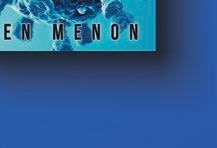





www.barnesandnoble.com

SPONSORED CONTENT

ONE NIGHT IN MIAMI
We smell Oscars in the air for this glossy yet profound masterpiece from the trailblazing Regina King
An Oscar-winning actress, King is also an outspoken advocate for the rights of marginalised communities and she made history when she became the first Black female director whose film was selected to premiere at the Venice Film Festival. The film in question is One Night in Miami—a fictionalised account of a meeting between Malcolm X, Sam Cooke, Jim Brown and Muhammad Ali to discuss their roles in the civil rights movement. The film kicks off with a punchy introduction to these icons, going through different phases of their lives: Ali emerges as the new Heavyweight Boxing Champion of the World, while Brown,
the legendary NFL running back contemplates a career in Hollywood.
Despite the enormous status and egos of all four characters, and the “boys’night-out”-sounding title, the film is very much a subdued, low-key chamber piece, confined mostly to a small hotel room, where the colourful foursome joke and dance in a prelude to a heated, personal tear-down based around the civil rights movement, and their individual roles in it.
The film has it all: nuanced, timely discourse around racial issues, delightful chemistry between the four celebrities and their vastly different personalities (the verbal sparring between the trashtalking Muhammad Ali and levelheaded Malcolm X deserves a film on its own), and a delicious 1960s setting, abundant in old Cadillacs, eye-popping suits and great music.
READERSDIGEST.CO.UK/CULTURE 118 • FEBRUARY 2021
© AMAZON ORIGINAL
FILM H H H H H
Further viewing…
MALCOLM X (1992)
The glimpse of Malcolm X we get in One Night in Miami is such a minuscule snapshot of this prolific man’s short, yet remarkable life, that you might find yourself hungry for more. If that’s the case, head straight for Spike Lee’s tour de force biopic, Malcolm X, starring Denzel Washington. Here, we meet a much younger Malcolm—he’s a sharp-dressing, cokesnorting, womanising thief (all captured with Lee’s heady cinematic gumption) whom we accompany on wild nights out and increasingly high-stakes robberies. He eventually lands himself in prison, where he discovers the teachings of Islam and—after serving his six-year sentence—re-emerges as a Muslim man, preaching the message of the Nation of Islam and ardently fighting for Black empowerment, becoming a highly controversial public figure. The rest is history: his dramatic falling out with the NOI movement, marriage to Betty X, momentous pilgrimage to Mecca and the tragic assassination in 1965.

With a run time of 3 hours 22 minutes, it’s quite an epic journey to go on, yet a crucial one if you’re looking to fill some gaps in your knowledge of the civil rights movement and learn more about this powerful and conflicted figure that changed history. But don’t worry: Spike Lee has always been a showman first and foremost, setting this heavyduty biopic on fire with fantastic music, electric dance sequences, crisp dialogue and pulse-raising Russian roulette scenes. As stirring as it was 30 years ago, Malcolm X will doubtless continue to stand the test of time for decades to come.
by Eva Mackevic
PICTORIAL PRESS LTD / ALAMY STOCK PHOTO
FEBRUARY 2021 • 119
You can see why the BBC held back We Are Who We Are (iPlayer)—Luca Guadagnino’s idiosyncratic portrait of life on a US Army base near the Italian coast—until midwinter. The opening episodes are bathed in such warming Mediterranean sunlight, viewers could probably get their daily Vitamin D dosage by sitting close to the TV. This isn’t a show for anyone seeking relentless plot turns; as in his celebrated Call Me by Your Name, Guadagnino wants us to inhabit the moment, alongside his muddleheaded teen leads. Still, it’s a vivid evocation of a transitional phase.
Another recent US buy-in, Awkwafina Is Nora from Queens (iPlayer), grew on me: it starts from a stale-sounding sitcom set-up—messy 30-something singleton has to move back in with her family—but moves in amusingly eccentric directions, chasing after some of TV’s nicest personalities.
Retro Pick:
Jeopardy! (Netflix)
Awkwafina, the former rapper who starred in 2019’s touching comedydrama The Farewell, is apparently making it her life’s mission to recentralise grandmothers in popular culture; the show gets bonus points for inventing dronuts (“cronuts delivered by drone”).
Two episodes in the third run of David Letterman’s My Next Guest Needs No Introduction (Netflix)— those featuring Kim Kardashian and Robert Downey Jr—were filmed in early 2020, which means we get introductory hugs in front of an effusive studio audience. The other two—with singer Lizzo and comedian Dave Chappelle—were filmed midpandemic, which means masks and social distancing. This series now has historical value, to go with its considerable entertainment value: to watch it is to see TV adapting to a new normal.
 by Mike McCahill
by Mike McCahill
Following the sad passing of legendary host Alex Trebek back in November, Netflix UK have expanded their collections of the longrunning televisual touchstone—the quiz show that gives us the answer, and asks us “what is the question?”

TELEVISION
120 • FEBRUARY 2021
@BBC IMAGES
Album Of The Month:
Lost Themes III: Alive After Death
by John Carpenter
It may not be October anymore, but Halloween is never over for the horror movie maestro, John Carpenter. Some may not know this, but not only is Carpenter the director of some of the greatest horror classics like Halloween and The Thing, but he also just happens to be the founding father of modern electronic music, whose soundtracks are just as iconic as the movies themselves. His latest offering sees him teaming up with his son Cody Carpenter and godson Daniel Davies, making the album very much a family affair. Featuring spine-chilling synths, ominous high arpeggios and great beats, it’s a spooky yet brisk record that—depending on what you’re into—can mentally place you amidst a zombie apocalypse or at an east London rave in an abandoned warehouse. Perfect for fans of retro electronic music and 1980s slasher films.
by Eva Mackevic
Love Is In The Air
With song titles like “Dripping Blood” or “Cemetery”, AliveAfterDeathmay not be the most romantic music offering out there. But if you’re in the market for something that’ll make you swoon this Valentine’s Day, these classic records are bound to do the trick…
Let’sGetItOn by Marvin Gaye
Intense yet smooth, mellow yet arresting—
Let’s Get It On is considered to be one of Gaye’s greatest records, and one that established him as a sex symbol.

LoveDeluxeby Sade
Nothing says “romance” like the silky vocals of Sade—and this luxurious record about heartache and desire is one of her best.
Afrodisiacby Fela Kuti
A raw, stimulating mixture of African music and funk, you can always count on Fela Kuti if you’re after something a bit more invigorating than soft R&B.
Avalonby Roxy Music
One of the most expressive keyboard players and singers of all time, Bryan Ferry’s craft is arguably at its most exquisite on this beautiful record.
I’mStillinLovewithYouby Al Green
Al Green is associated with “baby-making music” to the point of cliché. But clichés are clichés for a reason, and this sultry record, oozing warmth and sensuality, is the proof.
MUSIC FEBRUARY 2021 • 121
February Fiction
Both heartening and heart-breaking, our literary pick this month offers sensitive insights into childhood, chance encounters and how we can live our best lives
Towards the end of Francis Spufford’s brilliant new novel, Jo, one of the five main characters, looks back on her life as she nears 70—and realises how much of it has depended (as lives so often do) on pure chance. Had she not happened to be in certain places at certain times, it would all have been very different.
In Jo’s case, though, the role played by chance is even bigger than she knows, because, as we learn in the first chapter, she actually had no life at all after the age of three. Light Perpetual opens in 1944 with a V-2 rocket landing on a south London branch of Woolworth’s, where it kills scores of people, including five three-year-olds instantly deprived of a future. The rest

James Walton is a book reviewer and broadcaster, and has written and presented 17 series of the BBC
Radio 4 literary quiz
The Write Stuff

of the book then restores it to them by imagining the lives they might have lived: visiting them at school in 1949 and, after that, every 15 years until 2009. This method gives Spufford the chance to throw in plenty of illuminating post-war social history. The London docks that dominated the local area in 1949 gradually disappear— along with such things as conductors on buses, smokers on buses, Fleet Street print workers and Fleet Street. Yet, while the wider historical changes do affect his characters, Spufford makes all five resolutely individual, with
BOOKS
Light Perpetual by Francis Spufford (Faber, £16.99)
122 • FEBRUARY 2021
domestic circumstances that range from the contented to the rackety— sometimes for the same person over the years. He’s great as well at showing how our various younger selves don’t ever quite disappear, but instead coexist with our older ones.
The result bears some resemblance to the celebrated Up TV documentary series, which has now followed one group of people from the age of seven to 63. Spufford, too, invites us to consider how much of our essential personalities we already have as children—and what makes for a welllived life. There’s also the same kindly tone and awareness that, on the whole, most people do their best.
Except, of course, Light Perpetual has the heartbreaking twist that the lives Spufford describes so richly—including those of the central characters’ children and grandchildren—were, by pure chance, not allowed to take place.
Name the author
Can you guess the writer from these clues (the fewer you need the better)?
1. The main character in her only novel is called Esther Greenwood…
2. …but she’s better known as a poet, especially for the 1965 collection Ariel, published two years after her death.
3. She was the first wife of the man who became Poet Laureate in 1984.
Answer on p126
Paperbacks
Letters on Motherhood by Giovanna Fletcher (Penguin, £8.99).
Written with all the honesty, warmth and good humour that won her the last series of I’maCelebrity…
GrownUps by Marian Keyes (Penguin, £8.99). Keyes explores the messy lives of three adult siblings in her usual hugely enjoyable and perceptive way.
AMarvelousLife:TheAmazing StoryofStanLee by Danny Fingeroth (Simon & Schuster, £9.99).
If you’ve ever wondered how comicbook heroes conquered the world, this terrific biography of the creator of Spider-Man, BlackPantherand many others should help.
Pilgrims by Matthew Kneale (Atlantic, £8.99).
A (very) mixed bunch of medieval English people head to Rome in a novel that brings the period alive vividly and (very) entertainingly.
On the Road: Adventures from NixontoTrump by James Naughtie (Simon & Schuster, £9.99).
Naughtie draws on decades of covering American politics in a book bulging with memorable stories.
FEBRUARY 2021 • 123
READER’S DIGEST RECOMMENDED READ:
Surviving Auschwitz
One teenage boy’s long-lost account of the horrors and occasional glimmers of lights of life in a concentration camp
When 16-year-old Thomas Geve came to London after the war, he brought with him a written account and large collection of drawings detailing his time in Auschwitz. Desperate for the world to know what he’d seen, he approached some publishers, only to be told that “audiences are looking for more cheerful topics nowadays”.
As a result, his account wasn’t published until 1958—and only as a small, pictureless pocket book. Now, with this fully updated and illustrated edition (coming out just before Holocaust Memorial Day), he finally gets the book he deserves.
Thomas’s father left Berlin for London in 1939, expecting his wife and son to join him. But then Britain declared war on Germany, and they were left stranded as the oppression and eventually the deportation of Jews intensified.
On their arrival in Auschwitz in 1943, Thomas and his mother were immediately separated, with him

being sent to the camp’s bricklaying school, overseen by a gruff but not unfriendly block-elder, a fellow inmate. The story that follows is certainly not without its horrors and staggering cruelty both systematic and casual. Yet, at the same time, it’s clearly the testimony of a typical, if unusually bright and curious, teenage boy. Thomas makes some good friends. He does his best to ogle any women he can find. He takes understandable pride in his ability to sometimes outwit the guards (thanks to the updating, we also find out about a later victory:
BOOKS
124 • FEBRUARY 2021
that the bricklaying skills he learned in Auschwitz were later used to help build Israel).
Here, in late 1943, he’s about to receive some astonishing news…
One day, a tall, friendly Pole came to see me. ‘I know that your block-elder doesn’t like strangers here, but I had to see you personally,’ he said in broken German.
His self-confidence impressed me even before I knew the reason for his visit. We went to a quiet corner and there he produced a carefully folded little slip of paper.
‘This is for you. I have to get out of here. So goodbye, good luck!’
Unwrapped fold by fold, the smudgy sheet revealed a pencilwritten message. I looked at the signature. There was no mistake about it: ‘Your Mother’.
I was flushed with excitement. I had never given up the belief that Mother was close by. She was alive! It was as close as I had come to experiencing a miracle in this hellhole. There was a double reason for rejoicing. Someone had found my mother and some noble stranger had risked his life to smuggle in a message from the women’s camp at Birkenau. We knew that Birkenau was a camp of mass murder. The very mention of it sent shivers down one’s spine, and if you were caught with any kind of message, you would be killed.
The note said that next week a group of women, which would include my mother, was to pass through our camp. Nearly all the roommates were eager to come along with me to welcome her. More than the sight of my mother, it was the idea of seeing ‘women’ that attracted them. However, they were to be desperately disappointed, as the block-elder, fearing trouble from the SS guards, decided that only the room-elder and I were to see her.
It was a week of almost unbearable waiting and so many questions. I wondered what Mother would look like. Would I recognise her? Would she recognise me? Would this dream really come true and would we really meet?
The room-elder and I, carrying baskets under our arms for the supposed purpose of fetching the rations, walked down the main street. We saw a column of women in striped dresses, with bleak kerchiefs on their heads, being led along by armed grey-uniformed SS women.
We had expected to see glamorous
The Boy Who Drew
Auschwitz by Thomas Geve is published by HarperNonFiction at £18.99

FEBRUARY 2021 • 125
‘‘
READER’S DIGEST
females, but they turned out to be miserable prisoners like ourselves. Exhausted veterans rather than women. Their suffering was written all over them. I was shocked at what I saw, and hardly recognised my mother. Still in her late 30s, Mother looked as haggard as her companions. Without either of us slowing our stride, we touched hands. I managed to sneak a kiss. To hold her hand again was an unimaginable, miraculous moment. I would never forget that. Mother managed to express her hope that my work was not too hard. She rummaged beneath the rags that clothed her to pull out some bread she had saved. But as I refused it, the guard stepped in to chase me away. Our encounter had lasted barely 15 seconds.
Thomas never saw his mother again. Once in London, he learned that she’d died in Auschwitz a few months afterwards ’’
And the name of the author is… Sylvia Plath—whose only novel was the autobiographical The BellJar, about a young woman with mental health problems. Plath’s husband was Ted Hughes.


Berlin in the early 1940s
“Hitler’s cruel laws penetrated everywhere. Confiscation orders were extended to warm clothes, radio sets and pets of non-Aryans. Our aquarium and parakeets had already been abandoned, so Hitler’s attention now turned to Grandfather’s cherished crystal set.
Grandpa Julius had been blinded while serving as an officer in the Kaiser’s army in the First World War. When in a jovial mood he would sing to me a sentimental song about fallen comrades. I had once read him the newspapers, but now his only pleasure was listening through earphones to the 15-year-old cat whisker radio set.
We sent a letter to the War Veterans Federation begging their intervention to let Grandpa keep it. The reply was sympathetic but to no avail. Jews were not allowed to have a radio. There could be no appeals against the orders of the Reich.
Grandpa died on 19 March 1942, at the age of 71, unable to understand the new ways of his fatherland.”
BOOKS
***
126 • FEBRUARY 2021
Books
THAT CHANGED MY LIFE
British thriller writer CJ Tudor’s first book, The Chalk Man, was a Sunday Times Bestseller. Her hotly anticipated second novel, The Burning Girls, is available now (Michael Joseph, £12.99)

The Owl Who Was Afraid of the Dark
by Jill Tomlinson
My copy of this book is so well-worn. As a child I was scared of everything, which is surprising considering the books I now write. I would always imagine monsters under the bed, the door in the bedroom had to be left open a crack and I would have the covers right over my head… Reading this book really helped, and it was the first book I read for comfort. It’s about an owl who is scared of the dark and each chapter has him meeting someone who tells him something about why dark is a nice thing. I bought a copy for my own little girl, but she hasn’t really read it—she’s much less afraid of things than I was.

Only Forward
by Michael Marshall Smith
I remember reading the opening to this book in WH Smith’s, which you’re not really meant to do, but it had such a striking prologue—a little boy opening the door to a man with no head—that I bought it. I was in my early twenties and writing for a living, so I wasn’t spending much time writing for me, but this reinspired me. It’s a bizarre book, but imaginative and creative. At its heart it’s a thriller and it’s got this stream of really dark humour, which Michael Marshall Smith is so good at injecting. His writing really spoke to me—there would be moments where I was laughing out loud, but he also writes emotion really well. It made me look at writing in a different way because of the way he mashed up genres. I’m still a massive fan of his writing.
The Chalk Man
by CJ Tudor
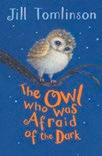

I didn’t knuckle down to write until my thirties, and then I didn’t get published until I was 46. So, like a lot of writers, I had dealt with rejection and trying to get better and find my own voice. When The Chalk Man got published it changed my life because I had gotten to the point that I thought it might never happen, and then it was really successful, and published in 40 countries, which was bonkers! I was working as a dog walker before and my family didn’t have much cash, but my world changed within just two weeks. My whole life opened up.
FOR MORE, GO TO READERSDIGEST.CO.UK/CULTURE FEBRUARY 2021 • 127
Auto-Smart
James O'Malley on the practical benefits of connecting your smartphone to your in-car entertainment system
The chances are that the phone in your pocket is no more than three or four years old. The rapid pace of technological change demands, even if we don’t consider ourselves technophiles, that we must regularly upgrade our phones so that we can run the newest apps and use the new hardware features that very quickly become a part of our everyday life.
The same technological pressures apply to cars but it happens at a much slower pace. Most people do not drive brand new cars. And it isn’t unusual to see cars in regular use that are ten, 20 or even 30 years old.
This creates something of a technological disconnect: as phones control ever more aspects of our lives, how can cars keep up with the latest technology? If you buy a car today, how can you be confident that it will still be able to connect to the phones of the future so that we can play music or use satellite navigation? In 2016, Apple and Google figured out an ingenious
solution. They realised that instead of trying to build super-sophisticated in-car entertainment and navigation systems that would inevitably quickly fall out of date, instead they could do the opposite, and effectively make them dumber.
The idea is simple: all of the clever stuff—the apps which have our music and contain our maps—are run not by the computer inside our car, but by the phone that has been plugged into it. It’s a bit like plugging a Sky box or a DVD player into a TV: the external box is doing the clever stuff, the TV is just showing the picture that the box is sending it.
If you plug your phone into a car with Apple’s CarPlay or Google’s Android Auto, the screen on the central console will transform into something that looks more like your phone’s home screen. In one sense, that’s in fact exactly what it is.
Any apps you have installed on your phone that are car-compatible, such as Spotify and Google Maps, will appear, and can be controlled through the touchscreen. The best
128 • FEBRUARY 2021
TECHNOLOGY
part? Because the apps are running on your phone and not the car, you won’t need to worry about logging in or telling the app where to set as your “Home” location, as it will already know.
And your “car” will, in effect, have an internet connection through your phone—meaning that your satnav application will know which roads are experiencing congestion, and can plan your journey based on realtime information.
The two systems also work with voice commands, using microphones in the car to control Siri and the Google Assistant. So as you’re driving you can say, “Text John to say I’ll be there in ten minutes”, and your phone’s more sophisticated voice recognition algorithms will both figure out who the “John” you are referring to is, by looking at your contacts, and more accurately transcribe the message. All without you needing to look at the screen or take your hands off of the wheel.

Today, after a slow start, CarPlay and Android Auto can be found in a significant proportion of all new cars—all the way from a Vauxhall Corsa and Ford Focus to Bentleys and Aston Martins.
The upshot of this approach is exciting for the future too. Even though the technology is still new today, it means that in 20 years when our grandchildren are buying an oldbanger from 2020, instead of being lumbered with the equivalent of a cassette player in a world where MP3s are the norm, the chances are that even when they connect their iPhone 32 to the car, they’ll immediately be able to use all of the apps they need—even if they haven’t been invented yet. n
What makes CarPlay and Android Auto truly brilliant though, is that it means that your in-car entertainment system will improve every time you get a new phone, or even when your phone receives a software update. So that, for example, if your favourite navigation app adds a new feature, you can get it in your car immediately. No need to wait several years and spend thousands of pounds to get a new car that can do the new thing!
FEBRUARY 2021 • 129
You Couldn’t Make It Up
Win £30 for your true, funny stories!
Go to readersdigest.co.uk/contact-us or facebook.com/readersdigestuk
In the foyer of our church, my son was looking at a plaque with the names of men and women who had died in various wars. He asked me who these people were. I retorted that they were members from our Church who had died in the service.
My son thought about this for a moment and then said, "The morning or the evening service, Mum?"
DEENA HARDING, Cambridge
My husband had to fill out a form for his work to update their files. It seemed to take an eternity but he didn't want my help, so we agreed that I would check the form when he'd completed it.
Everything was correct except for the question, “Who should we contact in an emergency?”
He'd written, “The police”. He's definitely daft!
JANE WHITAKER Kent
We were looking after our granddaughter when she was small. At dinner time my husband placed
some pizza on the table. She took one look and asked what it was.
Upon being informed that it was pepperoni pizza, she firmly pushed it away while crossly remarking, “I don’t like pepper.”
Then after a pause, “And I don’t like oni either.”
MYFANWY PICKETT, Hampshire
A row was brewing in a queue outside one of our local shops when some teenagers were accused of not keeping their distance. Cool as a cucumber one of them—an apprentice joiner, as it turned out— whipped out the tape measure he always carried in his pocket.
He and his brother were a good eight feet away from the complainant, who was only five feet away from the next person in line. Quod erat demonstrandum!
MAGGIE COBBETT, Yorkshire
My brother does not approve of giving flowers as gifts. But the one time I was recuperating after an
130 • FEBRUARY 2021
FUN & GAMES

"HAPPY SAINT VALENTINE'S DAY!"
operation, knowing how much I loved lillies, he brought me a bunch.
Although not before saying, “I found some beautiful things and killed them, just so you can watch them decay.”
LEONA HECKMAN, Denbighshire
My mother-in-law complained that the professional photograph she had had taken of herself recently did not do her justice. She showed it to my father-in-law.
He simply commented, “You don't need justice. You need mercy!”
ALEXA MILLWARD, Flintshire
My son asked me what I would like for Christmas. I replied that I'd like a
cheap gadget for measuring how far I walk. He came back asking if I would like a long tape measure or a wheel on a stick!
MARION RAWLING, Coventry
A pal of mine is planning a holiday to Madeira and keeps looking at a website that shows live views of Funchal. This also shows the current time and temperature. She told me that having looked at this for several weeks she was a bit concerned about the weather being awful as next to the temperature and time it always stated "wet".
I had to explain to her that it actually stood for Western European Time and not constant rain!
LIZ TUBBY, Norfolk
I said to a child in my class during an English lesson “Do you know how to spell ‘banana’?”
She thought for a moment and then replied, “Yes I do. But I just don't know when to stop.”
JENNY
HAWARDEN, Denbighshire
When my daughter was only two she was looking curiously at the Nativity set that we had just arranged of Jesus nestling in the manger, surrounded by the usual scene.
"Baby Jesus!" she exclaimed. "In his car seat!"
JUDITH, London
FEBRUARY 2021 • 131
cartoon by Guto Dias





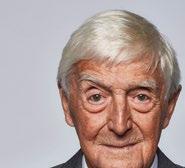







YES I want to subscribe to Reader’s Digest Magazine for just £3 for 3 issues (a saving of £8.37 on the shop price of £11.37 based on the cover price of £3.79 per issue). I understand that if I do not wish to continue receiving Reader’s Digest after my first 3 issues I can simply cancel my subscription by contacting customer services. If I do want to continue to subscribe after my first 3 issues I need do nothing and my subscription will automatically be renewed at the low rate of £7.50 for every 3 issues until I decide otherwise. Name:



HEALTH • MONEY • TRAVEL • RECIPES • FASHION • TECHNOLOGY SMALL AND PERFECTLY INFORMED JANUARY2021 “I Don’t Think I Ever Behaved Badly In Public” Sir MICHAEL PARKINSON GARY NUMAN On Autism, Anxiety And Alan Patridge MONEY ON MY MINDMental Health MONEY HEALTH • MONEY • TRAVEL • RECIPES • FASHION • TECHNOLOGY READER’S DIGEST | SMALL AND PERFECTLY INFORMED DECEMBER2020 CHRISTMAS AT HOMEHow COVID Is Shaping Festivities TIM MINCHIN On MarriageMusic,& & Your Finances DAVID BAILEY On LifeLivingBehind Please complete direct debit mandate below Name of Bank ...................................................................... Account Holder Branch: / / Account No Instructions to your bank or Building Society: Pay Reader’s Digest Direct Debits from the account detailed on this instruction subject to the safeguards assured by the Direct Debit Guarantee. I understand that this instruction may remain with Reader’s Digest and if so will be passed electronically to my Bank or Building Society.
..................................................................... Date .............................................................................. INSTRUCTIONS TO YOUR BANK OR BUILDING SOCIETY TO PAY BY DIRECT DEBIT. Originators reference: 400162
Signature
Address: Postcode: Telephone: Email: Each must-read monthly issue covers life, culture, health, books, films, food, humour and travel alongside in-depth news features, memoirs and celebrity profiles. It’s
world’s favourite magazine! Sort Code Data Protection: From time to time Reader’s Digest may contact you with details of its products and services. Please tick here if you object to receiving such information Return your completed form to: Reader’s Digest, The Maltings, West Street, Bourne PE10 9PH Or call us today on 0330 333 2220 Quoting code RDN083 3 ISSUES FOR JUST £3! HEALTH • MONEY • TRAVEL • RECIPES • FASHION • TECHNOLOGY READER’S DIGEST SMALL AND PERFECTLY INFORMED FEBRUARY 2021 FEBRUARY 2021 £3.99 readersdigest.co.uk The Crisis Facing Our Care Homes THE HOMESNURSINGSCANDAL WINTER HEALTH WOES And How OvercomeToThem6 CALL OF THE WILD Bringing Wolves, Bison And Vultures Back To Europe SHAKIN’ STEVENS The Chart Star On His Cardiff Childhood
never been easier to enjoy the
Word Power
This month, why not fire up your competitive spirit and tackle these terms used to describe Olympic action?
BY ROB LUTES
1. swingy ice—A: ice required for figure skating. B: a momentum change in hockey. C: ice that causes curling stones to curve greatly.
2. crud—A: homemade “speed wax” for snowboards. B: uneven snow that’s difficult to ski. C: strippeddown sled used by skeleton athletes.
3. McTwist—A: steep curve on a ski run. B: quadruple spin in doubles figure skating. C: snowboarding move involving a front flip and spin.
4. yard sale—A: crash that scatters skier’s equipment. B: ambitious freestyle skiing jump. C: last-minute push by a losing hockey team.
5. haircutter—A: aerodynamic luge helmet. B: figure-skating spin in which free leg is brought near head. C: minor head injury in hockey.
6. hack—A: foothold used by curlers to push off when throwing stone. B: shell used by luge athletes as a seat. C: backhand shot in hockey.
7. eighty-one—A: in bobsledding, to crash. B: in biathlon, a perfect run. C: in speed skating, to pass on the inside.
8. loading—A: biathletes starting at the same time. B: bobsled team jumping into sled. C: using heavier skis for increased velocity.
9. Kreisel—A: classic landing stance in ski jumping. B: steepest portion of downhill ski course. C: long, circular turn on luge course.
10. schussing—A: straight highspeed downhill run. B: speed skater coasting past competitors. C: crosscountry skiing in heavy snow.
11. hardgoods—A: bumpers that protect skeleton competitors from the wall. B: extremely icy snow. C: skiing and snowboarding gear.
12. huck—A: bobsled-steering device. B: snowboarder launching off a jump. C: hard curling throw.
13. rocker—A: one-foot turn in figure skating. B: bobsled shock absorber. C: push-style curling broom.
14. steels—A: speedskate blades. B: luge sled runners. C: shoe spikes.
15. chatter—A: metal teeth on bobsled brakes. B: audience noise levels in indoor areas. C: vibration in skis when travelling at fast speeds.
FEBRUARY 2021 • 133 FUN AND GAMES
IT PAYS
TO INCREASE YOUR
ANSWERS
1. swingy ice—[C] ice that causes curling stones to curve greatly. The Chinese team’s young skip was unable to defeat the swingy ice.
2. crud—[B] uneven snow that’s difficult to ski. Battered by a frigid wind, the hill was covered with crud.
3. McTwist—[C] snowboarding move involving a front flip and a spin. Luciano could only muster a mediocre McTwist on his final run.
4. yard sale—[A] crash that scatters skier’s equipment. The treacherous course led to more than one yard sale from the world’s top skiers.
5. haircutter—[B] figure-skating spin in which free leg is brought near head. Atsuko’s haircutter was a crowd-pleaser.
6. hack—[A] foothold used by curlers to push off when throwing stone. Hannah braced against the hack, looked to the bleachers and smiled at her father.
7. eighty-one—[A] in bobsledding, to crash. It was shaky nerves, not the difficult course, that caused Tomas to eighty-one on his first run.
8. loading—[B] bobsled team jumping into sled. Known for its fast starts, the German squad had the best loading technique.
9. Kreisel—[C] long, circular turn on luge course. Negotiating the Kreisel required extreme care, and Nodar was well aware the race could be won or lost on this one turn.
10. schussing—[A] straight highspeed downhill run. The Austrian knew his only chance lay in schussing—even at the risk of crashing.
11. hardgoods—[C] skiing and snowboarding gear. A member of the national ski team, Kelly enjoyed having her hardgoods supplied for free.
12. huck—[B] snowboarder launching off a jump. Fearless, Siegfried didn’t hesitate to huck the seven-metre cliff.
13. rocker—[A] one-foot turn in figure skating. The ankle injury hobbled her routine, from the triple Axels down to the rockers.
14. steels—[B] luge sled runners. Before a competition, Adolfine spent as many hours sanding the steels as she did training.
WORD OF THE DAY*
HAUSSMANNIZE
Rebuild Alternative suggestions: "The making of a house husband"
15. chatter—[C] vibration in skis when travelling at fast speeds. The moment Chalmers felt his skis chatter, he knew he had lost time and, probably, the race.
VOCABULARY RATINGS
7–10: fair
11–12: good
13–15: excellent
*POST YOUR DEFINITIONS EVERY DAY AT FACEBOOK.COM/READERSDIGESTUK
134

Making it count
After spending far too much time on apps and social media over the last few years, Gemma decided it was time for a change.
“I’d started to get really frustrated with how I was spending my spare time”, said Gemma, 54 from London. “One day, I realised I’d checked my phone over 100 times. Something had to give.”
“So, I deleted my social media apps from my phone and made a promise to myself to do something more positive with my time.”
At first, it wasn’t easy for Gemma to find things to do.
“I’m embarrassed to admit that I’d stopped reading as much over the last couple of years. But, then a friend recommended Readly to me. I’d always loved reading magazines and thought it was time to give them a go again.
The selection is amazing: food, fitness, lifestyle, culture, crafts and

hobbies are all covered. I’ve been using Readly in the evenings to relax instead of watching TV. I’ve also found it great for inspiration and ideas for new recipes. We’ve been doing some re-decorating, so the interior design section has been really helpful. Having so many past issues to browse through is just fantastic. I can’t think how much I would’ve had to spend to get all that content. If you read more than a couple of magazines, you’ll be saving money each month.
My husband loves the car, sport and business magazines. And we cuddle up and do the puzzles and crosswords together now as well!
As it’s a family membership, I’ve shared my subscription with my daughter who has started using it. She’s a teacher and loves getting inspiration from the kids news, science and history magazines.”
To find out more about Readly, and to try 1 month for free, please go to www.readly.com/digest
PARTNERSHIP PROMOTION
Brainteasers
Challenge yourself by solving these puzzles, then check your answers on p139
Crossed Letters
Place either A, B, C or D into each of the 25 empty cells so that the number of times each letter appears in a given row or column is as indicated by the numbers beside or above that row or column. Identical letters cannot be next to each other in the grid, either horizontally or vertically. Can you complete the grid?
How About A Date?
We’re in the month of February. Based on the following statements, what is today’s date?
n Tomorrow’s day of the month is a factor of the day of the month a week before tomorrow.
n Yesterday’s day of the month is a factor of the day of the month a week before yesterday.
n February 3 has passed.
136 • FEBRUARY 2021 A 2 0 2 1 1 B 1 1 1 1 2 C 2 2 1 1 1 A B C D 0 2 1 2 1 2 1 1 1 1 0 3 1 0 1 2 2 3 2 0 0 0 2 1 2
(Crossed Letters) Fraser s impson; (How a bout a d ate?): d arren r igby
Balance The Books
Eli is distributing some donated books to a small group of kids. He sees that if he gives a book to each child, then he’ll have a book left over. He also sees that if he were to give two books to each kid, then one of them wouldn’t get any (so he won’t do that). How many books are there, and how many children?
Take Five
This grid, when completed, contains one 1, two 2s, three 3s, four 4s and five 5s. All the cells marked with the same numeral are in a connected group where each of them has at least one full side—not just a corner—touching another. (This doesn’t apply to the 1, of course, since it is alone.) There is never a two-by-two square of cells with the same numeral. Some numerals have been given. Can you fill in the rest?
Pipe Down
Build your own water-supply system! The BASE level is on the bottom, and the STREET level is on the top. Your job is to figure out how to place the other two levels in between them so that all the pipes connect. The black and grey circles are where pipes extend upward, and the blue circles indicate where they extend downward. Levels A and B may need to be flipped over, rotated or both before they’ll fit. If the BASE is oriented correctly as drawn, which corner of the diagram will the house be in?
FUN & GAMES FEBRUARY 2021 • 137 4 4 1 2
B
BASE A STREET HOUSE
( b a L an C e t H e b ooks) e mi L y g oodman; ( t ake Five, p ipe d own) d arren r igby
CROSSWISE Test your general knowledge. Answers on p142 BRAINTEASERS ACROSS 7 Person who mends shoes (7) 8 Sluggishness (7) 10 Retaliation (8) 11 Decline (6) 12 Improvise (4,2) 13 Recently married (5-3) 14 Close mental application (13) 17 Allergic rhinitis (3,5) 20 Seldom (6) 22 Emitting a strong odour (6) 23 Unfasten (8) 24 Experience (7) 25 Throw loosely about (7) DOWN 1 Capital of Kansas (6) 2 Scotland’s “Granite City” (8) 3 Land along the coast (8) 4 One of the 12 apostles (6) 5 Cunning (6) 6 Physicist (8) 9 Astronomical model (11) 14 Delightful (8) 15 Vigorous exercises (8) 16 Annoy (8) 18 Boneless slice of meat (6) 19 Journey (6) 21 Make less tight (6) 138 • FEBRUARY 2021
BRAINTEASERS ANSWERS
Crossed Letters
Arithme-Pick
Place one of the four basic arithmetic operations (+, –, ×, ÷) in each box to make a correct equation. Symbols may be repeated, and you don’t have to use all four. All operations are performed from left to right, ignoring the mathematical order of operations. The result at each step must be a positive whole number. What’s the equation?
How About A Date?
It’s February 5.
Balance the Books
There are four books and three children.
Take Five
ROLL OF THE DICE
Pipe Down
The lower right. B, flipped and rotated, goes on the BASE, and A, flipped and rotated, goes on top of B.
41. There are 21 dots on each die, thus a total of 63 dots on the three dice. Since 22 dots are visible, the total number of dots on the sides that are not visible amounts to 41.
READER’S DIGEST
THE £50 GOES TO… JUNE CAIELS , Plymouth
FIRST CORRECT ANSWER WE PICK WINS £50!* ANSWER TO JANUARY’S PRIZE QUESTION £50 PRIZE QUESTION
excerpts@readersdigest.co.uk FEBRUARY 2021 • 139
AND
THE
Email
A C A D B C D C A C B C D C D A B A B A C D B D B 3 3 3 4 4 4 5 5 4 2 5 1 2 5 5
5 7 3 9 4 = 32
Laugh!
WIN £30 for every reader’s joke we publish!
Go to readersdigest.co.uk/contact-us or facebook.com/readersdigestuk
The Isle of Dogs is the Isle of Man’s best friend. Comedian PHIL SWALES
My local pub does amazing beerbattered cod that doesn’t contain milk, eggs, flour or cod and you can drink it straight from a glass.
Seen on Twitter
Ah, yes. Another day of staring at the big screen while scrolling through my little screen so as to reward myself for staring at the mediumsized screen all week.
Seen on Twitter
Whoever invented zorbing must really be rolling in it.
Comedian OLAF FALAFEL
If condensation ruined the last photo you took of yourself, raise your phone a little higher. You’re suffering from low selfie steam.
Comedian SANJEEV KOHLI
I used to subscribe to a magazine for people with spinal problems. I don’t anymore, but I’ve still got the back issues.
Comedian GARY DELANEY
A wife stood in front of a mirror then turned to her husband and said, “I feel old, fat and ugly—pay me a compliment”
Her husband looked up and said, “Well. Your eyesight is spot on!”
JENNY MACKENZIE, via email
140 • FEBRUARY 2021
FUN & GAMES
Why is lettuce the most loving vegetable?
Because it’s ALL HEART! Seen online
Amazon review: This telescope is terrible. I couldn’t see a thing out of it. No stars. Seen on Twitter
I’m not saying I was geeky at school, but I once turned a picture of a topless woman upside down to see if it said 58008. Submitted via Twitter
It’s mad that contestants on I’m A Celeb say that their biggest fears are “creepy crawlies” and “heights” instead of “chocolate milkshake” or “having my fee randomly doubled.”
Comedian RHYS JAMES
My grandad always used to say to me, “pint, gallon, litre, cubic inch,” which I think speaks volumes.
Comedian OLAF FALAFEL

THIS HUSBAND SENT HIS WIFE THE SEXIEST PHOTOSHOOT HE COULD FOR VALENTINE’S DAY via boredpanda.com

The trouble with getting a job in bomb disposal nowadays is that it’s all about ticking boxes.
Comedian TONY COWARDS

FEBRUARY 2021 • 141
Sexy Shoot
God: I’ve invented wind.
Adam: I don’t like it.
God: Well it’s only the first draught…
Comedian ANDY RYAN
I’ve decided to get involved in the snow globe industry, just to shake things up a little.
Seen on Facebook
People used to call me an attention seeker. Well, LOOK AT ME NOW!
Comedian GEORGE RIGDEN
I went along to that restaurant where you eat in the dark last night. It really is incredible, it really heightens your sense of how annoying other people’s conversations can be.
Seen on Facebook
Roses are red, violets are blue, that thing you’re into is what Meatloaf won’t do.
Seen on Twitter
Just a warning if you’re planning to buy a new watch soon. I learned the hard way that if it says you can swim with it, this only applies if you can already swim without it.
Submitted via email
I remember when my dad caught me curing a piece of salmon. To teach me a lesson he made me smoke the whole packet. Seen on Twitter
CROSSWORD ANSWERS

My Worst Break Up
Twitter users find the funny side with these stories of their most awkward breakup
@MikeFeeneyPXP: My ex emailed me to say that it was over, waited, got impatient, called me and said, “You should check your email”, then hung up.
@Ang4ND1: I broke up with my boyfriend, but he was so drunk that he forgot and turned up the next day to hang out with me. I had to break up with him twice.
@RyanMarbles: My girlfriend dumped me while I was paying for pizza and the delivery person felt so bad that he gave me a hug.
@AmyKimiko: His final words to me were, “this relationship is terminated.”
Across: 7 Cobbler, 8 Inertia, 10 Reprisal, 11 Refuse, 12 Make do, 13 Newly-wed, 14 Concentration, 17 Hay fever, 20 Rarely, 22 Smelly, 23 Unbutton, 24 Undergo, 25 Scatter
Down: 1 Topeka, 2 Aberdeen, 3 Seashore, 4 Andrew, 5 Crafty, 6 Einstein, 9 Planetarium, 14 Charming, 15 Aerobics, 16 Irritate, 18 Fillet, 19 Voyage, 21 Loosen
LAUGH
142 • FEBRUARY 2021
60 Second Stand-Up
We talked to the hilarious comedian Mark Watson
WHO INSPIRES YOUR COMEDY?
As a teenager, I watched a lot of The Simpsons and read the satirical US newspaper The Onion. These days I am inspired by my many talented peers, including my longtime collaborator, Tim Key.
WHAT’S YOUR FAVOURITE PART OF PERFORMING? The feeling of connection with an audience—of bringing a group together. That excitement counteracts, for me, the terror which most people assume they’d feel if they tried comedy.
WHAT’S YOUR PET PEEVE? I hate it when they smother your food in parmesan in a restaurant, without asking first. Parmesan should not be seen as inevitable.
DO YOU HAVE A FUNNY TALE ABOUT A TIME THINGS WENT WRONG ON STAGE? When I was younger I accepted a gig to a company “family fun day” and when I got there, kids were running around on the stage. The only thing I could think of was to get them involved in some way, so I invited a couple of them up to tell a joke. The first kid’s joke was very
racist. The gig got away from me still further after that. The company withheld my payment and then went bankrupt.
WHAT’S YOUR FAVOURITE ONE-LINER?
“Some people think firemen get paid too much, but apparently a poll was taken, and they all fell through a hole in the floor.” It’s by Milton Jones.
WHAT’S YOUR FAVOURITE OF YOUR OWN JOKES? A therapist told me a simple trick: have one positive thought every day before breakfast. At first it seemed impossible. But with practice, you realise you can eat breakfast a lot later.
IF YOU COULD BE A FLY ON THE WALL, WHOSE WALL WOULD IT BE? I would like to observe Barack and Michelle Obama. But I have a lot of questions about the terms. Are my thought processes limited to those of a fly? Am I guaranteed to return to my human form afterwards? Let me know when you have more details. n

How You Can Almost Win tours from January. For tickets, visit markwatsonthecomedian.
READER’S DIGEST FEBRUARY 2021 • 143
Beat the Cartoonist!

Think of a witty caption for this cartoon—the three best suggestions, along with the cartoonist’s original, will be posted on our website in mid-FEBRUARY.
If your entry gets the most votes, you’ll win £50.
Submit to captions@readersdigest.co.uk by FEBRUARY 7. We’ll announce the winner in our April issue.
DECEMBER WINNER

Our cartoonist faces a loss this month as his caption, “Merry Crisis-mas” failed to beat our reader Robin Ede, who won the majority with their caption “We should have brought our trunks.” Congrats Robin! Can our cartoonist claw back a victory next month?

Kate Moss
I REMEMBER…
The legendary supermodel looks back on her astronomically successful career
I KNOW MY BODY
What does healthcare look like when your doctor has biases about your treatment based on the way you look? Our writer investigates
How the French Revolution spawned the restaurant industry and what we can learn from it + THE EVOLUTION OF THE RESTAURANT
LAUGH
144 cartoons by Royston Robertson
IN THE MARCH ISSUE

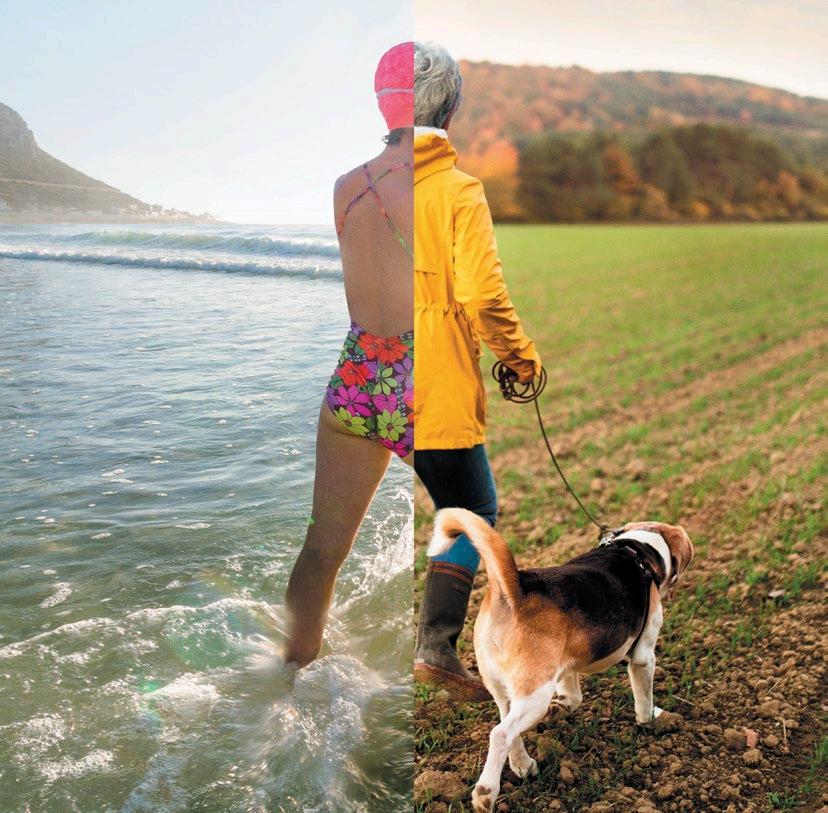





Response Premium by Doro connects seniors to loved ones or a fully-trained care team at the touch of a button on their mobile phone. So, they can get out there and keep doing what they love – and so can you.
Available at ee.co.uk/doro



































































































































































YES! I want to order the strictly limited 'WWII 75th Anniversary' complete set of 12 stunning strikes (Item-No. 944-461-5) – please choose: ❑ I would like to pay in 5 monthly interest-free instalments of £19.95 each. ❑ I would like to pay the full amount of £99.75 (instead of £599). There will be no further shipments and no further obligations. Please ensure you tick above if you prefer to pay in 5 instalments, otherwise we will debit the full amount. Your set will be sent POSTAGE FREE and with a guaranteed 60 days right of return.
print from our customer service. You can cancel the use of your details for marketing purposes at any time by sending a simple message to Windsor Mint, 11 Lowesmoor Wharf, Worcester, WR1 2RS.







years End of WWII 1945-2020 Layered with 24-carat gold • Finished with beautiful colour detailing • Strictly limited to only 9,999 sets worldwide • Highest minting quality 'PROOF' • Available exclusively from WINDSOR MINT £19.95 for just 5 instalments of or the full amount of £99.75 (instead of £599) Your FREE gifts: Give us a call! 01905 886220 Everyone ordering by phone will receive a stylish pen made with SWAROVSKI ® element as a FREE gift commitment,Noongoing nofurthershipments! Diameter: approx. 40 mm Common reverse Customer Service Offi ce: Windsor Mint, 11 Lowesmoor Wharf, Worcester, WR1 2RS • Dedicated Order Line: 01905 886220 Mon-Fri 8am - 11pm, Weekends 8am - 6pm. Email: service-uk@windsormint.co.uk WINDSOR MINT® is a brand name of HMK V AG. Responsible in terms of GDPR and Trade Partner: HMK V AG, Leubernstrasse 6, CH-8280 Kreuzlingen • An elegant wristwatch regularly sold for £39.95 • Luxurious wooden display case Exclusive 'WWII 75th Anniversary' complete set of twelve stunning strikes In commemoration of the deadliest war in world history All orders are subject to our Terms & Conditions, available on request or at www.windsormint.co.uk Your trade partner: HMK V AG, Leubernstrasse 6, CH-8280 Kreuzlingen Today’s Date Signature All orders are subject to availability and acceptance. Please allow up to 28 days for delivery. All items are sent under Windsor Mint’s 60-day NO OBLIGATION GUARANTEE. If you do not return any item(s) within 60 days you agree to pay the invoiced price. By placing an order you are confirming you are 18 years or older. All prices include VAT at the current rate. A credit check may be carried out. You may stop collecting at any time by simply notifying us. In order to send you information and special offers from us and selected other companies, we work with your data on the basis of the GDPR, Art 6 (1f), also with the help of trusted suppliers. You can find further information in our privacy statement, which you can see at any time on www.windsormint.co.uk or request in
Title First Name Surname Address City Postcode Please debit my card for this delivery. Name on card: Card Number: Expiry Date: My payment of
is
by: Mastercard Visa Cheque/postal order made payable to Windsor Mint WINDSOR MINT by HMK ®
CALL
AND
OVER £499.25 621-06 ★
£
made
NOW
SAVE













































 Vanessa Kirby and Ellen Burstyn in Pieces of A Woman
Vanessa Kirby and Ellen Burstyn in Pieces of A Woman















 by Lisa Fitterman
by Lisa Fitterman









































































































 Clockwise from above: A small shop at Homer Spit, at the tip of the Kenai Peninsula; sunset over Mt Susitna, viewed from Anchorage, Alaska's largest city; outdoor fun isn't hard to find in Homer, where there's plenty of snow; Talkeetna Roadhouse was built of timber in 1917; it's not uncommon to see
Clockwise from above: A small shop at Homer Spit, at the tip of the Kenai Peninsula; sunset over Mt Susitna, viewed from Anchorage, Alaska's largest city; outdoor fun isn't hard to find in Homer, where there's plenty of snow; Talkeetna Roadhouse was built of timber in 1917; it's not uncommon to see




















































 by Mike McCahill
by Mike McCahill



































































